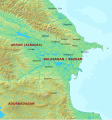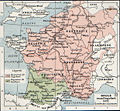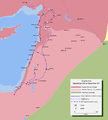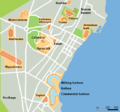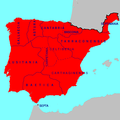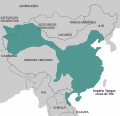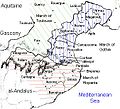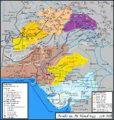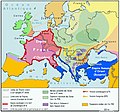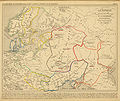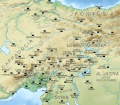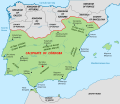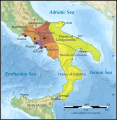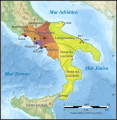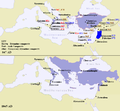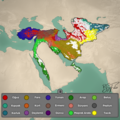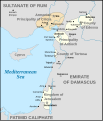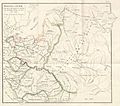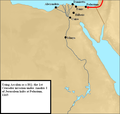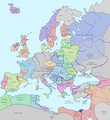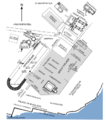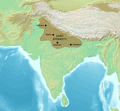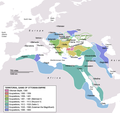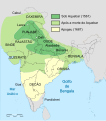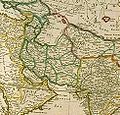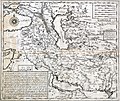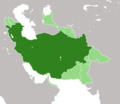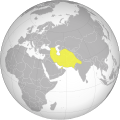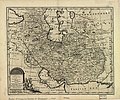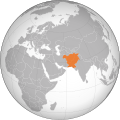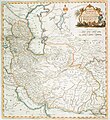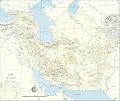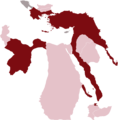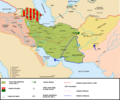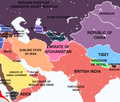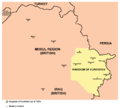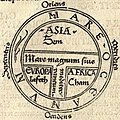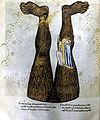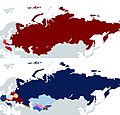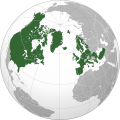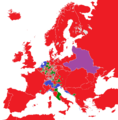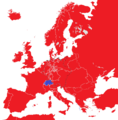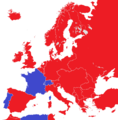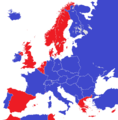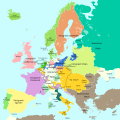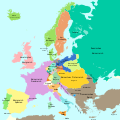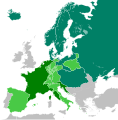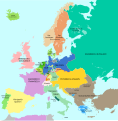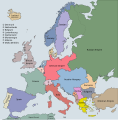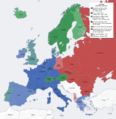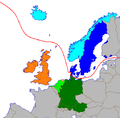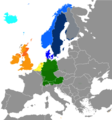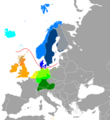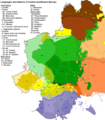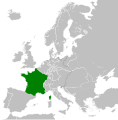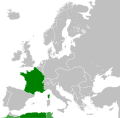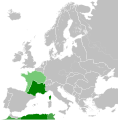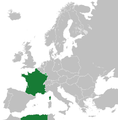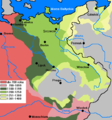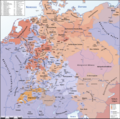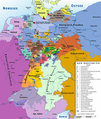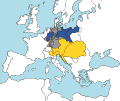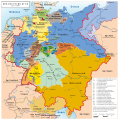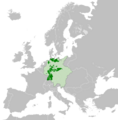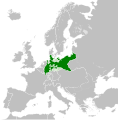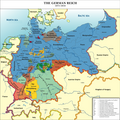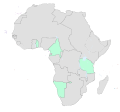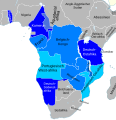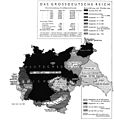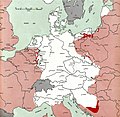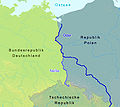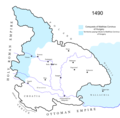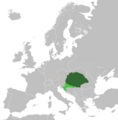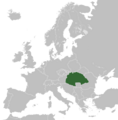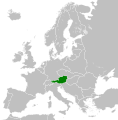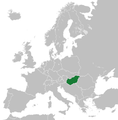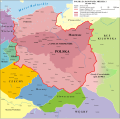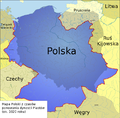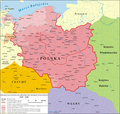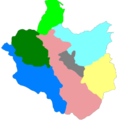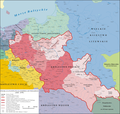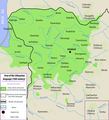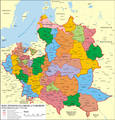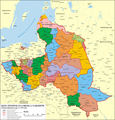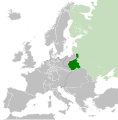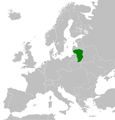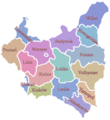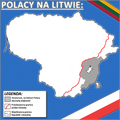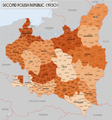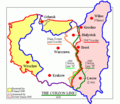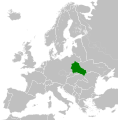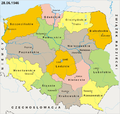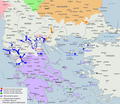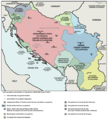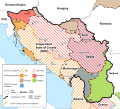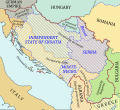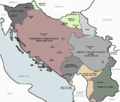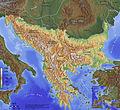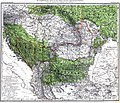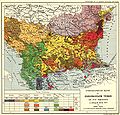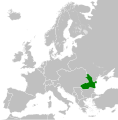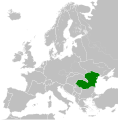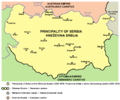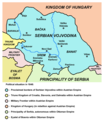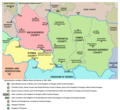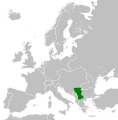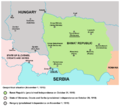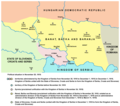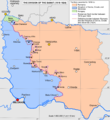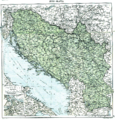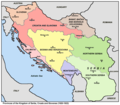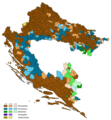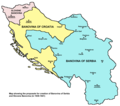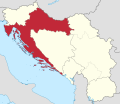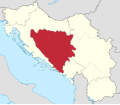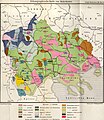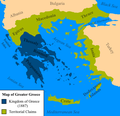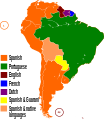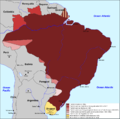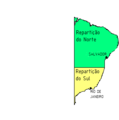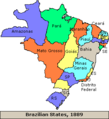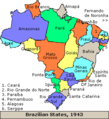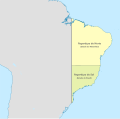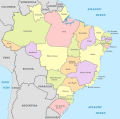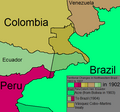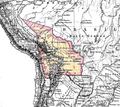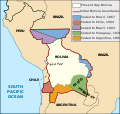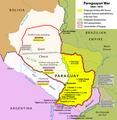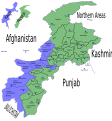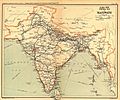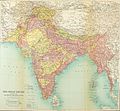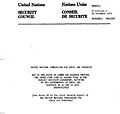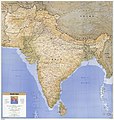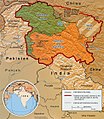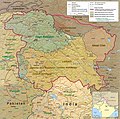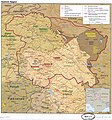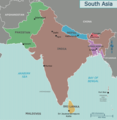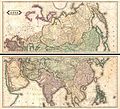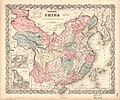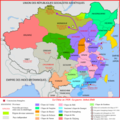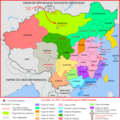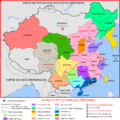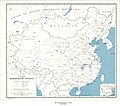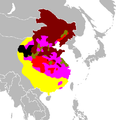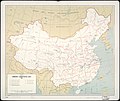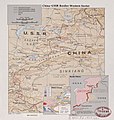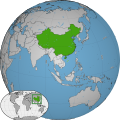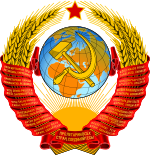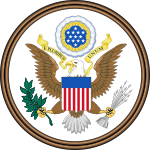Hello!My Contributions
Israel and Palestine
- Israel region relief.
- Israel region relief.
- Palestine region relief.
- Byzantine Diocese of the East (314–535/536) in 400 AD.
- Byzantine Diocese of the East (314–535/536) in 400 AD.
- Byzantine Diocese of the East (314–535/536) in 400 AD.
- Abbasid Bilad al-Sham (636–940s AD), Jund al-Urdunn (630s–1090s AD) and Jund Filastin (630s–1090s AD) in 850 AD.
- Abbasid Bilad al-Sham (636–940s AD), Jund al-Urdunn (630s–1090s AD) and Jund Filastin (630s–1090s AD) in 850 AD.
- Abbasid Bilad al-Sham (636–940s AD), Jund al-Urdunn (630s–1090s AD) and Jund Filastin (630s–1090s AD) in 850 AD.
- Old City of Jerusalem (1752).
- Old City of Jerusalem (1818).
- Old City of Jerusalem (1835).
- Ottoman Palestine (1841).
- Old City of Jerusalem (1841).
- Temple Mount (1841).
- Ottoman Palestine (1843).
- Old City of Jerusalem (1845).
- Ottoman Palestine (1851).
- Old City of Jerusalem (1858).
- Old City of Jerusalem (1862).
- Church of the Holy Sepulchre (1863).
- Old City of Jerusalem (1865).
- Temple Mount (1865).
- Old City of Jerusalem (1873).
- Old City of Jerusalem (1883).
- Temple Mount (1884).
- Beirut vilayet (1889).
- Beirut vilayet (1896).
- Old City of Jerusalem (1899).
- Beirut vilayet (1900).
- Old City of Jerusalem (1907).
- Population of Palestine (1910).
- Beirut vilayet (1915).
- Beirut vilayet (1915).
- Beirut vilayet (1915).
- Beirut vilayet (1915).
- Sykes–Picot Agreement (1916).
- Sykes–Picot Agreement (1916).
- Sykes–Picot Agreement (1916).
- Sykes–Picot Agreement (1916).
- Sykes–Picot Agreement (1916).
- Sykes–Picot Agreement (1916).
- Sharifian Solution (1918).
- Beirut vilayet (1918).
- Jerusalem (1918).
- Proposed borders of Mandatory Palestine (1916-1919).
- Proposed borders of Mandatory Palestine (1919).
- Southern Palestine (1919).
- Occupied Enemy Territory Administration (1917-1920).
- Occupied Enemy Territory Administration (1917-1920).
- Mandatory Palestine (1920).
- Mandatory Palestine (1920).
- Northern Palestine (1920).
- Mandatory Palestine (1921).
- Mandatory Palestine (1922).
- Temple Mount (1925).
- Mandatory Palestine (1931).
- Mandatory Palestine (1933).
- Old City of Jerusalem (1936).
- Old City of Jerusalem (1936).
- Church of the Holy Sepulchre (1936).
- Temple Mount (1936).
- Mount Zion (1936).
- Peel Commission (1937).
- Peel Commission (1937).
- Peel Commission (1937).
- Peel Commission (1937).
- Jewish proposal for the division of Jerusalem (1938).
- Mandatory Palestine (1944).
- Mandatory Palestine (1944).
- Mandatory Palestine (1944).
- Jewish Land Ownership in Mandatory Palestine (1944).
- Jewish and Arab Land Ownership in Mandatory Palestine (1945).
- Mandatory Palestine (1945).
- Population of Mandatory Palestine (1945).
- Mandatory Palestine (1946).
- Old City of Jerusalem (1946).
- Emirate of Transjordan (1946).
- Jewish and Arab Population of Mandatory Palestine (1947).
- Jewish Land Ownership in Mandatory Palestine (1947).
- Jewish Land Ownership in Mandatory Palestine (1947).
- Jewish Land Ownership in Mandatory Palestine (1947).
- Jewish Land Ownership in Mandatory Palestine (1947).
- Jerusalem (1947).
- Jerusalem (1947).
- Jerusalem (1947).
- Arab–Israeli conflict (1949).
- Palestine historical borders (132-1949).
- Israel (1949).
- Israel (1949).
- Al 'Awja Neutral Zone (1949).
- Al 'Awja Neutral Zone (1949).
- Old City of Jerusalem (1949).
- Suez War (1956).
- East Jerusalem (1961).
- Jordan (1965).
- West and East Jerusalem (1967).
- West and East Jerusalem (1967).
- West and East Jerusalem (1967).
- Six-Day War (1967).
- Six-Day War (1967).
- Six-Day War (1967).
- Six-Day War (1967).
- Six-Day War (1967).
- Six-Day War (1967).
- Allon Plan (1967).
- Yom Kippur War (1973).
- Yom Kippur War (1973).
- Yom Kippur War (1973).
- Yom Kippur War (1973).
- Old City of Jerusalem (1973).
- Golan Heights (1920-1974).
- Israel and Israeli-occupied territories (1982).
- Jordan (1984-1988).
- Golan Heights (1989).
- Golan Heights (1992).
- West Bank (1995).
- Hebron (1997).
- Gaza Strip (1999).
- Blue Line (withdrawal line) (2000).
- Blue Line (withdrawal line) (2000).
- Gaza Strip (2004).
- Jordan (2004).
- Jordan (2005).
- Golan Heights (2005).
- West Bank (2005).
- West Bank (2005).
- West Bank (2005).
- West Bank (2005).
- Gaza Strip (2005).
- Golan Heights (2006).
- Israel (2006).
- Israel and Israeli-occupied territories (2006).
- Palestine (2006).
- Palestine (2006).
- West Bank (2006).
- West Bank (2006).
- West Bank (2006).
- West Bank (2006).
- East Jerusalem (2006).
- East Jerusalem (2006).
- East Jerusalem (2006).
- Armenian Quarter (2006).
- Israel (2007).
- Palestine (2007).
- East Jerusalem (2007).
- East Jerusalem (2007).
- Church of the Holy Sepulchre (2008).
- West Bank (2008).
- Gaza Strip (2008).
- Gaza Strip (2008).
- Gaza Strip (2008).
- Gaza Strip (2009).
- Gaza Strip (2009).
- Old City of Jerusalem (2010).
- Christian Quarter (2010).
- Muslim Quarter (2010).
- Temple Mount (2010).
- Armenian Quarter (2010).
- Jewish Quarter (2010).
- Jerusalem (2011).
- Old City of Jerusalem (2011).
- West Bank (2011).
- West Bank (2011).
- West Bank (2011).
- Gaza Strip (2011).
- Gaza Strip (2011).
- Israel (2012).
- West Bank (2012).
- Gaza Strip (2012).
- Gaza Strip (2012).
- Gaza Strip (2012).
- Old City of Jerusalem (2013).
- Jerusalem (2014).
- Old City of Jerusalem (2014).
- West Bank (2014).
- Gaza Strip (2014).
- Gaza Strip (2014).
- Armenian Quarter and Jewish Quarter (2015).
- Jerusalem (2016).
- Old City of Jerusalem (2016).
- East Jerusalem (2016).
- West Bank (2017).
- East Jerusalem (2017).
- Israel and Israeli-occupied territories (2018).
- Gaza Strip (2018).
- East Jerusalem (2018).
- East Jerusalem (2018).
- Old City of Jerusalem (2018).
- Jericho (2018).
- Jerusalem (2019).
- West Bank (2019).
- Trump peace plan (2020).
- Trump peace plan (2020).
- Trump peace plan (2020).
- Trump peace plan (2020).
- Trump peace plan (2020).
- West Bank (2020).
- West Bank (2021).
- Old City of Jerusalem (2021).
- Muslim Populations of Israel (2022).
- Gaza Strip (2023).
- Israel–Hamas war (2023-present).
- Israel–Hamas war (2023-present).
- Israel–Hamas war (2023-present).
- Israel–Hamas war (2023-present).
- Israel–Hamas war (2023-present).
- Insurgency in the North Gaza Strip (2024-present).
- Israel (2024).
- Israel (2024).
- Israel (2024).
- Israel (2024).
- West Jerusalem (2024).
- Palestine (2024).
- Palestine (2024).
- Palestine (2024).
- Palestine (2024).
- East Jerusalem (2024).
- Old City of Jerusalem (2024).
- West Bank (2024).
- Gaza Strip (2024).
- Gaza Strip (2024).
- Gaza Strip (2024).
Russia and Soviet Union
- Expansion of Russia (862-1462)
- Expansion of Russia (1300-1462)
- Expansion of Russia (1390-1525)
- Expansion of Russia (1500-1700)
- Great Northern War (1700-1721)
- Great Northern War (1700-1721)
- Great Northern War (1700-1721)
- Treaty of Nystad (1721)
- Expansion of Russia (1547-1725)
- Russo-Swedish War (1741-1743)
- Treaty of Nystad (1721) and Treaty of Åbo (1743)
- Russo-Turkish War (1768-1774)
- Russo-Turkish War (1787-1791)
- Expansion of Russia (1300-1796)
- Expansion of Russia (1300-1796)
- Vyborg Governorate (1744-1812)
- Russo-Persian War (1804-1813)
- Russo-Persian War (1804-1813)
- Russo-Persian War (1804-1813)
- Finnish War (1808-1809)
- Finnish War (1808-1809)
- Finnish War (1808-1809)
- Finnish War (1808-1809)
- Finnish War (1808-1809)
- Finnish War (1808-1809)
- Finnish War (1808-1809)
- Russo-Turkish War (1828-1829)
- Crimean War (1853-1856)
- Crimean War (1853-1856)
- Expansion of Russia (1721–1864)
- Russian Empire (1867)
- Russian Empire (1867)
- Russo-Turkish War (1877-1878)
- Russo-Turkish War (1877-1878)
- Russian Empire (1848-1878)
- Expansion of Russia (1801–1881)
- Expansion of Russia (1423–1885)
- Russian Empire (1885)
- Expansion of Russia (1533-1896)
- Russian Empire ethnolinguistic map (1897)
- Russian Empire ethnic map (1898)
- Russian Empire (1910)
- Expansion of Russia (1613-1914)
- Russian Empire (1914)
- Russian Empire (1914)
- Russian Empire (1914)
- Russian Empire (1914)
- Russian Empire (1914)
- Russian Empire languages (1914)
- WWI Eastern Front (1914-1918)
- Russian Republic (1917-1918)
- Russian Republic (1917-1918)
- Russian Republic (1917-1918)
- Treaty of Brest-Litovsk (1918)
- Treaty of Brest-Litovsk (1918)
- Treaty of Brest-Litovsk (1918)
- Treaty of Brest-Litovsk (1918)
- Post-imperial Russia (1917-1920)
- Soviet Russia (1920)
- Treaty of Tartu (1920)
- Expansion of Russia (1800-1921)
- Soviet Russia (1921)
- Russian SFSR (1922)
- Russian famine of 1921–1922
- Russian Civil War (1917-1923)
- Russian Civil War (1917-1923)
- Russian Civil War (1917-1923)
- Russian Civil War (1917-1923)
- Russian Civil War (1917-1923)
- Russian SFSR (1924)
- Russian SFSR (1929)
- Russian SFSR (1936)
- Soviet Union (1936)
- Soviet Union (1937)
- Finnish-Soviet border (1939)
- Russian SFSR (1940)
- Molotov-Ribbentrop Pact (1939-1940)
- Finnish-Soviet border (1940)
- Winter War (1939-1940)
- Winter War (1939-1940)
- Winter War (1939-1940)
- Winter War (1939-1940)
- Winter War (1939-1940)
- Winter War (1939-1940)
- Winter War (1939-1940)
- Winter War (1939-1940)
- Winter War (1939-1940)
- Winter War (1939-1940)
- Winter War (1939-1940)
- Winter War (1939-1940)
- Winter War (1939-1940)
- Winter War (1939-1940)
- Winter War (1939-1940)
- Winter War (1939-1940)
- Winter War (1939-1940)
- Winter War (1939-1940)
- Winter War (1939-1940)
- Winter War (1939-1940)
- Rybachy Peninsula (1939-1940)
- Rybachy Peninsula
- Repola-Porajarvi (1939-1940)
- Finnish Democratic Republic (1939-1940)
- Karelo-Finnish Soviet Socialist Republic (1940-1956)
- Finnish Karelia (1939-1940)
- East and West Karelias (1939-1940)
- Karelia
- Karelia
- Ladoga Karelia (1939-1940)
- Karelian Isthmus (1939-1940)
- Hanko Peninsula (1939-1940)
- Hanko Peninsula (1939-1940)
- Moscow Peace Treaty (1940)
- Soviet Blockade of Estonia (1940)
- Molotov-Ribbentrop Pact (1939-1941)
- Soviet Union ethnic map (1941)
- Operation Barbarossa (1941)
- Eastern Front (1941-1942)
- Eastern Front (1942)
- Planned partition of the Soviet Union (1942)
- Planned partition of the Soviet Union (1942)
- Planned partition of the Soviet Union (1942)
- Planned partition of the Soviet Union (1942)
- Eastern Front (1942-1943)
- Eastern Front (1943)
- Eastern Front (1943-1944)
- Continuation War (1941-1944)
- Continuation War (1941-1944)
- Continuation War (1941-1944)
- Continuation War (1941-1944)
- Continuation War (1941-1944)
- Continuation War (1941-1944)
- Continuation War (1941-1944)
- Continuation War (1941-1944)
- Continuation War (1941-1944)
- Continuation War (1941-1944)
- Continuation War (1941-1944)
- Continuation War (1941-1944)
- Porkkala Naval Base (1944)
- Moscow Armistice (1944)
- Lapland War (1944-1945)
- Eastern Front (1945)
- "Victory Banner #5" (150th Rifle, Order of Kutuzov 2nd class, Idritsa Division, 79th Rifle Corps, 3rd Shock Army, 1st Belorussian Front), raised on the roof of the Reichstag building (1945)
- Sakhalin and the Kurile Islands (1875–1945)
- Expansion of Russia (1300–1945)
- Soviet Union (1945-1946)
- Soviet Empire (1960)
- Finnish-Soviet border (1967)
- Soviet Union ethnic map (1970)
- Soviet Union population density (1982)
- Soviet Union (1989)
- Soviet Union (1989)
- Soviet Union (1989)
- Soviet Union (1989)
- Soviet Union (1989)
- Soviet Union (1989)
- Soviet Union (1989)
- Soviet Union (1989)
- Soviet Union (1989)
- Soviet Union (1989)
- Warsaw Pact (1989)
- Near abroad (1809-1991)
- Russian SFSR (1956-1991)
- Evolution of the Republics of the Soviet Union (1922-1991)
- Emblems of the Soviet Republics and Post-Soviet states
- Soviet Caucasus (1991)
- Caucasus (1990-1994)
- Caucasus ethnic map (1995)
- Autonomous areas of Russia (1996)
- BRIC (2009)
- Russia (2013)
- Russia (2013)
- Russia (2013)
- Russia (2013)
- Russia (2013)
- Russia (2013)
- Russia (2013)
- Russia (2013)
- Russia (2013)
- Russia (2013)
- Russia (2013)
- Russia (2013)
- Russia (2013)
- Russia (2013)
- Russia (2013)
- Russia (2013)
- Russia (2013)
- Russia (2013)
- Republics of Russia (2013)
- Russia (2014)
- Russia (2014)
- Russia (2014)
- Russia (2014)
- Russia (2014)
- Russia (2014)
- Russia (2014)
- Republics of Russia (2014)
- Republics of Russia (2014)
- Republics of Russia (2014)
- Republics of Russia (2014)
- Federal subjects of Russia (2014)
- Federal subjects of Russia (2014)
- Russian-occupied territories (2014)
- Russian-occupied territories (2014)
- CSTO (2014)
- CIS (2014)
- Wagner Group rebellion (2023)
- Wagner Group rebellion (2023)
- BRICS (2023)
- BRICS and applicants (2023)
- Russia (2024)
- Russia (2024)
- Russia (2024)
- Russia (2024)
- Russia (2024)
- Federal subjects of Russia (2024)
- Russian language (2024)
- Russian language (2024)
- Russian language (2024)
- Russian-occupied territories (2024)
- Russian-occupied territories (2024)
- Caucasus (2024)
- Caucasus (2024)
- Wagner Group activities (2014-2024)
- BRICS (2024)
- BRICS and applicants (2024)
- Republic of Crimea (2014-present)
- Luhansk People's Republic (2014-present)
- Donetsk People's Republic (2014-present)
- Russian occupation of Zaporizhzhia Oblast (2022-present)
- Russian occupation of Kherson Oblast (2022-present)
Ukraine
- East Slavic tribes (700-850).
- Route from the Varangians to the Greeks (700-1000)
- Route from the Varangians to the Greeks (700-1000)
- Kyivan Rus' (1054)
- Kyivan Rus' (1015-1113)
- Principalities of Kyivan Rus' (1054-1132).
- Kyivan Rus' (1220-1240).
- Principality of Halych (1240)
- Principality of Halych (1240)
- Little Rus' (1347)
- Kingdom of Galicia–Volhynia (1199-1349)
- Kingdom of Galicia–Volhynia (1245-1349).
- Grand Duchy of Lithuania, Rus' (Ukraine) and Samogitia (1386-1434).
- Little Rus' (1600)
- Cossack Hetmanate (1649–1654)
- Cossack Hetmanate (1649–1654)
- Cossack Hetmanate (1654)
- Polish–Lithuanian–Ruthenian Commonwealth/ Commonwealth of Three Nations (1658).
- Russian Ukraine (1667)
- Russian Ukraine (1667)
- Ottoman Ukraine (1672)
- Russian Ukraine (1720)
- Russian Ukraine (1740–1750)
- Ukrainian Cossack Hetmanate and Zaporozhian Cossacks under rule of Russian Empire (1751).
- Russian Ukraine (1727-1768)
- Russian Ukraine (1711-1775)
- Russian Ukraine (1799)
- Russian Ukraine (1654-1812)
- Novorossiya (1855)
- Galicia (1897)
- Ukrainian language in the Russian Empire (1897)
- Russian Ukraine (1900)
- Kuban (1900)
- Russian Ukraine (Little Russia; South Russia; Volhynia and Podolia) (1904)
- Galicia (1911)
- Ukrainian language (1915)
- Ukrainian People's Republic (1917-18/1918-21)
- Ukrainian People's Republic (1917-18/1918-21)
- Ukrainian People's Republic (1917-18/1918-21)
- Ukrainian People's Republic (1917-18/1918-21)
- Proposition of partision of East Galicia by Joseph Barthelemy
- West Ukrainian People's Republic (1918-1919)
- West Ukrainian People's Republic (1918-1919)
- Ukrainian State (1918)
- Ukrainian State (1918)
- Ukrainian State (1918)
- Ukrainian State (1918)
- Ukrainian State (1918)
- Ukrainian State (1918)
- Ukrainian State (1918)
- Ukrainian State (1918)
- Ukrainian State (1918)
- Ukrainian State (1918)
- Ukrainian State (1918)
- Map of Ukraine presented by Ukrainian delegation on Paris Peace Conference (1919)
- Map of Ukraine presented by Ukrainian delegation on Paris Peace Conference (1919)
- Ukrainian postcard (1919)
- Memorandum to the government of the United States on the recognition of the Ukrainian People’s Republic (1920)
- Ukrainian population (1920)
- Donbas (1921)
- Ukrainian SSR (1921)
- Ukrainian SSR (1921)
- Ukrainian SSR (1922)
- Ukrainian SSR (1925)
- Ukrainian language (1897-1926)
- Ukrainians in Kuban (1926)
- Ukrainian population (1927)
- Ukrainian SSR (1928)
- Evolution of Ukrainian SSR (1917-1928)
- Ukrainian SSR (1929-1930)
- Ukrainian SSR (1932-1937)
- Ukrainian SSR (1937-1938)
- Ukrainian SSR (1939-1940)
- Ukrainian SSR (1939)
- Reichskommissariat Ukraine (1941-1944)
- Reichskommissariat Ukraine (1941-1944)
- Ukrainian SSR (1940-1945)
- Ukrainian SSR (1946-1954)
- Evolution of Ukraine (1503-1954)
- Evolution of Ukrainian SSR (1918-1954)
- Ukrainian SSR (1954-1991)
- Evolution of Ukraine (1917-1991)
- Ukraine Native Languages Census (2001)
- Russians in Ukraine (2001)
- Ukraine (1991-2014)
- Ukraine (1991-2014)
- Ukraine (1991-2014)
- Ukraine (1991-2014)
- Ukraine (1991-2014)
- Ukraine (1991-2014)
- Ukraine (1991-2014)
- Ukraine (1991-2014)
- Ukraine (1991-2014)
- Ukraine (1991-2014)
- Ukraine (1991-2014)
- Donbas region (1991-2014)
- Black Sea (1991-2014)
- Black Sea (1991-2014)
- Ukraine (2014)
- Ukraine (2014)
- Ukraine (2014)
- Novorossiya project (2014-2015)
- Ukraine (2014-2022)
- Ukraine (2014-2022)
- Ukraine (2014-2022)
- Ukraine (2014-2022)
- Ukraine (2014-2022)
- Ukraine (2014-2022)
- Ukraine (2014-2022)
- Donbas region (2015-2022)
- Ukraine (2020-2022)
- Ukrainian language (2024)
- Ukraine and NATO (2024)
- Russian invasion of Ukraine (2022-present)
- Russian invasion of Ukraine (2022-present)
- Russian invasion of Ukraine (2022-present)
- Countries supplying military equipment to Ukraine during the Russian invasion of Ukraine (2022-present)
Armenia, Azerbaijan and Georgia
- Iranian Karabakh (1501).
- Iranian Armenia (1663-1724).
- Iranian Armenia (1740).
- Iranian Armenia (1740).
- Iranian Armenia (1740).
- Iranian Armenia (1800).
- Iranian Caucasus (1801).
- Iranian Caucasus (1801).
- Iranian Caucasus (1808).
- Treaty of Gulistan (1813).
- Treaty of Gulistan (1813).
- Caucasus (1833).
- Russian Armenia (1828-1840).
- Crimean War in Caucasus (1853-1856).
- Russo-Turkish War in Caucasus (1877).
- Armenian population (1880).
- Armenian population (1896).
- Armenian population (1896).
- Armenian population (1896-1897).
- Caucasus (1897).
- Six Vilayets (1900).
- Armenian claims (1901).
- Armenian population (1905).
- Armenian dialects (1909).
- Ottoman Anatolia and Caucasus (1909).
- Ottoman Anatolia and Caucasus (1910).
- Ottoman Anatolia and Caucasus (1910).
- Six Vilayets ethnic groups (1909).
- Kars Oblast (1913).
- Erivan Oblast (1913).
- Elisabethpol Oblast (1913).
- Armenian population (1914).
- Armenian population (1914).
- Armenia, divided between the Russian and Ottoman empires (1914).
- Armenian population (1914-2024).
- Armenian population (1914-2024).
- Russian Armenia (1914).
- Turkish claims (1914-1920).
- Armenian Genocide (1915-1917).
- Armenian Genocide (1915-1917).
- Sykes–Picot Agreement (1916).
- Sykes–Picot Agreement (1916).
- Sykes–Picot Agreement (1916).
- Caucasus Front (1916).
- Caucasus Front (1916).
- Caucasus Front (1916).
- Caucasus Front (1916-1917).
- Caucasus Front (1917).
- Ottoman Anatolia and Caucasus (1917).
- Caucasus (1918).
- Treaty of Batum (1918).
- Southwestern Caucasus (1918-1919).
- Armenia (1919).
- Armenia (1919).
- Armenian claims (1919).
- Azerbaijan (1919).
- Azerbaijan (1918-1920).
- Azerbaijan (1918-1920).
- Treaty of Sèvres (1920).
- Treaty of Sèvres (1920).
- Treaty of Sèvres (1920).
- Treaty of Sèvres (1920).
- Treaty of Sèvres (1920).
- Armenia (1918-1920).
- Armenian claims (1920).
- Armenian claims (1920).
- Armenian claims (1920).
- Armenian claims (1920).
- Armenian claims (1920).
- Armenian claims (1920).
- Armenian claims (1920).
- Turkish-Armenian War (1920).
- Georgia (1920).
- Georgia (1918-1921).
- Turkish claims (1921).
- Treaty of Kars (1921).
- Treaty of Kars (1921).
- Soviet Georgia (1922).
- Treaty of Lausanne (1923).
- Soviet Caucasus (1926-1929).
- Soviet Caucasus (1928).
- Soviet Georgia (1939).
- Armenian and Georgian claims (1946)
- Georgian claims (1946)
- Ottoman/Turkish and Russian/Soviet Caucasus (1856-1951)
- Armenian and Georgian claims (1945-1953)
- Soviet Georgia (1944-1955).
- Soviet Caucasus (1957-1991).
- Soviet Georgia (1957-1991).
- Soviet Armenia (1989).
- Nagorno-Karabakh ethnic map (1989).
- Nagorno-Karabakh ethnic map (1989).
- Caucasus ethnic map (1994-2020).
- Republic of Artsakh (1994-2020).
- Republic of Artsakh (1994-2020).
- Republic of Artsakh (1994-2020).
- Republic of Artsakh (1994-2020).
- Republic of Artsakh (1994-2020).
- Republic of Artsakh (1994-2020).
- Republic of Artsakh (1994-2020).
- Republic of Artsakh (1994-2020).
- Republic of Artsakh (1994-2020).
- Republic of Artsakh (1994-2020).
- Republic of Artsakh (1994-2020).
- Republic of Artsakh (1994-2020).
- Armenia and Republic of Artsakh ethnic map (1994-2020).
- Republic of Artsakh (2020).
- Second Nagorno-Karabakh War (2020).
- Second Nagorno-Karabakh War (2020).
- Second Nagorno-Karabakh War (2020).
- Second Nagorno-Karabakh War (2020).
- Second Nagorno-Karabakh War (2020).
- Lachin Corridor (2020-2023).
- Nagorno-Karabakh region (1994-2023).
- Nagorno-Karabakh region (1994-2023).
- Republic of Artsakh (1994-2023).
- Azerbaijan and Republic of Artsakh (2020-2023).
- Republic of Artsakh (2020-2023).
- Republic of Artsakh (2020-2023).
- Republic of Artsakh (2020-2023).
- Republic of Artsakh (2020).
- Republic of Artsakh (2020).
- Republic of Artsakh (2021).
- Republic of Artsakh (2021-2022).
- Republic of Artsakh (2022).
- Azerbaijani offensive in Nagorno-Karabakh (2023).
- Caucasus (2024).
- Caucasus (2024).
- Caucasus (2024).
- Caucasus (2024).
- Caucasus (2024).
- Armenia and Azerbaijan (2024).
- Armenia and Azerbaijan (2024).
- Armenia and Azerbaijan (2024).
- Azerbaijan (2024).
- Azerbaijan (2024).
- Azerbaijan (2024).
- Azerbaijan (2024).
- Azerbaijan (2024).
- Azerbaijani language distribution (2024).
- Oghuz Turkic Languages (2024).
- Turkic Languages (2024).
- Turkic people (2024).
- Armenia (2024).
- Armenia (2024).
- Armenia (2024).
- Armenian language distribution (2024).
- Armenian claims (2024).
- Armenia and Turkey (2024).
- Armenia and Turkey (2024).
- Georgia (2024).
- Azerbaijan and Turkey (2024).
- Nakhichevan (Azerbaijan) and Turkey (2024).
- Baku pipelines (2024).
- Caucasus and Anatolia (2024).
- Caucasus and Anatolia (2024).
Balkans
- Balkans (1801)
- Balkans (1812)
- Balkans (1853)
- Balkans (1876)
- Constantinople Conference (1876-1877)
- Constantinople Conference (1876-1877)
- Treaty of San Stefano (1878)
- Treaty of San Stefano (1878)
- Treaty of Berlin (1878)
- Treaties of San Stefano and Berlin (1878)
- Treaties of San Stefano and Berlin (1878)
- Treaties of San Stefano and Berlin (1878)
- Treaties of San Stefano and Berlin (1878)
- Treaties of San Stefano and Berlin (1878)
- Treaty of Berlin (1878)
- Treaty of Berlin (1878)
- Balkans (1881)
- Balkans (1885)
- Balkans (1891)
- Balkans (1891)
- Balkans (1899)
- Balkans (1905)
- Balkans (1905)
- Balkans (1910)
- Balkans (1912)
- Balkans (1912)
- Balkans (1913)
- Balkans (1913)
- Balkans (1913)
- Balkan Wars (1912-1913)
- Balkan Wars (1912-1913)
- Balkans (1913)
- Balkans (1913)
- Balkans (1913)
Mediterranean Basin, Near East and Middle East
- Asia.
- Mediterranean Sea subdivisions.
- Mediterranean Sea relief.
- Mediterranean Sea relief.
- Mediterranean Sea political.
- Mediterranean Sea political.
- Mediterranean Sea major cities.
- Mediterranean Sea populated places.
- Mediterranean Basin forests.
- Mediterranean Basin forests.
- Mediterranean Basin olive trees.
- Mediterranean Basin olive trees.
- Ancient Near East.
- Ancient Near East.
- Greece region relief.
- Greece region relief.
- Ancient Anatolia.
- Ancient Anatolia.
- Turkey region relief.
- Turkey region relief.
- Ancient Armenian Highlands.
- Lake Sevan region relief.
- Lake Sevan region relief.
- Lake Sevan region relief.
- Armenia region relief.
- Armenia region relief.
- Iran region relief.
- Iran region relief.
- Iran region relief.
- Iran region relief.
- Iran region relief.
- Iran region relief.
- Iran region relief.
- Iran region relief.
- Iran region relief.
- Iran region relief.
- Iran population.
- Iran.
- Iran.
- Iran.
- Iran.
- Iran.
- Iran.
- Iran.
- Iran.
- Iran.
- Iran.
- Iran.
- Iran.
- Iran.
- Iran.
- Iran.
- Iran.
- Iran.
- Iran.
- Ancient Mesopotamia.
- Iraq region relief.
- Iraq region relief.
- Iraq.
- Iraq.
- Iraq.
- Ancient Levant.
- Syria region relief.
- Syria region relief.
- Israel region relief.
- Egypt region relief.
- Egypt region relief.
Modern Languages, Nations and Religions
- Primary Human Languages
- Primary Human Languages
- Primary Human Languages
- Primary Human Languages
- Primary Human Languages
- Primary Human Languages
- Primary Human Languages
- Indo-European Languages
- Indo-European Languages distribution
- Indo-European Languages in Eurasia
- Germanic Languages distribution
- Germanic Languages distribution
- Germanic Languages distribution
- English Language distribution
- English Language distribution
- English Language distribution
- English Language distribution
- English Language distribution
- German Language distribution
- German Language distribution
- Swedish Language distribution
- Romance Languages distribution
- Romance Languages distribution
- French Language distribution
- French Language distribution
- Ibero-Romance Languages distribution
- Spanish Language distribution
- Spanish Language distribution
- Spanish Language distribution
- Spanish vs Castellano
- Portuguese Language distribution
- Portuguese Language distribution
- Portuguese Language distribution
- Italian Language distribution
- Italian Language distribution
- Romanian Language distribution
- Slavic Languages distribution
- Slavic Languages distribution
- Russian Language distribution
- Russian Language distribution
- Russian Language distribution
- Ukrainian Language distribution
- Belarusian Language distribution
- Polish Language distribution
- Polish Language distribution
- Serbo-Croatian Language distribution
- Bulgaro-Macedonian Language distribution
- Macedonian Language distribution
- Albanian Language distribution
- Greek Language distribution
- Armenian Language distribution
- Indo-Iranian Languages distribution
- Iranian Languages distribution
- Iranian Languages distribution
- Iranian Languages distribution
- Iranian Languages distribution
- Iranian Languages distribution
- Iranian Languages distribution
- Iranian Languages distribution
- Iranian Languages distribution
- Iranian Languages distribution
- Iranian Languages distribution
- Iranian Languages distribution
- Kurdish Language distribution
- Persian Language distribution
- Persian Language distribution
- Persian Language distribution
- Persian Language distribution
- Pashto Language distribution
- Balochi Language distribution
- Ethnolinguistic groups of Africa
- Ethnolinguistic groups of Africa
- Afroasiatic Languages distribution
- Afroasiatic Languages distribution
- Afroasiatic Languages distribution
- Semitic Languages in Asia
- Hebrew Language distribution
- Arabic Language distribution
- Arabic Language distribution
- Arabic Language distribution
- Arabic Language distribution
- Arabic Language distribution
- Arabic Language distribution
- Arabic Language distribution
- Berber Languages distribution
- Altaic and Uralic Languages distribution
- Altaic Languages distribution
- Turkic Languages distribution
- Turkic Languages distribution
- Turkic Languages distribution
- Turkic Languages distribution
- Turkic Languages distribution
- Turkic Languages distribution
- Oghuz Turkic Languages distribution
- Turkish Language distribution
- Azerbaijani Language distribution
- Kazakh Language distribution
- Uyghur Language distribution
- Uralic Languages distribution
- Hungarian Language distribution
- Estonian Language distribution
- Finnish Language distribution
- Karelian Language distribution
- Uralic Languages distribution
- Writing Systems
- Writing Systems
- Writing Systems
- Writing Systems
- Writing Systems
- Writing Systems
- Writing Systems
- Writing Systems
- Writing Directions
- Latin Script distribution
- Cyrillic Script distribution
- Cyrillic Script distribution
- Arabic Script distribution
- Arabic Script distribution
- Prevailing world religions
- Prevailing world religions
- Christianity in the world
- Christianity in the world
- Christianity in the world
- Christianity and Islam
- Islam in the world
- Islam in the world
- Islam in the world
- Islamic schools of law
- Global North and Global South
- Brandt Line
- Clash of Civilizations
- Clash of Civilizations
- Western World
- Western World
- British and French empires (1920)
- British and French overseas territories (2024)
- Fashoda Incident (1898)
- Scramble for Africa (1880-1913)
- Colonial Africa (1913)
- Colonial Africa (1939)
- British Decolonisation in Africa (1922-1968)
- Modern Empires
- Largest empires in history
- Size of Empires
Ancient Empires (3500-550 BC)
- Indo-European languages in 3500 BC.
- Near East in 2600 BC.
- Indo-European languages in 2500 BC.
- Near East in 2500 BC.
- Timeline of Semitic languages (2500 BC-2024 AD).
- Near East in 2400 BC.
- Near East in 2300 BC.
- Near East in 2300 BC.
- Near East in 2200 BC.
- Near East in 2100 BC.
- Near East in 2000 BC.
- Near East in 1900 BC.
- Near East in 1800 BC.
- Kingdom of Upper Mesopotamia (1809-1776 BC) in 1776 BC.
- Old Babylonian Empire (1894-1595 BC) in 1792-1750 BC.
- Near East in 1700 BC.
- Near East in 1600 BC.
- Indo-European languages in 1500 BC.
- Near East in 1500 BC.
- Near East in 1450 BC.
- New Kingdom of Egypt (1550-1069 BC) in 1450 BC.
- New Kingdom of Egypt (1550-1069 BC) in 1450 BC.
- New Kingdom of Egypt (1550-1069 BC) in 1450 BC.
- Near East in 1400 BC.
- Near East in 1400 BC.
- Near East in 1400 BC.
- Levant in 1400 BC.
- Mesopotamia in 1400 BC.
- Mesopotamia in 1400 BC.
- Hittite Empire (1650-1190 BC) in 1350-1322 BC.
- Hittite Empire (1650-1190 BC) in 1350-1322 BC.
- Near East in 1300 BC.
- Hittite Empire (1650-1190 BC) in 1300 BC.
- Near East in 1225-1216 BC.
- Middle Assyrian Empire (1363-912 BC) in 1305–1207 BC.
- Near East in 1200 BC.
- Bronze Age Collapse in 1200 BC.
- Anatolia in 1200 BC.
- Mesopotamia in 1200 BC.
- Canaan in 1200 BC.
- Trojan War (1260-1180/1194-1184 BC).
- Trojan War (1260-1180/1194-1184 BC).
- Trojan War (1260-1180/1194-1184 BC).
- Trojan War (1260-1180/1194-1184 BC).
- Trojan War (1260-1180/1194-1184 BC).
- Trojan War (1260-1180/1194-1184 BC).
- Middle Assyrian Empire (1363-912 BC) in 1132–1115 BC.
- Nordic Bronze Age (2000/1750-500 BC) in 1100 BC.
- Near East in 1100 BC.
- Promised Land in 1200-1050 BC.
- Promised Land in 1200-1050 BC.
- Twelve Tribes of Israel in 1200-1050 BC.
- Kingdom of Israel (united monarchy) (1047-930 BC) in 1020 BC.
- Kingdom of Israel (united monarchy) (1047-930 BC) in 1020 BC.
- Near East in 1000 BC.
- Near East in 1000 BC.
- Near East in 900 BC.
- Middle Assyrian Empire (1363-912 BC) and Neo-Assyrian Empire (911-609 BC) in 950–880 BC.
- Neo-Assyrian Empire (911-609 BC) in 910–860 BC.
- Urartu (860-590 BC) in 860-840 BC.
- Urartu (860-590 BC) in 860-840 BC.
- Fertile Crescent in 830 BC.
- Kingdom of Israel (Samaria) (930-720 BC) and Kingdom of Judah (930-587 BC) in 830 BC.
- Kingdom of Israel (Samaria) (930-720 BC) and Kingdom of Judah (930-587 BC) in 830 BC.
- Kingdom of Israel (Samaria) (930-720 BC) and Kingdom of Judah (930-587 BC) in 830 BC.
- Kingdom of Israel (Samaria) (930-720 BC) and Kingdom of Judah (930-587 BC) in 830 BC.
- Middle Assyrian Empire (1363-912 BC) and Neo-Assyrian Empire (911-609 BC) in 860–820 BC.
- Near East in 800 BC.
- Urartu (860-590 BC) in 743 BC.
- Neo-Assyrian Empire (911-609 BC) in 745-727 BC.
- Urartu (860-590 BC) in 715-713 BC.
- Near East in 700 BC.
- Kingdom of Kush (1070 BC-550 AD) in 700 BC.
- Kingdom of Kush (1070 BC-550 AD) in 700 BC.
- Neo-Assyrian Empire (911-609 BC) in 671 BC.
- Neo-Assyrian Empire (911-609 BC) in 671 BC.
- Neo-Assyrian Empire (911-609 BC) in 671 BC.
- Neo-Assyrian Empire (911-609 BC) in 669-631 BC.
- Translatio imperii (911 BC-1922 AD).
- West Asia in 600 BC.
- Near East in 600 BC.
- Scythians in 680-600 BC.
- Kingdom of Lydia (1200-546 BC), Neo-Babylonian Empire (626-539 BC), Twenty-sixth Dynasty of Egypt (664-525 BC) and Median Empire (678-549 BC) in 600 BC.
- Kingdom of Lydia (1200-546 BC), Neo-Babylonian Empire (626-539 BC), Twenty-sixth Dynasty of Egypt (664-525 BC) and Median Empire (678-549 BC) in 600 BC.
- Neo-Babylonian Empire (626-539 BC) and Median Empire (678-549 BC) in 600 BC.
- Neo-Babylonian Empire (626-539 BC) in 600 BC.
- Median Empire (678-549 BC) in 600 BC.
- Median Empire (678-549 BC) in 600 BC.
- Median Empire (678-549 BC) in 600 BC.
- Median Empire (678-549 BC) in 600 BC.
- Median Empire (678-549 BC) in 600 BC.
- Median Empire (678-549 BC) in 600 BC.
- Median Empire (678-549 BC).
Ancient Empires (550-300 BC)
- Greek colonisation in 550 BC.
- Greek colonisation in 550 BC.
- Greek colonisation in 550 BC.
- Greek colonisation in 550 BC.
- Greek colonisation in 550 BC.
- Etruscan civilization (900-27 BC) and Greek colonisation in 550 BC.
- Greek colonisation in 550 BC.
- Greek colonisation in 550 BC.
- Greek colonisation in 550 BC.
- Greek colonisation in 550 BC.
- Greek colonisation in 550 BC.
- Greek colonisation in 550 BC.
- Greek colonisation in 550 BC.
- Greek colonisation in 550 BC.
- Dardanelles in 550 BC.
- Kingdom of Lydia (1200-546 BC) in 547 BC.
- Kingdom of Lydia (1200-546 BC) in 547 BC.
- Reconstruction of Anaximander's (610-546 BC) map.
- Neo-Babylonian Empire (626-539 BC) in 540 BC.
- Neo-Babylonian Empire (626-539 BC) in 540 BC.
- Babylon in 540 BC.
- Achaemenid Empire (550-330 BC), Neo-Babylonian Empire (626-539 BC) and Twenty-sixth Dynasty of Egypt (664-525 BC) in 540 BC.
- Achaemenid Empire (550-330 BC) in 550-539 BC.
- Fall of Babylon in 540-539 BC.
- Mesopotamia in 539 BC.
- Achaemenid Empire (550-330 BC) and Twenty-sixth Dynasty of Egypt (664-525 BC) in 525 BC.
- Peloponnesian League (550-366 BC) in 506 BC.
- Afroasiatic languages in 500 BC.
- Indo-European languages in 500 BC.
- Etruscan civilization (900-27 BC) in 750-500 BC.
- Etruscan civilization (900-27 BC) and Roman Republic (509-27 BC) in 500 BC.
- Etruscan civilization (900-27 BC) and Roman Republic (509-27 BC) in 500 BC.
- Italic languages in 500 BC.
- Italic languages in 500 BC.
- Roman Republic (509-27 BC) in 500 BC.
- West Asia in 500 BC.
- Near East in 500 BC.
- Achaemenid Empire (550-330 BC) in 500 BC.
- Achaemenid Empire (550-330 BC) in 500 BC.
- Achaemenid Empire (550-330 BC) in 500 BC.
- Achaemenid Empire (550-330 BC) in 500 BC.
- Achaemenid Empire (550-330 BC) in 500 BC.
- Achaemenid Empire (550-330 BC) in 500 BC.
- Achaemenid Empire (550-330 BC) in 500 BC.
- Achaemenid Empire (550-330 BC) in 500 BC.
- Achaemenid Empire (550-330 BC) in 500 BC.
- Achaemenid Empire (550-330 BC) in 500 BC.
- Achaemenid Empire (550-330 BC) in 500 BC.
- Achaemenid Empire (550-330 BC) in 500 BC.
- Achaemenid Empire (550-330 BC) in 500 BC.
- Achaemenid Empire (550-330 BC) in 500 BC.
- Achaemenid Empire (550-330 BC) in 500 BC.
- Achaemenid Empire (550-330 BC) in 500 BC.
- Achaemenid Empire (550-330 BC) in 500 BC.
- Achaemenid Empire (550-330 BC) in 500 BC.
- Achaemenid Empire (550-330 BC) in 500 BC.
- Achaemenid Empire (550-330 BC) in 500 BC.
- Achaemenid Empire (550-330 BC) in 500 BC.
- Achaemenid Empire (550-330 BC) in 500 BC.
- Achaemenid Empire (550-330 BC) in 500 BC.
- Achaemenid Empire (550-330 BC) in 500 BC.
- Achaemenid Empire (550-330 BC) in 500 BC.
- Achaemenid Empire (550-330 BC) in 500 BC.
- Achaemenid Empire (550-330 BC) in 500 BC.
- Achaemenid Empire (550-330 BC) in 500 BC.
- Achaemenid Empire (550-330 BC) in 500 BC.
- Achaemenid Empire (550-330 BC) in 500 BC.
- Achaemenid Empire (550-330 BC) in 500 BC.
- Achaemenid Empire (550-330 BC) and Classical Greece in 500 BC.
- Achaemenid Empire (550-330 BC) in 500 BC.
- Achaemenid Empire (550-330 BC) and India in 500 BC.
- Achaemenid Empire (550-330 BC) and India in 500 BC.
- Achaemenid Empire (550-330 BC).
- Nordic Bronze Age (2000/1750-500 BC).
- Italy in 500 BC.
- Persian Anatolia in 500 BC.
- Ionian Revolt (499-493 BC).
- Greco-Persian Wars (499-449 BC).
- Second Persian invasion of Greece (480-479 BC).
- Second Persian invasion of Greece (480-479 BC).
- Second Persian invasion of Greece (480-479 BC).
- Second Persian invasion of Greece (480-479 BC).
- Reconstruction of Hecataeus of Miletus' (550-476 BC) map
- Wars of the Delian League (477-449 BC).
- Egyptian revolt of Inaros II (460-454 BC).
- Delian League (478/454-404 BC) in 450 BC.
- Delian League (478/454-404 BC) in 450 BC.
- Delian League (478/454-404 BC) in 445 BC.
- Delian League (478/454-404 BC) in 431 BC.
- Peloponnesian League (550-366 BC) and Delian League (478/454-404 BC) in 431 BC.
- Classical Athens (508-322 BC) in 431 BC.
- Classical Athens (508-322 BC) in 431 BC.
- Classical Athens (508-322 BC) in 431 BC.
- Classical Athens (508-322 BC) in 431 BC.
- Classical Athens (508-322 BC) in 431 BC.
- Classical Athens (508-322 BC) in 431 BC.
- Reconstruction of Herodotus' (484-425 BC) map
- Odrysian kingdom (480-30 BC) in 431-424 BC.
- Odrysian kingdom (480-30 BC) in 431-424 BC.
- Peloponnesian War (431-404 BC).
- Peloponnesian War (431-404 BC).
- Peloponnesian War (431-404 BC).
- Peloponnesian War (431-404 BC).
- Peloponnesian War (431-404 BC).
- Phyle Campaign (404-403 BC).
- Etruscan civilization (900-27 BC) and Roman Republic (509-27 BC) in 400 BC.
- West Asia in 400 BC.
- Near East in 400 BC.
- Expedition of the Ten Thousand (401-399 BC).
- Corinthian War (395-387 BC).
- Theban Hegemony (371-362 BC).
- Theban Hegemony (371-362 BC).
- Theban Hegemony (371-362 BC).
- Roman Republic (509-27 BC) in 338 BC.
- Macedonia (region) in 336 BC-2024 AD.
- Expansion of Macedonia under Philip II (359-336 BC).
- Expansion of Macedonia under Philip II (359-336 BC).
- Macedonia (ancient kingdom) (808-148 BC) in 336 BC.
- Achaemenid Empire (550-330 BC) in 336 BC.
- Yehud Medinata (539-332 BC) in 336 BC.
- Siege of Tyre in 332 BC.
- Siege of Tyre in 332 BC.
- Indian campaign of Alexander the Great in 327-325 BC.
- Macedonian Empire (336-323 BC) in 323 BC.
- Macedonian Empire (336-323 BC) in 323 BC.
- Macedonian Empire (336-323 BC) in 323 BC.
- Macedonian Empire (336-323 BC) in 323 BC.
- Macedonian Empire (336-323 BC) in 323 BC.
- Macedonian Empire (336-323 BC) in 323 BC.
- Macedonian Empire (336-323 BC) in 323 BC.
- Macedonian Empire (336-323 BC) in 323 BC.
- Macedonian Empire (336-323 BC) in 323 BC.
- Macedonian Empire (336-323 BC) in 323 BC.
- Macedonian Empire (336-323 BC) in 323 BC.
- Macedonian Empire (336-323 BC) in 323 BC.
- Partition of Babylon in 323 BC.
- Partition of Babylon in 323 BC.
- Ancient Carthage (814-146 BC) in 323 BC.
- Macedonian satraps in India in 327-303 BC.
- Antipatrid dynasty of Macedonia (310-294 BC), Lysimachid dynasty of Thrace (306-281 BC), Antigonid dynasty of Asia Minor (306-168 BC), Seleucid Empire (312-63 BC), Ptolemaic Kingdom (305-30 BC) and Maurya Empire (322-184 BC) in 303 BC.
- Antipatrid dynasty of Macedonia (310-294 BC), Lysimachid dynasty of Thrace (306-281 BC), Antigonid dynasty of Asia Minor (306-168 BC), Seleucid Empire (312-63 BC), Ptolemaic Kingdom (305-30 BC) and Maurya Empire (322-184 BC) in 303 BC.
- Antipatrid dynasty of Macedonia (310-294 BC), Lysimachid dynasty of Thrace (306-281 BC), Antigonid dynasty of Asia Minor (306-168 BC), Seleucid Empire (312-63 BC) and Ptolemaic Kingdom (305-30 BC) in 303 BC.
- Roman Republic (509-27 BC), Ancient Carthage (814-146 BC), Antipatrid dynasty of Macedonia (310-294 BC), Lysimachid dynasty of Thrace (306-281 BC), Seleucid Empire (312-63 BC) and Ptolemaic Kingdom (305-30 BC) in 301 BC.
- Roman Republic (509-27 BC), Ancient Carthage (814-146 BC), Antipatrid dynasty of Macedonia (310-294 BC), Lysimachid dynasty of Thrace (306-281 BC), Seleucid Empire (312-63 BC) and Ptolemaic Kingdom (305-30 BC) in 301 BC.
- Antipatrid dynasty of Macedonia (310-294 BC), Lysimachid dynasty of Thrace (306-281 BC), Seleucid Empire (312-63 BC) and Ptolemaic Kingdom (305-30 BC) in 301 BC.
- Antipatrid dynasty of Macedonia (310-294 BC), Lysimachid dynasty of Thrace (306-281 BC), Seleucid Empire (312-63 BC) and Ptolemaic Kingdom (305-30 BC) in 301 BC.
- Antipatrid dynasty of Macedonia (310-294 BC), Lysimachid dynasty of Thrace (306-281 BC), Seleucid Empire (312-63 BC) and Ptolemaic Kingdom (305-30 BC) in 301 BC.
- Antipatrid dynasty of Macedonia (310-294 BC), Lysimachid dynasty of Thrace (306-281 BC), Seleucid Empire (312-63 BC) and Ptolemaic Kingdom (305-30 BC) in 301 BC.
- Antipatrid dynasty of Macedonia (310-294 BC), Lysimachid dynasty of Thrace (306-281 BC), Seleucid Empire (312-63 BC) and Ptolemaic Kingdom (305-30 BC) in 301 BC.
Ancient Empires (300 BC-01 AD)
- West Asia in 300 BC.
- Near East in 300 BC.
- Seleucid Empire (312-63 BC) in 300 BC.
- Seleucid Empire (312-63 BC) in 300 BC.
- Ptolemaic Kingdom (305-30 BC) in 300 BC.
- Ptolemaic Kingdom (305-30 BC) in 300 BC.
- Ptolemaic Kingdom (305-30 BC) in 300 BC.
- Koine Greek area (300 BC-600 AD).
- Iberia in 300 BC.
- Scythians in 300 BC.
- Scythians in 600-299 BC.
- Ptolemaic dynasty of Macedonia (281-279 BC), Seleucid Empire (312-63 BC), Ptolemaic Kingdom (305-30 BC) and Maurya Empire (322-184 BC) in 281 BC.
- Ptolemaic dynasty of Macedonia (281-279 BC), Seleucid Empire (312-63 BC), Ptolemaic Kingdom (305-30 BC) and Maurya Empire (322-184 BC) in 281 BC.
- Ptolemaic dynasty of Macedonia (281-279 BC), Seleucid Empire (312-63 BC) and Ptolemaic Kingdom (305-30 BC) in 281 BC.
- Seleucid Empire (312-63 BC) in 305-281 BC.
- Anatolia in 281 BC.
- Aetolian League (370-188 BC) and Achaean League (280-146 BC) in 280 BC.
- Seven Wonders of the Ancient World in 280 BC.
- Seven Wonders of the Ancient World in 280 BC.
- Seven Wonders of the Ancient World in 280 BC.
- Seven Wonders of the Ancient World in 280 BC.
- Pyrrhic War (280-275 BC).
- Pyrrhic War (280-275 BC).
- Celts in 500-270 BC.
- Maurya Empire (322-184 BC) in 265 BC.
- Chremonidean War (267-261 BC): Antigonid dynasty of Macedonia (294-288/ 277-274/ 272-168 BC), Aetolian League (370-188 BC), Achaean League (280-146 BC), Hellenistic Athens (322-146 BC) and Sparta (900-192 BC) in 265 BC.
- Roman Republic in 400-264 BC.
- Roman Republic in 264 BC.
- Roman Republic (509-27 BC) and Ancient Carthage (814-146 BC) in 264 BC.
- Roman Republic (509-27 BC) and Ancient Carthage (814-146 BC) in 264 BC.
- Phoenician language in 264 BC.
- Celts in 800-250 BC.
- Kingdom of Armenia (antiquity) (331 BC-428 AD) in 250 BC.
- Maurya Empire (322-184 BC) in 250 BC.
- Maurya Empire (322-184 BC) in 250 BC.
- Roman Republic (509-27 BC) and Ancient Carthage (814-146 BC) in 264-241 BC.
- Antigonid dynasty of Macedonia (294-288/ 277-274/ 272-168 BC), Seleucid Empire (312-63 BC), Ptolemaic Kingdom (305-30 BC) and Maurya Empire (322-184 BC) in 240 BC.
- Roman Republic (509-27 BC) and Ancient Carthage (814-146 BC) in 237 BC.
- Ptolemaic Kingdom (305-30 BC) in 235 BC.
- Seleucid Empire (312-63 BC) in 225 BC.
- Cleomenean War (229/228-222 BC): Antigonid dynasty of Macedonia (294-288/ 277-274/ 272-168 BC), Aetolian League (370-188 BC), Achaean League (280-146 BC) and Sparta (900-192 BC) in 227-222 BC.
- Atropatene (323 BC-226 AD) in 221 BC.
- Numidia in 220 BC.
- Numidia in 220 BC.
- Roman Republic (509-27 BC), Ancient Carthage (814-146 BC), Antigonid dynasty of Macedonia (294-288/ 277-274/ 272-168 BC), Seleucid Empire (312-63 BC) and Ptolemaic Kingdom (305-30 BC) in 220 BC.
- Roman Republic (509-27 BC), Ancient Carthage (814-146 BC), Antigonid dynasty of Macedonia (294-288/ 277-274/ 272-168 BC), Seleucid Empire (312-63 BC) and Ptolemaic Kingdom (305-30 BC) in 218 BC.
- Roman Republic (509-27 BC), Ancient Carthage (814-146 BC), Antigonid dynasty of Macedonia (294-288/ 277-274/ 272-168 BC), Seleucid Empire (312-63 BC) and Ptolemaic Kingdom (305-30 BC) in 218 BC.
- Roman Republic (509-27 BC), Ancient Carthage (814-146 BC), Antigonid dynasty of Macedonia (294-288/ 277-274/ 272-168 BC), Seleucid Empire (312-63 BC) and Ptolemaic Kingdom (305-30 BC) in 218 BC.
- Roman Republic (509-27 BC) and Ancient Carthage (814-146 BC) in 218 BC.
- Roman Republic in 218 BC.
- Roman Republic in 500-218 BC.
- Hannibal's crossing of the Alps in 218 BC.
- Migration of Gauls in 279-212 BC.
- Second Punic War in 204-203 BC.
- Second Punic War (218-201 BC).
- Second Punic War (218-201 BC).
- Second Punic War (218-201 BC).
- Second Punic War (218-201 BC).
- Second Punic War (218-201 BC).
- Second Punic War (218-201 BC).
- Second Punic War (218-201 BC).
- Roman Republic (509-27 BC) and Ancient Carthage (814-146 BC) in 265-201 BC.
- Roman Republic (509-27 BC), Ancient Carthage (814-146 BC), Antigonid dynasty of Macedonia (294-288/ 277-274/ 272-168 BC), Seleucid Empire (312-63 BC), Ptolemaic Kingdom (305-30 BC), Parthian Empire (247 BC-224 AD) and Greco-Bactrian Kingdom (256-120 BC) in 200 BC.
- Roman Republic (509-27 BC), Seleucid Empire (312-63 BC) and Parthian Empire (247 BC-224 AD) in 200 BC.
- Roman Republic (509-27 BC), Seleucid Empire (312-63 BC) and Parthian Empire (247 BC-224 AD) in 200 BC.
- Roman Republic (509-27 BC) in 200 BC.
- West Asia in 200 BC.
- Near East in 200 BC.
- Ptolemaic Kingdom (305-30 BC) in 200 BC.
- Seleucid Empire (312-63 BC) in 200 BC.
- Roman Republic (509-27 BC), Ancient Carthage (814-146 BC), Antigonid dynasty of Macedonia (294-288/ 277-274/ 272-168 BC), Seleucid Empire (312-63 BC), Ptolemaic Kingdom (305-30 BC), Parthian Empire (247 BC-224 AD) and Greco-Bactrian Kingdom (256-120 BC) in 200 BC.
- Anatolia in 200 BC.
- Anatolia in 200 BC.
- Kingdom of Armenia (antiquity) (331 BC-428 AD) in 400-200 BC.
- Kingdom of Armenia (antiquity) (331 BC-428 AD) in 200 BC.
- Celts in 500-200 BC.
- Cisalpine Gaul in 200 BC.
- Iberia in 200 BC.
- Roman Republic (509-27 BC), Antigonid dynasty of Macedonia (294-288/ 277-274/ 272-168 BC), Aetolian League (370-188 BC), Achaean League (280-146 BC), Kingdom of Pergamon (282-129 BC), Hellenistic Rhodes (334-164 BC) and Seleucid Empire (312-63 BC) in 200 BC.
- Roman Republic (509-27 BC), Antigonid dynasty of Macedonia (294-288/ 277-274/ 272-168 BC), Aetolian League (370-188 BC), Achaean League (280-146 BC), Kingdom of Pergamon (282-129 BC), Hellenistic Rhodes (334-164 BC) and Seleucid Empire (312-63 BC) in 200 BC.
- 1883 reconstruction of Eratosthenes' (276-194 BC) map.
- Eratosthenes' (276-194 BC) method for determining the circumference of the Earth.
- Eratosthenes' (276-194 BC) method for determining the circumference of the Earth.
- Eratosthenes' (276-194 BC) method for determining the circumference of the Earth.
- Seleucid Empire (312-63 BC) in 194 BC.
- Roman Republic (509-27 BC), Antigonid dynasty of Macedonia (294-288/ 277-274/ 272-168 BC), Aetolian League (370-188 BC), Achaean League (280-146 BC), Kingdom of Pergamon (282-129 BC), Hellenistic Rhodes (334-164 BC) and Seleucid Empire (312-63 BC) in 192 BC.
- Roman–Seleucid War (192-188 BC).
- Kingdom of Pergamon (282-129 BC), Hellenistic Rhodes (334-164 BC) and Seleucid Empire (312-63 BC) in 188 BC.
- Aetolian League (370-188 BC), Achaean League (280-146 BC), Kingdom of Pergamon (282-129 BC) and Hellenistic Rhodes (334-164 BC) in 188 BC.
- Kingdom of Pergamon (282-129 BC) in 188 BC.
- Aetolian League (370-188 BC) in 188 BC.
- Ionia in 180 BC.
- Greco-Bactrian Kingdom (256-120 BC) in 180 BC.
- Maccabean Revolt (167-160 BC).
- Maccabean Revolt (167-160 BC).
- Maccabean Revolt (167-160 BC).
- Indo-Greek Kingdom (200 BC-10 AD) in 150 BC.
- Indo-Greek Kingdom (200 BC-10 AD) in 150 BC.
- Indo-Greek Kingdom (200 BC-10 AD) in 150 BC.
- Kingdom of Numidia (202-46 BC) in 150 BC.
- Kingdom of Numidia (202-46 BC) in 150 BC.
- Achaean League (280-146 BC) in 150 BC.
- Achaean League (280-146 BC) in 150 BC.
- Roman Republic (509-27 BC), Ancient Carthage (814-146 BC) and Kingdom of Numidia (202-46 BC) in 149 BC.
- Roman Republic (509-27 BC), Ancient Carthage (814-146 BC), Kingdom of Numidia (202-46 BC) and Ptolemaic Kingdom (305-30 BC) in 149 BC.
- Roman Republic and Ancient Carthage in 265-149 BC.
- Ancient Carthage in 149 BC.
- Macedonian Wars (214-148 BC).
- Achaean War (146 BC).
- Iberia in 147-146 BC.
- Hasmonean dynasty (140-37 BC) in 161-143 BC.
- Palestine (region) in 168-135 BC.
- Palestine (region) in 168-135 BC.
- Hasmonean dynasty (140-37 BC) in 142-135 BC.
- Hasmonean dynasty (140-37 BC) in 142-135 BC.
- Roman Republic (509-27 BC) in Anatolia in 131-129 BC.
- Roman Republic (509-27 BC) in Anatolia in 127 BC.
- Seleucid Empire (312-63 BC) and Hasmonean dynasty (140-37 BC) in 124 BC.
- Kingdom of Numidia (202-46 BC) in 112-105 BC.
- Hasmonean dynasty (140-37 BC) in 134-104 BC.
- Hasmonean dynasty (140-37 BC) in 134-104 BC.
- Hasmonean dynasty (140-37 BC) in 104-103 BC.
- Hasmonean dynasty (140-37 BC) in 104-103 BC.
- West Asia in 100 BC.
- Near East in 100 BC.
- Sakastan in 100 BC.
- Roman Italy in 500-100 BC.
- Roman Republic (509-27 BC) in 100 BC.
- Paleo-Balkan languages in 500-100 BC.
- Ptolemaic Alexandria in 300-100 BC.
- Ptolemaic Alexandria in 300-100 BC.
- Parthian Empire (247 BC-224 AD) in 100 BC.
- Parthian Empire (247 BC-224 AD) in 100 BC.
- Parthian Empire (247 BC-224 AD) under Mithridates II in 94 BC.
- Parthian Empire (247 BC-224 AD) in 94 BC.
- Parthian Empire (247 BC-224 AD) in 94 BC.
- Parthian Empire (247 BC-224 AD) in 94 BC.
- Parthian Empire (247 BC-224 AD) in 94 BC.
- Parthian Empire (247 BC-224 AD) in 94 BC.
- Parthian Empire (247 BC-224 AD) in 94 BC.
- Parthian Empire (247 BC-224 AD) in 94 BC.
- Parthian Empire (247 BC-224 AD) in 94 BC.
- Parthian Empire (247 BC-224 AD) in 94 BC.
- Parthian Empire (247 BC-224 AD) in 94 BC.
- Upper Mesopotamia in 94 BC.
- Lower Mesopotamia in 94 BC.
- Parthian Babylonia in 94 BC.
- Seleucid Empire (312-63 BC) in 92 BC.
- Seleucid Empire (312-63 BC) in 92 BC.
- Roman Republic (509-27 BC), Ptolemaic Kingdom (305-30 BC), Kingdom of Pontus (281 BC-62 AD), Bosporan Kingdom (438 BC-527 AD) and Kingdom of Armenia (antiquity) (331 BC-428 AD) in 90 BC.
- Roman Republic (509-27 BC), Ptolemaic Kingdom (305-30 BC), Hasmonean dynasty (140-37 BC), Seleucid Empire (312-63 BC), Kingdom of Pontus (281 BC-62 AD), Bosporan Kingdom (438 BC-527 AD), Kingdom of Armenia (antiquity) (331 BC-428 AD), Atropatene (323 BC-226 AD) and Parthian Empire (247 BC-224 AD) in 89 BC.
- Roman Republic (509-27 BC), Ptolemaic Kingdom (305-30 BC), Hasmonean dynasty (140-37 BC), Seleucid Empire (312-63 BC), Kingdom of Pontus (281 BC-62 AD), Bosporan Kingdom (438 BC-527 AD), Kingdom of Armenia (antiquity) (331 BC-428 AD), Atropatene (323 BC-226 AD) and Parthian Empire (247 BC-224 AD) in 89-88 BC.
- Kingdom of Pontus (281 BC-62 AD) and Kingdom of Armenia (antiquity) (331 BC-428 AD) in 88 BC.
- Seleucid Empire (312-63 BC) in 87 BC.
- Social War (91-87 BC).
- First Mithridatic War (89-85 BC) in 87-86 BC.
- First Mithridatic War (89-85 BC) in 85 BC.
- Dacia in 82 BC.
- Kingdom of Armenia (antiquity) (331 BC-428 AD) in 80 BC.
- Kingdom of Armenia (antiquity) (331 BC-428 AD) in 80 BC.
- Hasmonean dynasty (140-37 BC) in 167-76 BC.
- Hasmonean dynasty (140-37 BC) in 167-76 BC.
- Hasmonean dynasty (140-37 BC) in 103-76 BC.
- Hasmonean dynasty (140-37 BC) in 76 BC.
- Hasmonean dynasty (140-37 BC) in 76-67 BC.
- Hasmonean dynasty (140-37 BC) in 76-67 BC.
- Kingdom of Armenia (antiquity) (331 BC-428 AD) in 95-66 BC.
- Kingdom of Armenia (antiquity) (331 BC-428 AD) in 95-66 BC.
- Kingdom of Armenia (antiquity) (331 BC-428 AD) in 95-66 BC.
- Seleucid Empire (312-63 BC) in 200-64 BC.
- Roman Republic (509-27 BC), Ptolemaic Kingdom (305-30 BC), Hasmonean dynasty (140-37 BC), Kingdom of Pontus (281 BC-62 AD), Bosporan Kingdom (438 BC-527 AD) and Kingdom of Armenia (antiquity) (331 BC-428 AD) in 63 BC.
- Roman Republic (509-27 BC), Ptolemaic Kingdom (305-30 BC), Hasmonean dynasty (140-37 BC), Kingdom of Pontus (281 BC-62 AD) and Kingdom of Armenia (antiquity) (331 BC-428 AD) in 63 BC.
- Roman Republic in 58 BC.
- Roman Republic in 56 BC.
- Roman Republic in 56 BC.
- Gaul in 54 BC.
- Gaul in 58-52 BC.
- 1628 reconstruction of Posidonius' (135-51 BC) map.
- Roman Republic in 49 BC.
- Roman Republic in 63-44 BC.
- Roman Republic in 63-44 BC.
- Roman Republic in 63-44 BC.
- Roman Republic in 44 BC.
- Dacia in 60-44 BC.
- Roman Republic in 43 BC.
- Hasmonean dynasty (140-37 BC) in 47-40 BC.
- Roman Republic in 39 BC.
- Roman Republic in 39 BC.
- Jerusalem in 37 BC.
- Herodian Kingdom of Judea (37-4 BC) and Parthian Assyria in 36 BC.
- Donations of Alexandria in 34 BC.
- Roman Republic (509-27 BC), Kingdom of Armenia (antiquity) (331 BC-428 AD), Sophene (189 BC-530 AD), Commagene (163 BC-72 AD), Osroene (123 BC-214 AD) and Parthian Empire (247 BC-224 AD) in 31 BC.
- Roman conquest of Iberia in 220-19 BC.
- Germania in 12-09 BC.
- Herodian Kingdom of Judea (37-04 BC) in 04 BC.
- Herodian Kingdom of Judea (37-04 BC) in 04 BC.
- Herodian Kingdom of Judea (37-04 BC) in 04 BC.
Ancient Empires (01 AD-150 AD)
- Near East in 01 AD.
- Afroasiatic languages in 01 AD.
- Semitic languages in 01 AD.
- Germania in 750 BC-01 AD.
- Germania in 01 AD.
- Germania in 01 AD.
- Germanic–Celtic frontier language in 500 BC-01 AD.
- Parthian Empire (247 BC-224 AD) in 01 AD.
- Parthian Empire (247 BC-224 AD) in 01 AD.
- Parthian Empire (247 BC-224 AD) in 01 AD.
- Parthian Empire (247 BC-224 AD).
- Germania in 05 AD.
- Roman Empire (27 BC-476 AD) in 06 AD.
- Herodian Tetrarchy (04 BC-44 AD) in 04 BC-06 AD.
- Herodian Tetrarchy (04 BC-44 AD) in 04 BC-06 AD.
- Herodian Tetrarchy (04 BC-44 AD) in 04 BC-06 AD.
- Herodian Tetrarchy (4 BC-44 AD) in 04 BC-06 AD.
- Decapolis (63 BC-106 AD) in 04 BC-06 AD.
- Germania in 07-09 AD.
- Germania in 10-12 AD.
- Roman Empire (27 BC-476 AD) in 14 AD.
- Judaea (Roman province) (06-135 AD) in 04 BC-30 AD.
- Judaea (Roman province) (06-135 AD) in 30 AD.
- Judaea (Roman province) (06-135 AD) in 30 AD.
- Judaea (Roman province) (06-135 AD) in 30 AD.
- Roman Empire (27 BC-476 AD) in 37 AD.
- Adiabene (164 BC-379 AD) in 37 AD.
- 1911 reconstruction of Pomponius Mela' (45 AD) map.
- 1898 reconstruction of Pomponius Mela' (45 AD) map.
- 1898 reconstruction of Pomponius Mela' (45 AD) map.
- Germania in 50 AD.
- Germania in 50 AD.
- Roman Anatolia in 50 AD.
- Roman Empire (27 BC-476 AD), Kingdom of Armenia (antiquity) (331 BC-428 AD), Sophene (189 BC-530 AD), Commagene (163 BC-72 AD), Osroene (123 BC-214 AD) and Parthian Empire (247 BC-224 AD) in 50 AD.
- Roman Empire (27 BC-476 AD), Kingdom of Armenia (antiquity) (331 BC-428 AD), Sophene (189 BC-530 AD), Commagene (163 BC-72 AD), Osroene (123 BC-214 AD) and Parthian Empire (247 BC-224 AD) in 50 AD.
- Roman Empire (27 BC-476 AD), Kingdom of Armenia (antiquity) (331 BC-428 AD), Sophene (189 BC-530 AD), Commagene (163 BC-72 AD), Osroene (123 BC-214 AD) and Parthian Empire (247 BC-224 AD) in 50 AD.
- Roman Empire (27 BC-476 AD), Kingdom of Armenia (antiquity) (331 BC-428 AD), Sophene (189 BC-530 AD), Commagene (163 BC-72 AD), Osroene (123 BC-214 AD) and Parthian Empire (247 BC-224 AD) in 50 AD.
- Roman–Parthian War (58-63 AD) in 58-60 AD.
- Roman–Parthian War (58-63 AD) in 58-60 AD.
- Roman–Parthian War (58-63 AD) in 58-60 AD.
- Roman–Parthian War (58-63 AD) in 61-63 AD.
- Roman–Parthian War (58-63 AD) in 61-63 AD.
- Roman–Parthian War (58-63 AD) in 61-63 AD.
- Roman Empire (27 BC-476 AD) in 69 AD.
- Bosporan Kingdom (438 BC-527 AD) in 389 BC-69 AD.
- Judaea (Roman province) (06-135 AD) in 70 AD.
- Jerusalem in 70 AD.
- Roman Empire (27 BC-476 AD) in 80 AD.
- Roman Empire (27 BC-476 AD) in 98 AD.
- Roman Empire (27 BC-476 AD) in 100 AD.
- Near East in 100 AD.
- Judaea (Roman province) (6-135 AD) and Coele-Syria in 100 AD.
- Macedonia (Roman province) (146 BC-680s AD) in 116 AD.
- Trajan's Parthian campaign (115-117 AD).
- Trajan's Parthian campaign (115-117 AD).
- Trajan's Parthian campaign (115-117 AD).
- Trajan's Parthian campaign (115-117 AD).
- Roman Anatolia in 117 AD.
- Germania in 117 AD.
- Roman Empire (27 BC-476 AD) in 117 AD.
- Roman Empire (27 BC-476 AD) in 117 AD.
- Roman Empire (27 BC-476 AD) in 117 AD.
- Roman Empire (27 BC-476 AD) in 117 AD.
- Roman Empire (27 BC-476 AD) in 117 AD.
- Roman Empire (27 BC-476 AD) in 117 AD.
- Roman Empire (27 BC-476 AD) in 117 AD.
- Roman Empire (27 BC-476 AD) in 117 AD.
- Roman Empire (27 BC-476 AD) in 117 AD.
- Roman Empire (27 BC-476 AD) in 117 AD.
- Roman Empire (27 BC-476 AD) in 117 AD.
- Roman Anatolia in 117 AD.
- Greco-Roman world in 117 AD.
- Macedonia (Roman province) (146 BC-680s AD) in 117 AD.
- Roman Armenia (114-118 AD) in 117 AD.
- Assyria (Roman province) (116-118 AD) in 117 AD.
- Mesopotamia (Roman province) (116-117/198-637 AD) in 117 AD.
- Roman Empire (27 BC-476 AD) in 125 AD.
- Roman Empire (27 BC-476 AD) in 125 AD.
- Roman Empire (27 BC-476 AD) in 125 AD.
- Roman Empire (27 BC-476 AD) in 125 AD.
- Roman Empire (27 BC-476 AD) in 125 AD.
- Epirus (Roman province) (100s/110s-680s AD) in 125 AD.
- Macedonia (Roman province) (146 BC-680s AD) in 125 AD.
- Macedonia (Roman province) (146 BC-680s AD) in 125 AD.
- Achaia (Roman province) (27 BC-680s AD) in 125 AD.
- Thracia (46-680s AD) in 125 AD.
- Bithynia and Pontus (74/64 BC-300 AD) in 125 AD.
- Asia (Roman province) (133 BC-680s AD) in 125 AD.
- Lycia et Pamphylia (74-325 AD) in 125 AD.
- Galatia (Roman province) (25 BC-680s AD) in 125 AD.
- Cilicia (Roman province) (64 BC-700s AD) in 125 AD.
- Cappadocia (Roman province) (18 AD-680s AD) in 125 AD.
- Bosporan Kingdom (438 BC-527 AD) in 125 AD.
- Roman Syria (64 BC-198 AD) in 125 AD.
- Judaea (Roman province) (06-135 AD) in 125 AD.
- Arabia Petraea (106-630s AD) in 125 AD.
- Roman Egypt (30 BC-641 AD) in 125 AD.
- Crete and Cyrenaica (67 BC-297 AD) in 125 AD.
- Aelia Capitolina in 130 AD.
- Aelia Capitolina in 130 AD.
- Aelia Capitolina in 130 AD.
- Bar Kokhba revolt (132-136 AD)
- Roman Empire (27 BC-476 AD) colonies in 150 AD.
- Roman Empire (27 BC-476 AD) in 150 AD.
- Kingdom of Armenia (antiquity) (331 BC-428 AD) in 150 AD.
- Kingdom of Armenia (antiquity) (331 BC-428 AD) in 150 AD.
- Kingdom of Armenia (antiquity) (331 BC-428 AD) in 150 AD.
- Kingdom of Armenia (antiquity) (331 BC-428 AD) in 150 AD.
- Parthian Empire (247 BC-224 AD) and Kushan Empire (30-375 AD) in 127-150 AD.
- Kushan Empire (30-375 AD) in 127-150 AD.
- Kushan Empire (30-375 AD) in 127-150 AD.
- Kushan Empire (30-375 AD) in 127-150 AD.
- Kushan Empire (30-375 AD) in 127-150 AD.
- Kushan Empire (30-375 AD) in 127-150 AD.
- Kushan Empire (30-375 AD) in 127-150 AD.
- Kushan Empire (30-375 AD) in 127-150 AD.
Ancient Empires (150-500 AD)
- Post-imperial Assyria (609 BC-240 AD) in 161-166 AD.
- Roman Anatolia in 201 BC-180 AD.
- Roman Republic (509-27 BC) and Roman Empire (27 BC-476 AD) in 264 BC-180 AD.
- Roman Empire (27 BC-476 AD) in 180 AD.
- Franks in 200 AD.
- Near East in 200 AD.
- Osroene (123 BC-214 AD), Adiabene (164 BC-379 AD), Kingdom of Hatra (101-241 AD) and Post-imperial Assyria (609 BC-240 AD) in 200 AD.
- Roman Empire (27 BC-476 AD) in 210 AD.
- Roman Empire (27 BC-476 AD) in 210 AD.
- Syria Palaestina (132-390 AD) in 210 AD.
- Syria Palaestina (132-390 AD) in 210 AD.
- Neo-Latin language in 220 AD.
- Kingdom of Persis (132 BC-224 AD) in 223 AD.
- Kingdom of Persis (132 BC-224 AD) in 223 AD.
- Parthian Empire (247 BC-224 AD) and Sasanian Empire (224-651 AD) in 224 AD.
- Roman Empire (27 BC-476 AD) in 250 AD.
- Roman Anatolia in 250 AD.
- Roman Dura-Europos in 250 AD.
- Kingdom of Armenia (antiquity) (331 BC-428 AD) in 250 AD.
- Kingdom of Armenia (antiquity) (331 BC-428 AD) in 250 AD.
- Kingdom of Armenia (antiquity) (331 BC-428 AD) in 250 AD.
- Sasanian Empire (224-651 AD) in 250 AD.
- Sasanian Empire (224-651 AD) in 250-253 AD.
- Sasanian Empire (224-651 AD) in 250-253 AD.
- Sasanian Empire (224-651 AD) in 250-253 AD.
- Sasanian Empire (224-651 AD) in 253 AD.
- Sasanian Empire (224-651 AD) in 253 AD.
- Sasanian Empire (224-651 AD) in 253 AD.
- Sasanian Empire (224-651 AD) in 259-260 AD.
- Gallic Empire (260-274 AD) in 260 AD.
- Gallic Empire (260-274 AD) in 262 AD.
- Odaenathus Kingdom of Palmyra (260-267 AD) in 263 AD.
- Roman Empire (27 BC-476 AD) in 264 AD.
- Roman Anatolia in 264 AD.
- Gothic raids in 236-270 AD.
- Roman Dacia in 106-271 AD.
- Roman Empire (27 BC-476 AD), Gallic Empire (260-274 AD) and Palmyrene Empire (260/270-273 AD) in 271 AD.
- Roman Empire (27 BC-476 AD), Gallic Empire (260-274 AD) and Palmyrene Empire (260/270-273 AD) in 271 AD.
- Palmyrene Empire (260/270-273 AD) in 271 AD.
- Palmyrene Empire (260/270-273 AD) in 271 AD.
- Palmyrene Empire (260/270-273 AD) in 271 AD.
- Roman Empire (27 BC-476 AD) and Palmyrene Empire (260/270-273 AD) in 272 AD.
- Roman Empire (27 BC-476 AD) in 293 AD.
- Roman Empire (27 BC-476 AD) in 293 AD.
- Roman Empire (27 BC-476 AD) in 293 AD.
- Kingdom of Armenia (antiquity) (331 BC-428 AD) in 63-299 AD.
- Near East in 300 AD.
- Kingdom of Armenia (antiquity) (331 BC-428 AD) in 300 AD.
- Barbarian invasions in 236-300 AD.
- Roman Empire (27 BC-476 AD) in 300 AD.
- Syria Palaestina (132-390 AD) in 300 AD.
- Kushano-Sasanian Kingdom (230-365/565-651 AD) in 300 AD.
- Kushano-Sasanian Kingdom (230-365/565-651 AD) in 300 AD.
- Roman Empire (27 BC-476 AD) in 100-304 AD.
- Roman Empire (27 BC-476 AD) in 100-304 AD.
- Roman Empire (27 BC-476 AD) in 330 AD.
- Roman Empire (27 BC-476 AD) in 337 AD.
- Roman Empire (27 BC-476 AD) in 337 AD.
- Roman Empire (27 BC-476 AD) in 337 AD.
- Salian Franks in 360 AD.
- Roman Coele-Syria in 363 AD.
- Roman Coele-Syria in 363 AD.
- Roman Anatolia in 363 AD.
- Roman Anatolia in 363 AD.
- Julian's Persian expedition in 363 AD.
- Julian's Persian expedition in 363 AD.
- Julian's Persian expedition in 363 AD.
- Julian's Persian expedition in 363 AD.
- Byzantine Empire under the Theodosian dynasty (379–457 AD) in 379 AD.
- Kingdom of Armenia (antiquity) (331 BC-428 AD) in 299-387 AD.
- The frontier between the Roman (27 BC-476 AD) and Sasanian Empires (224–651 AD) after the Peace of Acilisene of 384-387 AD.
- The frontier between the Roman (27 BC-476 AD) and Sasanian Empires (224–651 AD) after the Peace of Acilisene of 384-387 AD.
- The frontier between the Roman (27 BC-476 AD) and Sasanian Empires (224–651 AD) after the Peace of Acilisene of 384-387 AD.
- The frontier between the Roman (27 BC-476 AD) and Sasanian Empires (224–651 AD) after the Peace of Acilisene of 384-387 AD.
- Byzantine Armenia (387-536 AD), Sasanian Armenia (387-591 AD), Armenian Kingdom of Cilicia (1080-1375 AD) and Armenian Soviet Socialist Republic (1920-1990/1991 AD) in 387-1991 AD.
- Byzantine Armenia (387-536 AD) in 387 AD.
- Sasanian Armenia (387-591 AD) in 387 AD.
- Western Roman Empire (395–476/480 AD) and Byzantine Empire (286/395–1453 AD) in 395 AD.
- Western Roman Empire (395–476/480 AD) and Byzantine Empire (286/395–1453 AD) in 395 AD.
- Western Roman Empire (395–476/480 AD) and Byzantine Empire (286/395–1453 AD) in 395 AD.
- Near East in 400 AD.
- Byzantine Empire (286/395–1453 AD) and Sasanian Empire (224–651 AD) in 400 AD.
- Byzantine Empire (286/395–1453 AD) and Sasanian Empire (224–651 AD) in 400 AD.
- Western Roman Empire (395–476/480 AD) and Byzantine Empire (286/395–1453 AD) in 400 AD.
- Western Roman Empire (395–476/480 AD) and Byzantine Empire (286/395–1453 AD) in 400 AD.
- Western Roman Diocese of Africa (314-439) in 400 AD.
- Western Roman Diocese of Pannonia (314-440s) in 400 AD.
- Western Roman Septem Provinciae (314-477) and Diocese of Gaul (314-486) in 400 AD.
- Byzantine Diocese of Macedonia (306–626) in 400 AD.
- Byzantine Diocese of Thrace (314–535) in 400 AD.
- Byzantine Diocese of Asia (314-535) in 400 AD.
- Byzantine Diocese of Asia (314-535) in 400 AD.
- Byzantine Diocese of the East (314–535/536) in 400 AD.
- Byzantine Diocese of the East (314–535/536) in 400 AD.
- Byzantine Diocese of the East (314–535/536) in 400 AD.
- Byzantine Palaestina Prima (395–636) in 400 AD.
- Palestine (region) in 160 BC-400 AD.
- Byzantine Diocese of Pontus (314–535/548–660s) in 400 AD.
- Byzantine Diocese of Pontus (314–535/548–660s) in 400 AD.
- Byzantine Diocese of Dacia (ca. 337-ca. 602) in 400 AD.
- Byzantine Diocese of Egypt (ca. 381-539) in 400 AD.
- Byzantine Diocese of Egypt (ca. 381-539) in 400 AD.
- Invasions of the Roman Empire (100-500 AD).
- Invasions of the Roman Empire (100-500 AD).
- Invasions of the Roman Empire (100-500 AD).
- Western Roman Empire (395–476/480 AD) in 409 AD.
- Kingdom of the Suebi (409-585 AD) in 410 AD.
- Western Roman Empire (395–476/480 AD) in 418 AD.
- Visigothic Kingdom (418-721 AD) in 418 AD.
- Vandal conquest of Roman Africa (429-435, 439-442 AD).
- Huns (370-469) in 450 AD.
- Huns (370-469) in 450 AD.
- Byzantine Empire (286/395–1453 AD) and Sasanian Empire (224–651 AD) in 450 AD.
- Huns (370-469), Western Roman Empire (395–476/480 AD) and Byzantine Empire (286/395–1453 AD) in 450 AD.
- Western Roman Empire (395–476/480 AD) and Byzantine Empire (286/395–1453 AD) in 460 AD.
- Western Roman Empire (395–476/480 AD) and Byzantine Empire (286/395–1453 AD) in 460 AD.
- Vandal Kingdom (435-534 AD) in 470 AD.
- Visigothic Kingdom (418-721 AD) in 476 AD.
- Western Roman Empire (395–476/480 AD) and Byzantine Empire (286/395–1453 AD) in 476 AD.
- Western Roman Empire (395–476/480 AD) and Byzantine Empire (286/395–1453 AD) in 476 AD.
- Roman Empire (27 BC-476 AD).
- Kingdom of Italy (476-493 AD) and Byzantine Empire (286/395–1453 AD) in 476 AD.
- Byzantine Empire (286/395–1453 AD) in 476 AD.
- Byzantine Empire (286/395–1453 AD) in 477 AD.
- Kingdom of Italy (476-493 AD), Byzantine Empire (286/395–1453 AD) and Sasanian Empire (224-651 AD) in 477 AD.
- Kingdom of Italy (476-493 AD), Byzantine Empire (286/395–1453 AD) and Sasanian Empire (224-651 AD) in 477 AD.
- Byzantine Empire under the Leonid dynasty (457–518 AD) in 480 AD.
- Kingdom of Italy (476-493 AD) in 480 AD.
- Francia in 481 AD.
Medieval Empires (500-650 AD)
- Indo-European languages in 500 AD.
- Kingdom of the Suebi (409-585 AD), Visigothic Kingdom (418-721 AD), Francia (481-843 AD), Ostrogothic Kingdom (469/493-553 AD), Vandal Kingdom (435-534 AD), Byzantine Empire (286/395–1453 AD), Sasanian Empire (224–651 AD) and Hephthalites (440s–560 AD) in 500 AD.
- Byzantine Empire (286/395–1453 AD), Sasanian Empire (224–651 AD) and Hephthalites (440s–560 AD) in 500 AD.
- Byzantine Empire (286/395–1453 AD), Sasanian Empire (224–651 AD) and Hephthalites (440s–560 AD) in 500 AD.
- Kingdom of the Suebi (409-585 AD), Visigothic Kingdom (418-721 AD), Francia (481-843 AD), Ostrogothic Kingdom (469/493-553 AD), Vandal Kingdom (435-534 AD) and Byzantine Empire (286/395–1453 AD) in 500 AD.
- Kingdom of the Suebi (409-585 AD), Visigothic Kingdom (418-721 AD) and Francia (481-843 AD) in 500 AD.
- Alemanni in 213-500 AD.
- Near East in 500 AD.
- The 4 Eastern Churches in the Pentarchy, 500 AD.
- Sasanian Empire (224–651 AD) and Manichaeism in 500 AD.
- Sasanian Empire (224–651 AD) in 500 AD.
- Sasanian Empire (224–651 AD) and Hephthalites (440s–560 AD) in 500 AD.
- Hephthalites (440s–560 AD) in 500 AD.
- Hephthalites (440s–560 AD) in 500 AD.
- Hephthalites (440s–560 AD) in 500 AD.
- Hephthalites (440s–560 AD) in 500 AD.
- Hephthalites (440s–560 AD) in 500 AD.
- Byzantines Diocese of Dacia (337–602), Diocese of Macedonia (306–626) and Diocese of Thrace (314–535) in 501 AD.
- Languages of the northern Balkans in 201-501 AD
- Lakhmid kingdom (300–602 AD) in 501 AD.
- Lakhmid kingdom (300–602 AD) in 501 AD.
- Francia (481-843 AD) in 511 AD.
- Visigothic Kingdom (418-721), Ostrogothic Kingdom (469/493-553) and Vandal Kingdom (435-534 AD) in 523 AD.
- Kingdom of the Suebi (409-585 AD), Visigothic Kingdom (418-721 AD), Francia (481-843 AD), Ostrogothic Kingdom (469/493-553 AD), Vandal Kingdom (435-534 AD) and Byzantine Empire (286/395–1453 AD) in 526 AD.
- Kingdom of the Suebi (409-585 AD), Visigothic Kingdom (418-721 AD), Francia (481-843 AD), Ostrogothic Kingdom (469/493-553 AD), Vandal Kingdom (435-534 AD) and Byzantine Empire (286/395–1453 AD) in 526 AD.
- Kingdom of the Suebi (409-585 AD), Visigothic Kingdom (418-721 AD), Francia (481-843 AD), Ostrogothic Kingdom (469/493-553 AD), Vandal Kingdom (435-534 AD) and Byzantine Empire (286/395–1453 AD) in 526 AD.
- Ostrogothic Kingdom (469/493-553 AD) in 526 AD.
- Sasanian Empire (224–651 AD) in 502-531 AD.
- Sasanian Empire (224–651 AD) in 502-531 AD.
- Sasanian Fars province in 224-531 AD.
- Vandalic War (533-534 AD).
- Vandalic War (533-534 AD).
- Septimania in 537 AD.
- Gothic War (535-554 AD) in 535-540 AD.
- Gothic War (535-554 AD) in 535-540 AD.
- Kingdom of the Suebi (409-585 AD), Visigothic Kingdom (418-721 AD) and Byzantine Empire (286/395–1453 AD) in 550 AD.
- Byzantine Empire (286/395–1453 AD), Sasanian Empire (224–651 AD), and Gupta Empire (320–550 AD) in 550 AD.
- Byzantine Empire (286/395–1453 AD) in 550 AD.
- Byzantine Empire (286/395–1453 AD) in 550 AD.
- Gothic War (535-554 AD).
- Byzantine Empire (286/395–1453 AD) and Sasanian Empire (224–651 AD) in 555 AD.
- Byzantine Empire (286/395–1453 AD) in 555 AD.
- Kingdom of the Suebi (409-585 AD), Visigothic Kingdom (418-721 AD) and Byzantine Empire (286/395–1453 AD) in 560 AD.
- Byzantine Empire (286/395–1453 AD) in 560 AD.
- Francia (481-843 AD) in 561 AD.
- Pentarchy in 565 AD.
- Kingdom of the Suebi (409-585 AD), Visigothic Kingdom (418-721 AD), Francia (481-843 AD) and Byzantine Empire (286/395–1453 AD) in 565 AD.
- Kingdom of the Suebi (409-585 AD), Visigothic Kingdom (418-721 AD), Francia (481-843 AD), Byzantine Empire (286/395–1453 AD) and Sasanian Empire (224–651 AD) in 565 AD.
- Kingdom of the Suebi (409-585 AD), Visigothic Kingdom (418-721 AD), Francia (481-843 AD), Byzantine Empire (286/395–1453 AD) and Sasanian Empire (224–651 AD) in 565 AD.
- Kingdom of the Suebi (409-585 AD), Visigothic Kingdom (418-721 AD), Francia (481-843 AD), Byzantine Empire (286/395–1453 AD) and Sasanian Empire (224–651 AD) in 565 AD.
- Kingdom of the Suebi (409-585 AD), Visigothic Kingdom (418-721 AD), Francia (481-843 AD), Byzantine Empire (286/395–1453 AD) and Sasanian Empire (224–651 AD) in 565 AD.
- Byzantine Empire (286/395–1453 AD) in 476-565 AD.
- Byzantine Empire (286/395–1453 AD) at the death of Emperor Justinian I in 565 AD.
- Byzantine Empire under the Justinian dynasty (518–602 AD) at the death of Emperor Justinian I in 565 AD.
- Byzantine Empire (286/395–1453 AD) at the death of Emperor Justinian I in 565 AD.
- Byzantine Empire (286/395–1453 AD) at the death of Emperor Justinian I in 565 AD.
- Byzantine Empire (286/395–1453 AD) at the death of Emperor Justinian I in 565 AD.
- Byzantine Empire (286/395–1453 AD) at the death of Emperor Justinian I in 565 AD.
- Byzantine Empire (286/395–1453 AD) at the death of Emperor Justinian I in 565 AD.
- The frontier between the Byzantine (286/395–1453 AD) and Sasanian Empires (224–651 AD) at the death of Emperor Justinian I in 565 AD.
- The frontier between the Byzantine (286/395–1453 AD) and Sasanian Empires (224–651 AD) at the death of Emperor Justinian I in 565 AD.
- The frontier between the Byzantine (286/395–1453 AD) and Sasanian Empires (224–651 AD) at the death of Emperor Justinian I in 565 AD.
- Byzantine Armenia (387-536/640 AD) in 565 AD.
- Byzantine Theodorias (528-638 AD) in 565 AD.
- Kingdom of the Suebi (409-585 AD), Visigothic Kingdom (418-721 AD), Francia (481-843 AD), Kingdom of the Lombards (568-774 AD), Avar Khaganate (567-822 AD) and Byzantine Empire (286/395–1453 AD) in 568 AD.
- Sasanian Empire (224–651 AD) in 540-570 AD.
- Sasanian Empire (224–651 AD) in 540-570 AD.
- Byzantine Antioch in 540-570 AD.
- Kingdom of the Lombards (568-774 AD).
- Kingdom of the Lombards (568-774 AD).
- Kingdom of the Lombards (568-774 AD) in 572 AD.
- Kingdom of the Lombards (568-774 AD) in 575 AD.
- First Turkic Khaganate (552-603 AD) in 576 AD.
- First Turkic Khaganate (552-603 AD) in 576 AD.
- First Turkic Khaganate (552-603 AD) in 576 AD.
- Byzantine Praetorian prefecture of Africa (534-591 AD) in 578 AD.
- Ghassanids (220-638 AD) in 569-581 AD.
- Kingdom of the Suebi (409-585 AD).
- Visigothic Kingdom (418-721 AD) and Byzantine Empire (286/395–1453 AD) in 586 AD.
- Francia (481-843 AD) in 587 AD.
- The frontier between the Byzantine (286/395–1453 AD) and Sasanian Empires (224–651 AD) in 387-591 AD.
- The frontier between the Byzantine (286/395–1453 AD) and Sasanian Empires (224–651 AD) in 387-591 AD.
- The frontier between the Byzantine (286/395–1453 AD) and Sasanian Empires (224–651 AD) in 387-591 AD.
- Christianity in 325-600 AD.
- Kingdom of the Suebi (409-585 AD), Visigothic Kingdom (418-721 AD), Francia (481-843 AD), Ostrogothic Kingdom (469/493-553 AD), Vandal Kingdom (435-534 AD), Kingdom of the Lombards]] (568-774 AD), Avar Khaganate (567-822 AD), Byzantine Empire (286/395–1453 AD) and Sasanian Empire (224–651 AD) in 526-600 AD.
- Kingdom of the Suebi (409-585 AD), Visigothic Kingdom (418-721 AD), Francia (481-843 AD), Ostrogothic Kingdom (469/493-553 AD), Vandal Kingdom (435-534 AD), Kingdom of the Lombards]] (568-774 AD), Avar Khaganate (567-822 AD), Byzantine Empire (286/395–1453 AD) and Sasanian Empire (224–651 AD) in 526-600 AD.
- Near East in 600 AD.
- Byzantine Empire (286/395–1453 AD) and Sasanian Empire (224–651 AD) in 600 AD.
- Kingdom of the Lombards (568-774 AD), Byzantine Empire (286/395–1453 AD) and Sasanian Empire (224–651 AD) in 600 AD.
- Kingdom of the Lombards (568-774 AD), Byzantine Empire (286/395–1453 AD) and Sasanian Empire (224–651 AD) in 600 AD.
- Kingdom of the Lombards (568-774 AD), Avar Khaganate (567-822 AD) and Byzantine Empire (286/395–1453 AD) in 600 AD.
- Kingdom of the Lombards (568-774 AD), Avar Khaganate (567-822 AD) and Byzantine Empire (286/395–1453 AD) in 600 AD.
- Byzantine Empire (286/395–1453 AD) in 600 AD.
- Byzantine Empire (286/395–1453 AD) in 600 AD.
- Byzantine Empire (286/395–1453 AD) in 600 AD.
- Byzantine Empire (286/395–1453 AD) in 600 AD.
- Byzantine Exarchate of Ravenna (584-751 AD) in 600 AD.
- Byzantine Exarchate of Africa (591-698 AD) in 600 AD.
- Sasanian Empire (224–651 AD) in 600 AD.
- Sasanian Empire (224–651 AD) in 600 AD.
- Sasanian Empire (224–651 AD) in 600 AD.
- Sasanian Armenia, Vaspurakan, Sisakan, Arran, Shirvan, Balasagan, Garamig ud Nodardashiragan, Shahrazur, Adurbadagan, Gilan and Daylam in 600 AD.
- Sasanian Khwarazm in 600 AD.
- Sasanian Arbayistan, Garamig ud Nodardashiragan, Asoristan (226-637), Adurbadagan and Media in 600 AD.
- Sasanian Pars in 600 AD.
- Western Turkic Khaganate (581/603-742 AD) and Eastern Turkic Khaganate (581/603-645 AD) in 600 AD.
- Avar Khaganate (567-822 AD) during the Byzantine–Sasanian War of 602–628 in 602 AD.
- Kingdom of the Lombards (568-774 AD) during the Byzantine–Sasanian War of 602–628 in 603 AD.
- Kingdom of the Lombards (568-774 AD), Avar Khaganate (567-822 AD) and Byzantine Empire (286/395–1453 AD) during the Byzantine–Sasanian War of 602–628 in 582-612 AD.
- Kingdom of the Lombards (568-774 AD), Avar Khaganate (567-822 AD) and Byzantine Empire (286/395–1453 AD) during the Byzantine–Sasanian War of 602–628 in 582-612 AD.
- Kingdom of the Lombards (568-774 AD), Avar Khaganate (567-822 AD) and Byzantine Empire (286/395–1453 AD) during the Byzantine–Sasanian War of 602–628 in 582-612 AD.
- Kingdom of the Lombards (568-774 AD) during the Byzantine–Sasanian War of 602–628 in 616 AD.
- Visigothic Kingdom (418-721 AD), Kingdom of the Lombards (568-774 AD), Avar Khaganate (567-822 AD), Byzantine Empire (286/395–1453 AD) and Sasanian Empire (224–651 AD) during the Byzantine–Sasanian War of 602–628 in 620 AD.
- Sasanian Empire (224–651 AD) during the Byzantine–Sasanian War of 602–628 in 620 AD.
- Sasanian Empire (224–651 AD) during the Byzantine–Sasanian War of 602–628 in 620 AD.
- Sasanian Empire (224–651 AD) during the Byzantine–Sasanian War of 602–628 in 620 AD.
- Visigothic Kingdom (418-721 AD), Kingdom of the Lombards (568-774 AD), Avar Khaganate (567-822 AD), Byzantine Empire (286/395–1453 AD) and Sasanian Empire (224–651 AD) during the Byzantine–Sasanian War of 602–628 in 621 AD.
- Sasanian Empire (224–651 AD) during the Byzantine–Sasanian War of 602–628 in 621 AD.
- Sasanian Empire (224–651 AD) during the Byzantine–Sasanian War of 602–628 in 621 AD.
- Sasanian Empire (224–651 AD) during the Byzantine–Sasanian War of 602–628 in 621 AD.
- Sasanian Empire (224–651 AD) during the Byzantine–Sasanian War of 602–628 in 621 AD.
- Sasanian Empire (224–651 AD) during the Byzantine–Sasanian War of 602–628 in 621 AD.
- Sasanian Empire (224–651 AD) during the Byzantine–Sasanian War of 602–628 in 621 AD.
- Sasanian Empire (224–651 AD) during the Byzantine–Sasanian War of 602–628 in 621 AD.
- Sasanian Empire (224–651 AD) during the Byzantine–Sasanian War of 602–628 in 621 AD.
- Sasanian Empire (224–651 AD) during the Byzantine–Sasanian War of 602–628 in 621 AD.
- Sasanian Empire (224–651 AD) during the Byzantine–Sasanian War of 602–628 in 621 AD.
- Hephthalites (440s–560 AD) in 557-625 AD.
- Western Turkic Khaganate (581/603-742 AD) in 625 AD.
- Western Turkic Khaganate (581/603-742 AD) in 625 AD.
- Eastern Turkic Khaganate (581/603-645 AD) in 625 AD.
- Eastern Turkic Khaganate (581/603-645 AD) in 625 AD.
- Sasanian Empire (224–651 AD) during the Byzantine–Sasanian War of 602–628 in 600-626 AD.
- Sasanian Empire (224–651 AD) during the Byzantine–Sasanian War of 602–628 in 600-626 AD.
- Sasanian Empire (224–651 AD) during the Byzantine–Sasanian War of 602–628 in 626 AD.
- Sasanian Empire (224–651 AD) during the Byzantine–Sasanian War of 602–628 in 626 AD.
- Sasanian Empire (224–651 AD) during the Byzantine–Sasanian War of 602–628 in 626 AD.
- Sasanian Empire (224–651 AD) during the Byzantine–Sasanian War of 602–628 in 626 AD.
- Byzantine-Persian Campaigns of 611-624 AD.
- Byzantine-Persian Campaigns of 611-624 AD.
- Byzantine-Persian Campaigns of 611-624 AD.
- Byzantine Empire (286/395–1453 AD) and Sasanian Empire (224–651 AD) during the Roman–Persian Wars in 502-627 AD.
- Byzantine Empire (286/395–1453 AD) and Sasanian Empire (224–651 AD) during the Byzantine–Sasanian War of 602–628 in 620-627 AD.
- Byzantine Empire (286/395–1453 AD) and Sasanian Empire (224–651 AD) during the Byzantine–Sasanian War of 602–628 in 620-627 AD.
- Emperor Heraclius's Mesopotamian Campaigns of 624-628 AD.
- Emperor Heraclius's Mesopotamian Campaigns of 624-628 AD.
- Emperor Heraclius's Mesopotamian Campaigns of 624-628 AD.
- Francia (481-843 AD) in 628 AD.
- Sasanian Empire (224–651 AD) in 632 AD.
- Muhammad in Medina (622-632 AD) in 632 AD.
- Byzantine Empire (286/395–1453 AD), Sasanian Empire (224–651 AD) and Rashidun Caliphate (632-661 AD) in 632 AD.
- Byzantine Empire (286/395–1453 AD), Sasanian Empire (224–651 AD) and Rashidun Caliphate (632-661 AD) in 632 AD.
- Muhammad in Medina (622-632 AD) and the Rashidun Caliphate (632-661 AD) in 630-641 AD.
- Muhammad in Medina (622-632 AD) and the Rashidun Caliphate (632-661 AD) in 630-641 AD.
- Ridda Wars (632-633 AD).
- Ridda Wars (632-633 AD).
- Ridda Wars (632-633 AD).
- Rashidun conquest of Iraq in 633 AD.
- Rashidun invasion of Syria in 634 AD.
- Rashidun invasion of Palestine and Syria in 634 AD.
- Rashidun invasion of Palestine and Syria in 634 AD.
- Byzantine-Rashidun troop movements in 635-636 AD.
- Byzantine-Rashidun troop movements in 635-636 AD.
- Rashidun invasion of Palestine and Syria in 634-636 AD.
- Rashidun conquest of Palestine and Syria in 636-637 AD.
- Rashidun invasion of Armenia and Anatolia in 637-638 AD.
- Rashidun conquest of Egypt in 639-642 AD.
- Byzantine Empire under the Heraclian dynasty (610–711 AD) in 641 AD.
- Muslim conquest of Persia (633-654 AD) in 644 AD.
- Rashidun Caliphate (632-661 AD) in 644 AD.
- Tang campaigns against the Western Turks (640-712 AD) in 630-648 AD.
Medieval Empires (650-800 AD)
- Avar Khaganate (567-822 AD), Byzantine Empire (286/395–1453 AD), Rashidun Caliphate (632-661 AD) and Sasanian Empire (224–651 AD) in 650 AD.
- Sasanian Empire (224–651 AD).
- Visigothic Kingdom (418-721 AD), Francia (481-843 AD), Kingdom of the Lombards (568-774 AD), Avar Khaganate (567-822 AD), Byzantine Empire (286/395–1453 AD) and Rashidun Caliphate (632-661 AD) in 650 AD.
- Visigothic Kingdom (418-721 AD), Francia (481-843 AD), Kingdom of the Lombards (568-774 AD), Avar Khaganate (567-822 AD), Byzantine Empire (286/395–1453 AD) and Rashidun Caliphate (632-661 AD) in 650 AD.
- Visigothic Kingdom (418-721 AD), Francia (481-843 AD), Kingdom of the Lombards (568-774 AD), Avar Khaganate (567-822 AD), Byzantine Empire (286/395–1453 AD) and Rashidun Caliphate (632-661 AD) in 650 AD.
- Visigothic Kingdom (418-721 AD), Francia (481-843 AD), Kingdom of the Lombards (568-774 AD), Avar Khaganate (567-822 AD), Byzantine Empire (286/395–1453 AD) and Rashidun Caliphate (632-661 AD) in 650 AD.
- Visigothic Kingdom (418-721 AD), Francia (481-843 AD), Kingdom of the Lombards (568-774 AD), Avar Khaganate (567-822 AD), Byzantine Empire (286/395–1453 AD) and Rashidun Caliphate (632-661 AD) in 650 AD.
- Kingdom of the Lombards (568-774 AD) in 652 AD.
- Rashidun Caliphate (632-661 AD) in 654 AD.
- Rashidun Caliphate (632-661 AD) in 654 AD.
- Rashidun Caliphate (632-661 AD) in 654 AD.
- Rashidun Caliphate (632-661 AD) in 654 AD.
- Rashidun Caliphate (632-661 AD) in 654 AD.
- Muhammad in Medina (622-632 AD) and Rashidun Caliphate (632-661 AD) in 632-656 AD.
- Tang campaigns against the Western Turks (640-712 AD) in 638-658 AD.
- Tang dynasty (618-690/705-907 AD) in 660 AD.
- Tang dynasty (618-690/705-907 AD) in 660 AD.
- Tang dynasty (618-690/705-907 AD) in 660 AD.
- Tang dynasty (618-690/705-907 AD) in 660 AD.
- Tang dynasty (618-690/705-907 AD) in 660 AD.
- First Fitna (656-661 AD).
- Tang dynasty (618-690/705-907 AD) in 669 AD.
- Second Fitna (680-692 AD) in 684 AD.
- Second Fitna (680-692 AD) in 686 AD.
- Second Fitna (680-692 AD).
- Byzantine Empire (286/395–1453 AD) in 690 AD.
- Roman Carthage (146 BC–698 AD).
- Roman Carthage (146 BC–698 AD).
- Visigothic Kingdom (418-721 AD) in 700 AD.
- Mardaites in 700 AD.
- Tang dynasty (618-690/705-907 AD) in 700 AD.
- Tang dynasty (618-690/705-907 AD) in 700 AD.
- Tang dynasty (618-690/705-907 AD) in 700 AD.
- Tang dynasty (618-690/705-907 AD) in 700 AD.
- Umayyad conquest of the Maghreb in 693-708 AD.
- Francia (481-843 AD) in 714 AD.
- Umayyad Arabia in 715 AD.
- Umayyad Greater Khorasan in 715 AD.
- Muslim conquests in the Indian subcontinent in 711-715 AD.
- Twenty Years' Anarchy (695-717 AD) in 717 AD.
- Twenty Years' Anarchy (695-717 AD) in 717 AD.
- Twenty Years' Anarchy (695-717 AD) in 717 AD.
- Twenty Years' Anarchy (695-717 AD) in 717 AD.
- Twenty Years' Anarchy (695-717 AD) in 717 AD.
- Twenty Years' Anarchy (695-717 AD) in 717 AD.
- Twenty Years' Anarchy (695-717 AD) in 717 AD.
- Umayyad conquest of Hispania (711-718 AD).
- Second Turkic Khaganate (682-744 AD) in 720 AD.
- Second Turkic Khaganate (682-744 AD) in 720 AD.
- Umayyad Caliphate (661-750 AD) in 732 AD.
- Umayyad Caliphate (661-750 AD) in 732 AD.
- Kingdom of the Lombards (568-774 AD), Byzantine Empire (286/395–1453 AD) and Umayyad Caliphate (661-750 AD) in 740 AD.
- Kingdom of the Lombards (568-774 AD) in 740 AD.
- Umayyad Caliphate (661-750 AD) and Francia (481-843 AD) in 740 AD.
- Umayyad Arminiya (654-884 AD) in 740 AD.
- Tang dynasty (618-690/705-907 AD) in 742 AD.
- Tang dynasty (618-690/705-907 AD) in 742 AD.
- Berber Revolt (740-743 AD).
- Berber Revolt (740-743 AD).
- Berber Revolt (740-743 AD).
- Kingdom of the Lombards (568-774 AD) in 744 AD.
- Byzantine Anatolia in 750 AD.
- Age of the Caliphs: Muhammad in Medina (622-632 AD), Rashidun Caliphate (632-661 AD), Umayyad Caliphate (661-750 AD) in 622-750 AD.
- Age of the Caliphs: Muhammad in Medina (622-632 AD), Rashidun Caliphate (632-661 AD), Umayyad Caliphate (661-750 AD) in 622-750 AD.
- Age of the Caliphs: Muhammad in Medina (622-632 AD), Rashidun Caliphate (632-661 AD), Umayyad Caliphate (661-750 AD) in 622-750 AD.
- Age of the Caliphs: Muhammad in Medina (622-632 AD), Rashidun Caliphate (632-661 AD), Umayyad Caliphate (661-750 AD) in 622-750 AD.
- Age of the Caliphs: Muhammad in Medina (622-632 AD), Rashidun Caliphate (632-661 AD), Umayyad Caliphate (661-750 AD) in 622-750 AD.
- Age of the Caliphs: Muhammad in Medina (622-632 AD), Rashidun Caliphate (632-661 AD), Umayyad Caliphate (661-750 AD) in 622-750 AD.
- Age of the Caliphs: Muhammad in Medina (622-632 AD), Rashidun Caliphate (632-661 AD), Umayyad Caliphate (661-750 AD) in 622-750 AD.
- Age of the Caliphs: Muhammad in Medina (622-632 AD), Rashidun Caliphate (632-661 AD), Umayyad Caliphate (661-750 AD) in 622-750 AD.
- Umayyad Caliphate (661-750 AD) in 750 AD.
- Umayyad Caliphate (661-750 AD) in 750 AD.
- Umayyad Caliphate (661-750 AD) in 750 AD.
- Umayyad Caliphate (661-750 AD) in 750 AD.
- Kingdom of Asturias (718/722-1833 AD) and Umayyad Caliphate (661-750 AD) in 750 AD.
- Abbasid Revolution (747-750 AD).
- Tang dynasty (618-690/705-907 AD) in 750 AD.
- Abbasid Caliphate (750-1258/1261-1517 AD) and Tang dynasty (618-690/705-907 AD) in 751 AD.
- Kingdom of the Lombards (568-774 AD) in 751 AD.
- Emirate of Córdoba (756-929 AD) and Abbasid Caliphate (750-1258/1261-1517 AD) in 756 AD.
- Emirate of Córdoba (756-929 AD) and Abbasid Caliphate (750-1258/1261-1517 AD) in 756 AD.
- Septimania in 752-759 AD.
- Septimania in 759 AD.
- Emirate of Córdoba (756-929 AD) and Francia (481-843 AD) in 760 AD.
- Muslim conquests in the Indian subcontinent in 643-778 AD.
- Byzantine Anatolia in 780 AD.
- Abbasid Caliphate (750-1258/1261-1517 AD) in 788 AD.
- Abbasid Caliphate (750-1258/1261-1517 AD) in 788 AD.
Medieval Empires (800-1000 AD)
- Kingdom of Asturias (718/722-1833 AD), Emirate of Córdoba (756-929 AD), Carolingian Empire (800-888 AD), Avar Khaganate (567-822 AD), Byzantine Empire (286/395–1453 AD) and Abbasid Caliphate (750-1258/1261-1517 AD) in 800 AD.
- Kingdom of Asturias (718/722-1833 AD), Emirate of Córdoba (756-929 AD), Carolingian Empire (800-888 AD), Avar Khaganate (567-822 AD), Byzantine Empire (286/395–1453 AD) and Abbasid Caliphate (750-1258/1261-1517 AD) in 800 AD.
- Byzantine Empire under the Isaurian dynasty (717-802 AD) in 800 AD.
- Abbasid Caliphate (750-1258/1261-1517 AD) in 786-809 AD.
- Byzantine Empire under the Nikephorian dynasty (802-813 AD) in 813 AD.
- Kingdom of Asturias (718/722-1833 AD), Emirate of Córdoba (756-929 AD), Carolingian Empire (800-888 AD), Avar Khaganate (567-822 AD), Byzantine Empire (286/395–1453 AD) and Abbasid Caliphate (750-1258/1261-1517 AD) in 814 AD.
- Kingdom of Asturias (718/722-1833 AD), Emirate of Córdoba (756-929 AD), Carolingian Empire (800-888 AD), Avar Khaganate (567-822 AD), Byzantine Empire (286/395–1453 AD) and Abbasid Caliphate (750-1258/1261-1517 AD) in 814 AD.
- Carolingian Empire (800-888 AD) and Byzantine Empire (286/395–1453 AD) in 814 AD.
- Carolingian Empire (800-888 AD) and Byzantine Empire (286/395–1453 AD) in 814 AD.
- Kingdom of Asturias (718/722-1833 AD), Emirate of Córdoba (756-929 AD), Carolingian Empire (800-888 AD), Avar Khaganate (567-822 AD), Byzantine Empire (286/395–1453 AD) and Abbasid Caliphate (750-1258/1261-1517 AD) in 814 AD.
- Francia (481-843 AD) in 481-814 AD.
- Francia (481-843 AD) in 481-814 AD.
- Carolingian Empire (800-888 AD) in 814 AD.
- Byzantine Empire (286/395–1453 AD) in 814 AD.
- Kingdom of Asturias (718/722-1833 AD), Emirate of Córdoba (756-929 AD), Carolingian Empire (800-888 AD), Avar Khaganate (567-822 AD), Byzantine Empire (286/395–1453 AD) and Abbasid Caliphate (750-1258/1261-1517) in 820 AD.
- Idrisid dynasty (788-974 AD) in 820 AD.
- Tahirid dynasty (821-873 AD) in 836 AD.
- Tahirid dynasty (821-873 AD) in 836 AD.
- Arab–Byzantine wars (629-1050s AD) in 837-838 AD.
- Byzantine Empire (286/395–1453 AD) in 842 AD.
- Byzantine Anatolia in 842 AD.
- Francia (481-843 AD) in 814-843 AD.
- Francia (481-843 AD) in 843 AD.
- Francia (481-843 AD) in 843 AD.
- Carolingian Empire (800-888), Byzantine Empire (286/395–1453 AD) and Abbasid Caliphate (750-1258/1261-1517 AD) in 850 AD.
- First Bulgarian Empire (681–1018 AD) and Byzantine Empire (286/395–1453 AD) in 850 AD.
- Abbasid Caliphate (750-1258/1261-1517) in 850 AD.
- Abbasid Caliphate (750-1258/1261-1517) in 850 AD.
- Abbasid Caliphate (750-1258/1261-1517) in 850 AD.
- Abbasid Caliphate (750-1258/1261-1517) in 850 AD.
- Abbasid Bilad al-Sham (636–940s AD), Al-Jazira (639–940s AD), Arminiya (654-884 AD), Principality of Iberia (588–888 AD), Arran, Adharbayjan, Iraq, Jibal, Khuzestan, Fars, Tabaristan, Gorgan, Khorasan and Kerman in 850 AD.
- Abbasid Bilad al-Sham (636–940s AD), Jund al-Urdunn (630s–1090s AD) and Jund Filastin (630s–1090s AD) in 850 AD.
- Abbasid Bilad al-Sham (636–940s AD), Jund al-Urdunn (630s–1090s AD) and Jund Filastin (630s–1090s AD) in 850 AD.
- Abbasid Bilad al-Sham (636–940s AD), Jund al-Urdunn (630s–1090s AD) and Jund Filastin (630s–1090s AD) in 850 AD.
- Abbasid Bilad al-Sham (636–940s AD), Jund al-Urdunn (630s–1090s AD) and Jund Filastin (630s–1090s AD) in 850 AD.
- Abbasid Bilad al-Sham (636–940s AD), Al-Jazira (639–940s AD), Arminiya (654-884 AD) and Iraq in 850 AD.
- Abbasid Adharbayjan, Tarun, Gilan, Daylam, Jibal, Ruyan, Tabaristan, Gorgan, Qumis and Khorasan in 850 AD.
- Carolingian Empire (800-888 AD) in 855 AD.
- Carolingian Empire (800-888 AD) in 863 AD.
- Aghlabids (800–909 AD) in 856-863 AD.
- Byzantine Empire under the Amorian dynasty (820-867 AD) in 864 AD.
- Tang dynasty (618-690/705-907 AD) in 630-866 AD.
- Byzantine Empire (286/395–1453 AD) in 867 AD.
- Byzantine Empire (286/395–1453 AD) in 867 AD.
- Byzantine Empire (286/395–1453 AD) in 867 AD.
- Byzantine Empire (286/395–1453 AD) in 867 AD.
- Carolingian Empire (800-888 AD) in 870 AD.
- Carolingian Empire (800-888 AD) in 843-870 AD.
- Saffarid dynasty (861-1002 AD) in 861-879 AD.
- Byzantine Empire (286/395–1453 AD) in 660-880 AD.
- Abbasid Arminiya (654-884 AD) in 750-885 AD.
- Abbasid Arminiya (654-884 AD) in 750-885 AD.
- Aghlabids (800-909), Tulunids (868-905), Bagratid Armenia (880s-1045 AD), Sajid dynasty (889-929), Abbasid Caliphate (750-1258/1261-1517), Dulafid dynasty (800-897/898), Saffarid dynasty (861-1002 AD), Samanid Empire (819-999 AD) and Habbari dynasty (854-1011 AD) in 891-892 AD.
- Aghlabids (800-909), Tulunids (868-905), Bagratid Armenia (880s-1045 AD), Sajid dynasty (889-929), Abbasid Caliphate (750-1258/1261-1517), Dulafid dynasty (800-897/898), Saffarid dynasty (861-1002 AD), Samanid Empire (819-999 AD) and Habbari dynasty (854-1011 AD) in 891-892 AD.
- Emirate of Córdoba (756-929 AD), Idrisid dynasty (788-974 AD), Rustamid dynasty (777-909 AD), Aghlabids (800-909), Tulunids (868-905), Qarmatians (899-1077), Hamdanid dynasty (890-1004 AD), Sajid dynasty (889-929), Abbasid Caliphate (750-1258/1261-1517), Buyid dynasty (934-1062), Ziyarid dynasty (931-1090), Saffarid dynasty (861-1002 AD) and Samanid Empire (819-999 AD) in 891-892 AD.
- Tulunids (868-905) in 893 AD.
- Kingdom of Asturias (718/722-1833 AD), Emirate of Córdoba (756-929 AD), Byzantine Empire (286/395–1453 AD) and Abbasid Caliphate (750-1258/1261-1517 AD) in 900 AD.
- Kingdom of Asturias (718/722-1833 AD), Emirate of Córdoba (756-929 AD), Byzantine Empire (286/395–1453 AD) and Abbasid Caliphate (750-1258/1261-1517 AD) in 900 AD.
- Germanic languages in 900 AD.
- Germanic languages in 900 AD.
- Germanic–Romance language border in 900-1901 AD.
- Emirate of Crete (824/827-961 AD) in 900 AD.
- Tulunids (868-905), Bagratid Armenia (880s-1045 AD), Sajid dynasty (889-929), Abbasid Caliphate (750-1258/1261-1517 AD), Saffarid dynasty (861-1002 AD) and Samanid Empire (819-999 AD) in 900 AD.
- Tulunids (868-905), Bagratid Armenia (880s-1045 AD), Sajid dynasty (889-929), Abbasid Caliphate (750-1258/1261-1517 AD), Saffarid dynasty (861-1002 AD) and Samanid Empire (819-999 AD) in 900 AD.
- Emirate of Córdoba (756-929 AD), Idrisid dynasty (788-974 AD), Fatimid Caliphate (909-1171), Aghlabids (800-909), Tulunids (868-905), Qarmatians (899-1077), Hamdanid dynasty (890-1004 AD), Sajid dynasty (889-929), Abbasid Caliphate (750-1258/1261-1517), Buyid dynasty (934-1062), Alid dynasties of northern Iran (864-900/914-928), Saffarid dynasty (861-1002 AD), Tahirid dynasty (821-873 AD) and Samanid Empire (819-999 AD) in 900 AD.
- Saffarid dynasty (861-1002 AD) in 900 AD.
- Saffarid dynasty (861-1002 AD) in 900 AD.
- Kievan Rus' in 701-900 AD.
- Kievan Rus' in 801-900 AD.
- Kievan Rus' in 801-900 AD.
- Byzantine Empire (286/395–1453 AD) in 600-900 AD.
- Byzantine Greece in 900 AD.
- Tang dynasty (618-690/705-907 AD) in 900 AD.
- Byzantine and Umayyad/Abbasid frontier zone in 661-901 AD.
- Byzantine and Umayyad/Abbasid frontier zone in 661-901 AD.
- Byzantine and Umayyad/Abbasid frontier zone in 661-901 AD.
- Byzantine Empire (286/395–1453 AD) in 910 AD.
- Kingdom of Asturias (718/722-1833 AD) and Emirate of Córdoba (756-929 AD) in 910 AD.
- Kingdom of León (910-1833 AD) and Emirate of Córdoba (756-929 AD) in 910 AD.
- Byzantine Empire (286/395–1453 AD) in 912 AD.
- First Bulgarian Empire (681–1018 AD) and Byzantine Empire (286/395–1453 AD) in 925 AD.
- Kingdom of León (910-1833 AD) and Caliphate of Córdoba (929-1031 AD) in 929 AD.
- Kingdom of León (910-1833 AD) and Caliphate of Córdoba (929-1031 AD) in 929 AD.
- Samanid Empire (819-999 AD) in 943 AD.
- Abbasid Caliphate (750-1258/1261-1517 AD) in 945 AD.
- Byzantine Anatolia in 950 AD.
- Byzantine Anatolia in 950 AD.
- Hamdanid dynasty (890–1004 AD) in 955 AD.
- Bagratid Armenia (880s–1045 AD) in 884-962 AD.
- Buyid dynasty (934-1062) in 970 AD.
- Sallarid dynasty (919-1062), Ziyarid dynasty (931-1090), Buyid dynasty (934-1062), Afrighids (305–995 AD) and Samanid Empire (819–999 AD) in 970 AD.
- Byzantine Empire (286/395-1453 AD), Fatimid Caliphate (909-1171), Hamdanid dynasty (890-1004 AD), Bagratid Armenia (880s-1045 AD), Sallarid dynasty (919-1062), Ziyarid dynasty (931-1090), Buyid dynasty (934-1062), Afrighids (305–995 AD), Samanid Empire (819-999 AD) and Saffarid dynasty (861-1002 AD) in 970 AD.
- Byzantine Empire (286/395-1453 AD), Fatimid Caliphate (909-1171), Hamdanid dynasty (890-1004 AD), Bagratid Armenia (880s-1045 AD), Sallarid dynasty (919-1062), Ziyarid dynasty (931-1090), Buyid dynasty (934-1062), Afrighids (305–995 AD), Samanid Empire (819-999 AD) and Saffarid dynasty (861-1002 AD) in 970 AD.
- Abbasid Caliphate (750-1258/1261-1517 AD) in 945-991 AD.
- Afrighids (305–995 AD) in 995 AD.
- Byzantine Empire (286/395–1453 AD) in 998 AD.
Medieval Empires (1000-1100 AD)
- Pentarchy in 1000 AD.
- Byzantine Empire (286/395–1453 AD) in 1000 AD.
- Caliphate of Córdoba (929-1031 AD) in 1000 AD.
- Byzantine Longobardia (891–965 AD) in 1000 AD.
- Byzantine Longobardia (891–965 AD) in 1000 AD.
- Byzantine Longobardia (891–965 AD) in 1000 AD.
- Byzantine Longobardia (891–965 AD) in 1000 AD.
- Bagratid Armenia (880s–1045 AD) in 1000 AD.
- Bagratid Armenia (880s–1045 AD) in 1000 AD.
- Kara-Khanid Khanate (840–1212 AD) in 1000 AD.
- Kara-Khanid Khanate (840–1212 AD) in 1006 AD.
- Byzantine-Muslim naval conflicts (644-1025 AD).
- Byzantine-Muslim naval conflicts (644-1025 AD).
- Byzantine-Muslim naval conflicts (644-1025 AD).
- Byzantine Empire (286/395–1453 AD) themes at the death of Basil II in 1025 AD.
- Byzantine Empire (286/395–1453 AD) themes at the death of Basil II in 1025 AD.
- Byzantine Empire (286/395–1453 AD) at the death of Basil II in 1025 AD.
- Byzantine Empire (286/395–1453 AD) at the death of Basil II in 1025 AD.
- Byzantine Empire (286/395–1453 AD) at the death of Basil II in 1025 AD.
- Byzantine Empire (286/395–1453 AD) at the death of Basil II in 1025 AD.
- Byzantine Empire (286/395–1453 AD) at the death of Basil II in 1025 AD.
- Byzantine Empire (286/395–1453 AD) themes at the death of Basil II in 1025 AD.
- Byzantine Empire (286/395–1453 AD) themes at the death of Basil II in 1025 AD.
- Byzantine Empire (286/395–1453 AD) themes at the death of Basil II in 1025 AD.
- Mirdasid dynasty (1024-1080 AD) in 1025 AD.
- Ghaznavid Empire (977-1186 AD) in 1030 AD.
- Ghaznavid Empire (977-1186 AD) in 1030 AD.
- Taifas in 1031 AD.
- Kingdom of León (910-1833 AD) in 1037 AD.
- Kingdom of León (910-1833 AD) in 1037 AD.
- Byzantine-Arab Wars (867-1045 AD).
- Byzantine Empire (286/395–1453 AD) in 1045 AD.
- Byzantine Empire (286/395–1453 AD) in 1045 AD.
- Byzantine Empire (286/395–1453 AD) in 1045 AD.
- Byzantine Empire (286/395–1453 AD) in 1054 AD.
- Taifas in 1060 AD.
- Bagratid Armenia (880s–1045 AD) in 962-1064 AD.
- Byzantine Empire (286/395–1453 AD) in 966-1064 AD.
- Byzantine Empire (286/395–1453 AD) in 1069-1071 AD.
- Seljuk Empire (1037-1194 AD) in 1072 AD.
- Taifas in 1080 AD.
- Byzantine Empire (286/395–1453 AD) in 1081 AD.
- Byzantine Empire (286/395–1453 AD) in 1081 AD.
- Byzantine Empire (286/395–1453 AD) in 1081 AD.
- Byzantine Empire (286/395–1453 AD) in 1081 AD.
- Byzantine Empire (286/395–1453 AD) in 867-1081 AD.
- Seljuk Levant in 1090 AD.
- Seljuk Empire (1037-1194 AD) in 1090 AD.
- Seljuk Empire (1037-1194 AD) in 1090 AD.
- Seljuk Empire (1037-1194 AD) in 1090 AD.
- Seljuk Empire (1037-1194 AD) in 1092 AD.
- Seljuk Empire (1037-1194 AD) in 1092 AD.
- Seljuk Empire (1037-1194 AD) in 1092 AD.
- Seljuk Empire (1037-1194 AD) in 1092 AD.
- Seljuk Empire (1037-1194 AD) in 1092 AD.
- Seljuk Empire (1037-1194 AD) in 1092 AD.
- Seljuk Empire (1037-1194 AD) in 1092 AD.
- Seljuk Empire (1037-1194 AD) in 1092 AD.
- Seljuk Empire (1037-1194 AD) in 1092 AD.
- Seljuk Empire (1037-1194 AD) in 1092 AD.
- Seljuk Empire (1037-1194 AD) in 1092 AD.
- Seljuk Empire (1037-1194 AD) in 1092 AD.
- Seljuk Empire (1037-1194 AD) in 1092 AD.
- Seljuk Empire (1037-1194 AD) in 1092 AD.
- Seljuk Empire (1037-1194 AD) in 1092 AD.
- Seljuk Empire (1037-1194 AD) in 1092 AD.
- Seljuk Empire (1037-1194 AD) in 1092 AD.
- Seljuk Empire (1037-1194 AD) in 1092 AD.
- Seljuk Empire (1037-1194 AD) in 1092 AD.
- Seljuk Empire (1037-1194 AD) in 1092 AD.
- Seljuk Empire (1037-1194 AD) in 1092 AD.
- Seljuk Empire (1037-1194 AD) in 1092 AD.
- Seljuk Empire (1037-1194 AD) in 1092 AD.
- Seljuk Empire (1037-1194 AD) in 1092 AD.
- Seljuk Empire (1037-1194 AD) in 1092 AD.
- Seljuk Empire (1037-1194 AD) in 1092 AD.
- Seljuk Empire (1037-1194 AD) in 1092 AD.
- Seljuk Azerbaijan, Iraq, Khuzestan, Persian Iraq, Gilan, Tabaristan, Gorgan and Khorasan in 1092 AD.
- Byzantine Empire (286/395–1453 AD) in 1092 AD.
- Byzantine Empire (286/395–1453 AD) and Sultanate of Rum (1077–1308 AD) in 1096 AD.
- Byzantine Empire (286/395–1453 AD), Sultanate of Rum (1077–1308 AD), Danishmendids (1071/1075–1178 AD), Armenian Kingdom of Cilicia (1080–1375 AD) and the First Crusade (1096-1099 AD) in 1097 AD.
- Byzantine Empire (286/395–1453 AD), Sultanate of Rum (1077–1308 AD), Danishmendids (1071/1075–1178 AD), Armenian Kingdom of Cilicia (1080–1375 AD) and the First Crusade (1096-1099 AD) in 1097 AD.
- Byzantine Empire (286/395–1453 AD), Sultanate of Rum (1077–1308 AD), Danishmendids (1071/1075–1178 AD), Armenian Kingdom of Cilicia (1080–1375 AD) and the First Crusade (1096-1099 AD) in 1097 AD.
- First Crusade (1096-1099 AD).
- First Crusade (1096-1099 AD).
- First Crusade (1096-1099 AD).
- First Crusade (1096-1099 AD).
- First Crusade (1096-1099 AD).
- First Crusade (1096-1099 AD).
- Byzantine Empire (286/395–1453 AD) and the First Crusade (1096-1099 AD).
Medieval Empires (1100-1200 AD)
- Fatimid Caliphate (909-1171) in 960-1100 AD.
- Fatimid Caliphate (909-1171) in 960-1100 AD.
- Fatimid Caliphate (909-1171) in 960-1100 AD.
- Fatimid Caliphate (909-1171) in 960-1100 AD.
- Seljuk Empire (1037-1194 AD) in 1100 AD.
- Crusade of 1101 AD.
- Armenian Kingdom of Cilicia (1080–1375 AD) in 1080-1101 AD.
- Sultanate of Rum (1077–1308 AD), Armenian Kingdom of Cilicia (1080–1375 AD), County of Edessa (1098–1144 AD), Principality of Antioch (1098–1268 AD), Kingdom of Jerusalem (1099-1187/1192-1291 AD) and Fatimid Caliphate (909-1171) in 1100 AD.
- Almoravid dynasty (1050–1147 AD) in 1120 AD.
- Almoravid dynasty (1050–1147 AD) in 1120 AD.
- Almoravid dynasty (1050–1147 AD) in 1120 AD.
- Kingdom of Georgia (1008–1490 AD) in 1090-1124 AD.
- Kingdom of Georgia (1008–1490 AD) in 1124 AD.
- Byzantine Empire (286/395–1453 AD) in 1135 AD.
- Byzantine Empire (286/395–1453 AD), Sultanate of Rum (1077–1308 AD), Seljuk Empire (1037-1194 AD), Armenian Kingdom of Cilicia (1080–1375 AD), County of Edessa (1098–1144 AD), Principality of Antioch (1098–1268 AD), County of Tripoli (1102–1289 AD), Kingdom of Jerusalem (1099-1187/1192-1291 AD) and Fatimid Caliphate (909-1171) in 1135 AD.
- Byzantine Empire (286/395–1453 AD), Sultanate of Rum (1077–1308 AD), Seljuk Empire (1037-1194 AD), Armenian Kingdom of Cilicia (1080–1375 AD), County of Edessa (1098–1144 AD), Principality of Antioch (1098–1268 AD), County of Tripoli (1102–1289 AD), Kingdom of Jerusalem (1099-1187/1192-1291 AD) and Fatimid Caliphate (909-1171) in 1135 AD.
- Byzantine Empire (286/395–1453 AD), Sultanate of Rum (1077–1308 AD), Seljuk Empire (1037-1194 AD), Armenian Kingdom of Cilicia (1080–1375 AD), County of Edessa (1098–1144 AD), Principality of Antioch (1098–1268 AD), County of Tripoli (1102–1289 AD), Kingdom of Jerusalem (1099-1187/1192-1291 AD) and Fatimid Caliphate (909-1171) in 1100 AD.
- Kingdom of Jerusalem (1099-1187/1192-1291 AD) in 1135 AD.
- Old City of Jerusalem in 1135 AD.
- Kievan Rus' in 1139 AD.
- Battle of Qatwan in 1141 AD.
- Byzantine Empire (286/395–1453 AD) in 1142 AD.
- Second Crusade (1145-1149 AD).
- Zengid dynasty (1127–1250 AD) in 1150 AD.
- Zengid dynasty (1127–1250 AD) in 1150 AD.
- Almohad Caliphate (1121–1269 AD) in 1157 AD.
- Seljuk Empire (1037-1194 AD) in 1077-1160 AD.
- Crusader invasions of Egypt in 1163 AD.
- Crusader invasions of Egypt in 1164 AD.
- Byzantine Empire (286/395–1453 AD), Sultanate of Rum (1077–1308 AD), Seljuk Empire (1037-1194 AD), Armenian Kingdom of Cilicia (1080–1375 AD), Principality of Antioch (1098–1268 AD), County of Tripoli (1102–1289 AD), Kingdom of Jerusalem (1099-1187/1192-1291 AD) and Fatimid Caliphate (909-1171) in 1165 AD.
- Crusader invasions of Egypt in 1166-1167 AD.
- Crusader invasions of Egypt in 1168-1169 AD.
- Byzantine Empire (286/395–1453 AD), Sultanate of Rum (1077–1308 AD), Kingdom of Jerusalem (1099-1187/1192-1291 AD) and Zengid dynasty (1127–1250 AD) in 1173 AD.
- Byzantine Empire (286/395–1453 AD), Sultanate of Rum (1077–1308 AD), Kingdom of Jerusalem (1099-1187/1192-1291 AD) and Zengid dynasty (1127–1250 AD) in 1173 AD.
- Crusader invasions of Egypt (1163–1174 AD).
- Byzantine Empire (286/395–1453 AD) in 1180 AD.
- Byzantine Empire (286/395–1453 AD) in 1180 AD.
- Byzantine Empire (286/395–1453 AD) in 1180 AD.
- Byzantine Empire (286/395–1453 AD) in 1180 AD.
- Byzantine Empire (286/395–1453 AD) in 1180 AD.
- Byzantine Empire (286/395–1453 AD) in 1180 AD.
- Kingdom of Jerusalem (1099-1187/1192-1291 AD) in 1187 AD.
- Holy Roman Empire (800/962–1806 AD) and Byzantine Empire (286/395–1453 AD) in 1190.
- Byzantine Anatolia in 1190 AD.
- Byzantine Empire (286/395–1453 AD) in 1190 AD.
- Byzantine Empire (286/395–1453 AD) in 1190 AD.
- Byzantine Empire (286/395–1453 AD) in 1190 AD.
- Byzantine Empire (286/395–1453 AD) in 1190 AD.
- Sultanate of Rum (1077–1308 AD) in 1190 AD.
- Sultanate of Rum (1077–1308 AD) in 1190 AD.
- Crusader states (1098-1291 AD) in 1190 AD.
- Third Crusade (1189-1192 AD).
- Third Crusade (1189-1192 AD).
- Ayyubid dynasty (1171-1260/1341 AD) in 1193 AD.
- Ayyubid dynasty (1171-1260/1341 AD) in 1193 AD.
- Holy Roman Empire (800/962–1806 AD) in 1191-1197 AD.
- Crusader states (1098-1291 AD) in 1197 AD.
- Armenian Kingdom of Cilicia (1080–1375 AD) in 1080-1199 AD.
Medieval Empires (1200-1300 AD)
- Byzantine Empire (286/395–1453 AD) in 1200 AD.
- Byzantine Empire (286/395–1453 AD), Sultanate of Rum (1077–1308 AD), Armenian Kingdom of Cilicia (1080–1375 AD), Kingdom of Jerusalem (1099-1187/1192-1291 AD), Ayyubid dynasty (1171-1260/1341 AD) and Abbasid Caliphate (750-1258/1261-1517) in 1200 AD.
- Zakarid Armenia (1201–1360 AD) in 1200 AD.
- Kingdom of León (910-1833 AD) and Almohad Caliphate (1121–1269 AD) in 1200 AD.
- Almohad Caliphate (1121–1269 AD) in 1145-1203 AD.
- Almohad Caliphate (1121–1269 AD) in 1203 AD.
- Byzantine Empire (286/395–1453 AD) in 1204 AD.
- Byzantine Empire (286/395–1453 AD) in 1204 AD.
- Byzantine–Seljuk wars in 1050-1204 AD.
- Fourth Crusade (1202-1204 AD).
- Fourth Crusade (1202-1204 AD).
- Fourth Crusade (1202-1204 AD).
- Fourth Crusade (1202-1204 AD).
- Latin Empire (1204–1261 AD), Empire of Nicaea (1204–1261 AD) and the Sultanate of Rum (1077–1308 AD) in 1204 AD.
- Latin Empire (1204–1261 AD), Empire of Nicaea (1204–1261 AD) and the Sultanate of Rum (1077–1308 AD) in 1204 AD.
- Latin Empire (1204–1261 AD) in 1204 AD.
- Khamag Mongol (1130–1206 AD) in 1205 AD.
- Ghurid dynasty (786–1215 AD) in 1206 AD.
- Mongol Empire (1206–1368 AD) in 1207 AD.
- Latin Empire (1204–1261 AD) and the Empire of Nicaea (1204–1261 AD) in 1210 AD.
- Kingdom of León (910-1833 AD) and Almohad Caliphate (1121–1269 AD) in 1210 AD.
- Almohad Caliphate (1121–1269 AD) in 1212 AD.
- Kingdom of Georgia (1008–1490 AD) in 1213 AD.
- Kingdom of Georgia (1008–1490 AD) in 1213 AD.
- Partitio terrarum imperii Romaniae, 1214 AD.
- Latin Empire (1204–1261 AD), Empire of Nicaea (1204–1261 AD) and the Sultanate of Rum (1077–1308 AD) in 1214 AD.
- Latin Empire (1204–1261 AD), Empire of Nicaea (1204–1261 AD) and the Sultanate of Rum (1077–1308 AD) in 1204-1214 AD.
- Latin Empire (1204–1261 AD), Empire of Nicaea (1204–1261 AD) and the Sultanate of Rum (1077–1308 AD) in 1204-1214 AD.
- Latin Empire (1204–1261 AD), Empire of Nicaea (1204–1261 AD) and the Sultanate of Rum (1077–1308 AD) in 1204-1214 AD.
- Latin Empire (1204–1261 AD), Empire of Nicaea (1204–1261 AD) and the Sultanate of Rum (1077–1308 AD) in 1204-1214 AD.
- Khwarazmian Empire (1077–1231 AD) in 1215 AD.
- Khwarazmian Empire (1077-1231 AD) and Mongol Empire (1206–1368 AD) in 1215 AD.
- Latin Empire (1204–1261 AD), Empire of Nicaea (1204–1261 AD) and the Sultanate of Rum (1077–1308 AD) in 1230 AD.
- Sultanate of Rum (1077–1308 AD) in 1100-1240 AD.
- Sultanate of Rum (1077–1308 AD) in 1100-1240 AD.
- Kingdom of Jerusalem (1099-1187/1192-1291 AD) in 1229-1241 AD.
- Sultanate of Rum (1077–1308 AD) in 1243 AD.
- Mongol Armenia (1236–1335 AD) in 1220-1245 AD.
- Empire of Nicaea (1204–1261 AD) in 1250 AD.
- Seventh Crusade (1248-1254 AD).
- Iraq under the Abbasid Caliphate in 1258 AD.
- Mongol invasions of the Levant in 1260 AD.
- Byzantine Empire (286/395–1453 AD) in 1260 AD.
- Byzantine Empire (286/395–1453 AD) in 1263 AD.
- Byzantine Empire (286/395–1453 AD) in 1265 AD.
- Byzantine Empire (286/395–1453 AD) in 1265 AD.
- Byzantine Empire (286/395–1453 AD) in 1265 AD.
- Byzantine Empire (286/395–1453 AD) in 1265 AD.
- Mongol invasions of the Levant in 1271 AD.
Medieval Empires (1300-1500 AD)
- Byzantine Empire (286/395–1453 AD), Ottoman Empire (1299–1922 AD), Sultanate of Rum (1077–1308 AD), Armenian Kingdom of Cilicia (1080–1375 AD), Ilkhanate (1256-1335 AD) and Mamluk Sultanate (1250-1517 AD) in 1300 AD.
- Byzantine Empire (286/395–1453 AD), Ottoman Empire (1299–1922 AD), Sultanate of Rum (1077–1308 AD), Armenian Kingdom of Cilicia (1080–1375 AD), Ilkhanate (1256-1335 AD) and Mamluk Sultanate (1250-1517 AD) in 1300 AD.
- Ottoman Empire (1299–1922 AD) in 1300 AD.
- Byzantine Empire (286/395–1453 AD) in 1300 AD.
- Ilkhanate (1256–1335 AD) in 1300 AD.
- Ilkhanate (1256–1335 AD) in 1300 AD.
- Ilkhanate (1256–1335 AD) in 1300 AD.
- Ilkhanate (1256–1335 AD) in 1300 AD.
- Mongol invasions of the Levant in 1300-1301 AD.
- Mongol invasions of the Levant in 1299-1303 AD.
- Kingdom of Georgia (1008–1490 AD) in 1311 AD.
- Mamluk Sultanate (1250–1517 AD) in 1317 AD.
- Ottoman Empire (1299–1922 AD) in 1281-1324 AD.
- Byzantine Empire (286/395–1453 AD) in 1328 AD.
- Byzantine Empire (286/395–1453 AD) in 1328 AD.
- Byzantine Empire (286/395–1453 AD), Mamluk Sultanate (1250–1517 AD), Ilkhanate (1256-1335 AD), Golden Horde (1242-1502 AD), Chagatai Khanate (1226–1370 AD), Delhi Sultanate (1206–1526 AD) and Yuan dynasty (1271–1368 AD) in 1335 AD.
- Byzantine Empire (286/395–1453 AD) in 1340 AD.
- Byzantine Empire (286/395–1453 AD) in 1345 AD.
- Byzantine Empire (286/395–1453 AD) in 1345 AD.
- Chobanids (1338–1357 AD), Jalayirid Sultanate (1335–1432 AD), Injuids (1335–1357 AD) and Muzaffarids (Iran) (1314–1393 AD) in 1345 AD.
- Chobanids (1338–1357 AD), Jalayirid Sultanate (1335–1432 AD), Injuids (1335–1357 AD) and Muzaffarids (Iran) (1314–1393 AD) in 1345 AD.
- Chobanids (1338–1357 AD), Jalayirid Sultanate (1335–1432 AD), Injuids (1335–1357 AD) and Muzaffarids (Iran) (1314–1393 AD) in 1345 AD.
- Byzantine Empire (286/395–1453 AD) in 1355 AD.
- Byzantine Empire (286/395–1453 AD) in 1355 AD.
- Ottoman Empire (1299–1922 AD) in 1359 AD.
- Byzantine Empire (286/395–1453 AD) in 1360 AD.
- Byzantine Empire (286/395–1453 AD) in 1360 AD.
- Armenian Kingdom of Cilicia (1080–1375 AD) in 1199-1375 AD.
- Kingdom of Georgia (1008–1490 AD) in 1380 AD.
- Mamluk Sultanate (1250–1517 AD) in 1250-1382 AD.
- Ottoman Empire (1299–1922 AD) in 1361-1389 AD.
- Ottoman Empire (1299–1922 AD) in 1389 AD.
- Byzantine Constantinople in 425-1400 AD.
- Byzantine Constantinople in 425-1400 AD.
- Byzantine Constantinople in 425-1400 AD.
- Byzantine Constantinople in 425-1400 AD.
- Imperial district of Byzantine Constantinople in 425-1400 AD.
- Byzantine Empire (286/395–1453 AD) in 1400 AD.
- Ottoman Empire (1299–1922 AD) in 1400 AD.
- Ottoman Empire (1299–1922 AD) in 1400 AD.
- Timurid Empire (1370-1507 AD) in 1402-1403 AD.
- Timurid Empire (1370-1507 AD) in 1370-1405 AD.
- Timurid Empire (1370-1507 AD) in 1370-1405 AD.
- Timurid Empire (1370-1507 AD) in 1370-1405 AD.
- Timurid Empire (1370-1507 AD) in 1370-1405 AD.
- Timurid Empire (1370-1507 AD) in 1370-1405 AD.
- Timurid Empire (1370-1507 AD) in 1405 AD.
- Golden Horde (1242–1502 AD), Kingdom of Georgia (1008–1490 AD) and Timurid Empire (1370-1507 AD) in 1405 AD.
- Ottoman Empire (1299–1922 AD) in 1430 AD.
- Byzantine Empire (286/395–1453 AD) in 1450 AD.
- Byzantine Empire (286/395–1453 AD) in 1450 AD.
- Byzantine Empire (286/395–1453 AD) in 1450 AD.
- Ottoman Empire (1299–1922 AD) in 1450 AD.
- Ottoman Empire (1299–1922 AD) in 1450 AD.
- Ottoman Empire (1299–1922 AD) in 1450 AD.
- Kingdom of Georgia (1008–1490 AD) in 1450 AD.
- Ottoman Empire (1299–1922 AD) in 1451 AD.
- Byzantine Empire (286/395–1453 AD) before the fall of Constantinople, 1453 AD.
- Fall of Constantinople in 1453 AD.
- Byzantine Empire, 379-1453 AD.
- Byzantine Empire, 476-1453 AD.
- Ottoman Empire (1299–1922 AD) in 1481 AD.
- Ottoman Empire (1299–1922 AD) in 1453-1885 AD.
- Ottoman Empire (1299–1922 AD) in 1470 AD.
- Ottoman Empire (1299–1922 AD) in 1481 AD.
- Ottoman Empire (1299–1922 AD) in 1490 AD.
- Ottoman Empire (1299–1922 AD) in 1490 AD.
- Reconquista in 718/722-1492 AD.
Modern Empires (1500-1800 AD)
- Ottoman Empire (1299–1922 AD) in 1500 AD.
- Constantinople/Istanbul population in 300-1500 AD.
- Safavid Iran (1501–1736 AD) in 1512 AD.
- Safavid Iran (1501–1736 AD) in 1512 AD.
- Ottoman Empire (1299–1922 AD) in 1520 AD.
- Delhi Sultanate (1206–1526 AD) in 1526 AD.
- Delhi Sultanate (1206–1526 AD) in 1526 AD.
- Crimean Khanate (1441–1783 AD) in 1550 AD.
- Ottoman Empire (1299–1922 AD) in 1566 AD.
- Ottoman Empire (1299–1922 AD) in 1566 AD.
- Ottoman Hungary (1541–1699 AD) in 1572 AD.
- Safavid Iran (1501–1736 AD) in 1588 AD.
- Safavid Iran (1501–1736 AD) in 1588 AD.
- Ottoman Empire (1299–1922 AD) in 1590 AD.
- Safavid Iran (1501–1736 AD) in 1598 AD.
- Crimean Khanate (1441–1783 AD) in 1600 AD.
- Khanate of Bukhara (1500–1785 AD) in 1600 AD.
- Khanate of Bukhara (1500–1785 AD) in 1600 AD.
- Mughal Empire (1526–1857 AD) in 1605 AD.
- Ottoman Empire (1299–1922 AD) in 1609 AD.
- Safavid Iran (1501–1736 AD) in 1610 AD.
- Ottoman Empire (1299–1922 AD) in 1622 AD.
- Safavid Iran (1501–1736 AD) in 1588-1629 AD.
- Ottoman Empire (1299–1922 AD), Safavid Iran (1501–1736 AD), Tsardom of Russia (1547–1721 AD), Khanate of Khiva (1511–1920 AD), Khanate of Bukhara (1500–1785 AD) and Mughal Empire (1526–1857 AD) in 1588-1629 AD.
- Safavid Iran (1501–1736 AD) and Mughal Empire (1526–1857 AD) in 1630 AD.
- Safavid Iran (1501–1736 AD) in 1630 AD.
- Safavid Iran (1501–1736 AD) in 1630 AD.
- Safavid Iran (1501–1736 AD) in 1630 AD.
- Safavid Iran (1501–1736 AD) in 1630 AD.
- Safavid Iran (1501–1736 AD) in 1630 AD.
- Safavid Iran (1501–1736 AD) in 1630 AD.
- Safavid Iran (1501–1736 AD) in 1630 AD.
- Safavid Iran (1501–1736 AD) in 1630 AD.
- Safavid Iran (1501–1736 AD) in 1630 AD.
- Safavid Iran (1501–1736 AD) in 1630 AD.
- Ottoman Empire (1299–1922 AD) in 1639 AD.
- Ottoman Empire (1299–1922 AD) and Safavid Iran (1501–1736 AD) in 1639 AD.
- Ottoman Empire (1299–1922 AD), Safavid Iran (1501–1736 AD), Tsardom of Russia (1547–1721 AD), Khanate of Khiva (1511–1920 AD), Khanate of Bukhara (1500–1785 AD) and Mughal Empire (1526–1857 AD) in 1629-1642 AD.
- Ottoman Empire (1299–1922 AD) in 1672 AD.
- Safavid Iran (1501–1736 AD) in 1679 AD.
- Ottoman Empire (1299–1922 AD) in 1300-1683 AD.
- Ottoman Empire (1299–1922 AD) in 1307-1683 AD.
- Ottoman Empire (1299–1922 AD) in 1359-1683 AD.
- Ottoman Empire (1299–1922 AD) in 1481-1683 AD.
- Ottoman Empire (1299–1922 AD) in 1481-1683 AD.
- Ottoman Empire (1299–1922 AD) in 1481-1683 AD.
- Prevailing religions of the Ottoman Empire in 1683 AD.
- Languages in the Ottoman Empire in 1683 AD.
- Ottoman Empire (1299–1922 AD) in 1683 AD.
- Ottoman Empire (1299–1922 AD) in 1683 AD.
- Ottoman Empire (1299–1922 AD) in 1683 AD.
- Ottoman Empire (1299–1922 AD) in 1683 AD.
- Ottoman Empire (1299–1922 AD) in 1683 AD.
- Ottoman Empire (1299–1922 AD), Safavid Iran (1501–1736 AD) and Mughal Empire (1526–1857 AD) in 1683 AD.
- Ottoman Empire (1299–1922 AD), Safavid Iran (1501–1736 AD) and Mughal Empire (1526–1857 AD) in 1683 AD.
- Ottoman Hungary (1541–1699 AD) in 1683 AD.
- Mughal Empire (1526–1857 AD) in 1561-1687 AD.
- Mughal Empire (1526–1857 AD) in 1561-1687 AD.
- Mughal Empire (1526–1857 AD) in 1561-1687 AD.
- Ottoman Empire (1299–1922 AD) in 1699 AD.
- Ottoman Empire (1299–1922 AD) in 1699 AD.
- Ottoman Empire (1299–1922 AD) and Safavid Iran (1501–1736 AD) in 1700 AD.
- Khanate of Khiva (1511–1920 AD) in 1700 AD.
- Mughal Empire (1526–1857 AD) in 1700 AD.
- Mughal Empire (1526–1857 AD) in 1700 AD.
- Mughal Empire (1526–1857 AD) in 1700 AD.
- Mughal Empire (1526–1857 AD) in 1700 AD.
- Mughal Empire (1526–1857 AD) in 1700 AD.
- Safavid Iran (1501–1736 AD) in 1705 AD.
- Hotak dynasty (1709–1738 AD) in 1715 AD.
- Ottoman Empire (1299–1922 AD) in 1718 AD.
- Ottoman Empire (1299–1922 AD) in 1718 AD.
- Safavid Iran (1501–1736 AD) in 1700-1720 AD.
- Safavid Iran (1501–1736 AD) in 1720 AD.
- Ottoman Empire (1299–1922 AD), Safavid Iran (1501–1736 AD), Khanate of Khiva (1511–1920 AD), Khanate of Bukhara (1500–1785 AD) and Mughal Empire (1526–1857 AD) in 1501-1722 AD.
- Ottoman Empire (1299–1922 AD), Safavid Iran (1501–1736 AD), Khanate of Khiva (1511–1920 AD), Khanate of Bukhara (1500–1785 AD) and Mughal Empire (1526–1857 AD) in 1501-1722 AD.
- Hotak dynasty (1709–1738 AD) in 1728 AD.
- Hotak dynasty (1709–1738 AD) in 1728 AD.
- Safavid Iran (1501–1736 AD) in 1729 AD.
- Ottoman Empire (1299–1922 AD), Safavid Iran (1501–1736 AD) and Mughal Empire (1526–1857 AD) in 1729 AD.
- Safavid Iran (1501–1736 AD) in 1729 AD.
- Safavid Iran (1501–1736 AD) in 1730 AD.
- Safavid Iran (1501–1736 AD) in 1736 AD.
- Safavid Iran (1501–1736 AD) in 1736 AD.
- Erivan Province (Safavid Iran) (1502–1736 AD) in 1736 AD.
- Safavid Iran (1501–1736 AD).
- Ottoman Empire (1299–1922 AD) in 1739 AD.
- Ottoman Empire (1299–1922 AD) in 1739 AD.
- Afsharid Iran (1736–1796 AD), Khanate of Khiva (1511–1920 AD), Khanate of Bukhara (1500–1785 AD), Khanate of Kalat (1512–1955 AD), Kalhora Sindh (1701–1783 AD) and Mughal Empire (1526–1857 AD) in 1741 AD.
- Afsharid Iran (1736–1796 AD), Khanate of Khiva (1511–1920 AD), Khanate of Bukhara (1500–1785 AD), Khanate of Kalat (1512–1955 AD), Kalhora Sindh (1701–1783 AD) and Mughal Empire (1526–1857 AD) in 1741 AD.
- Afsharid Iran (1736–1796 AD) in 1741 AD.
- Afsharid Iran (1736–1796 AD) in 1741 AD.
- Afsharid Iran (1736–1796 AD) in 1741 AD.
- Afsharid Iran (1736–1796 AD) in 1741 AD.
- Afsharid Iran (1736–1796 AD) in 1741 AD.
- Afsharid Iran (1736–1796 AD) in 1741 AD.
- Afsharid Iran (1736–1796 AD) in 1744 AD.
- Afsharid Iran (1736–1796 AD) in 1736-1747 AD.
- Afsharid Iran (1736–1796 AD) in 1736-1747 AD.
- Afsharid Iran (1736–1796 AD) in 1736-1747 AD.
- Afsharid Iran (1736–1796 AD) in 1747 AD.
- Afsharid Iran (1736–1796 AD) in 1747 AD.
- Afsharid Iran (1736–1796 AD) in 1747 AD.
- Afsharid Iran (1736–1796 AD) in 1747 AD.
- Erivan Province (Safavid Iran) (1502–1736 AD) in 1714-1748 AD.
- Afsharid Iran (1736–1796 AD), Zand dynasty (1751–1794 AD) and Durrani Empire (1747–1823 AD) in 1741-1750 AD.
- Durrani Empire (1747–1823 AD), Mughal Empire (1526–1857 AD) and Maratha Empire (1674–1818 AD) in 1751 AD.
- Afsharid Iran (1736–1796 AD) in 1744-1752 AD.
- Afsharid Iran (1736–1796 AD) in 1753 AD.
- Ottoman Empire (1299–1922 AD), Zand dynasty (1751–1794 AD), Afsharid Iran (1736–1796 AD) and Durrani Empire (1747–1823 AD) in 1756 AD.
- Durrani Empire (1747–1823 AD) in 1761 AD.
- Durrani Empire (1747–1823 AD), Khanate of Kalat (1512–1955 AD), Kalhora Sindh (1701–1783 AD) and Mughal Empire (1526–1857 AD) in 1761 AD.
- Durrani Empire (1747–1823 AD) in 1761 AD.
- Durrani Empire (1747–1823 AD) in 1761 AD.
- Durrani Empire (1747–1823 AD) in 1761 AD.
- Durrani Empire (1747–1823 AD) in 1761 AD.
- Durrani Empire (1747–1823 AD) in 1761 AD.
- Durrani Empire (1747–1823 AD) in 1761 AD.
- Durrani Empire (1747–1823 AD) in 1761 AD.
- Durrani Empire (1747–1823 AD) in 1761 AD.
- Ottoman Empire (1299–1922 AD) in 1774 AD.
- Zand dynasty (1751–1794 AD), Afsharid Iran (1736–1796 AD) and Durrani Empire (1747–1823 AD) in 1775 AD.
- Zand dynasty (1751–1794 AD) in 1776 AD.
- Zand dynasty (1751–1794 AD) in 1776 AD.
- Zand dynasty (1751–1794 AD) in 1776 AD.
- Zand dynasty (1751–1794 AD) in 1776 AD.
- Zand dynasty (1751–1794 AD) in 1776 AD.
- Zand dynasty (1751–1794 AD) in 1782 AD.
- Ottoman Empire (1299–1922 AD) in 1783 AD.
- Ottoman Empire (1299–1922 AD) in 1792 AD.
- Ottoman Empire (1299–1922 AD) in 1795 AD.
- Qajar Iran (1789–1925 AD) in 1796 AD.
- Ottoman Empire (1299–1922 AD) and Qajar Iran (1789–1925 AD) in 1796 AD.
- Republic of Venice (697–1797 AD) in 1204-1797 AD.
- Ottoman Empire (1299–1922 AD) in 1798 AD.
Contemporary Empires (1800-2024 AD)
- Ottoman Empire (1299–1922 AD) in 1801 AD.
- Ottoman Empire (1299–1922 AD), Qajar Iran (1789–1925 AD) and Russian Empire (1721–1917 AD) in 1795-1801 AD.
- Ottoman Empire (1299–1922 AD), Qajar Iran (1789–1925 AD) and Erivan Khanate (1747–1828 AD) in 1795-1801 AD.
- Ottoman Empire (1299–1922 AD), Qajar Iran (1789–1925 AD) and Erivan Khanate (1747–1828 AD) in 1795-1801 AD.
- Ottoman Empire (1299–1922 AD), Qajar Iran (1789–1925 AD) and Erivan Khanate (1747–1828 AD) in 1795-1801 AD.
- Ottoman Empire (1299–1922 AD), Qajar Iran (1789–1925 AD) and Erivan Khanate (1747–1828 AD) in 1795-1801 AD.
- Durrani Empire (1747–1823 AD) and Sikh Empire (1799–1849 AD) in 1805 AD.
- Qajar Iran (1789–1925 AD) in 1808 AD.
- Qajar Iran (1789–1925 AD) in 1808 AD.
- Ottoman Empire (1299–1922 AD) in 1812 AD.
- Qajar Iran (1789–1925 AD) in 1808 AD.
- Qajar Iran (1789–1925 AD) in 1812 AD.
- Qajar Iran (1789–1925 AD) in 1812 AD.
- Qajar Iran (1789–1925 AD) in 1812 AD.
- Qajar Iran (1789–1925 AD) in 1812 AD.
- Ottoman Empire (1299–1922 AD), Qajar Iran (1789–1925 AD) and Russian Empire (1721–1917 AD) in 1801-1813 AD.
- Ottoman Empire (1299–1922 AD), Qajar Iran (1789–1925 AD), Erivan Khanate (1747–1828 AD) and Russian Empire (1721–1917 AD) in 1801-1813 AD.
- Ottoman Empire (1299–1922 AD), Qajar Iran (1789–1925 AD) and Russian Empire (1721–1917 AD) in 1813 AD.
- Qajar Iran (1789–1925 AD) in 1814 AD.
- Qajar Iran (1789–1925 AD) in 1814 AD.
- Qajar Iran (1789–1925 AD) in 1815 AD.
- Ottoman Empire (1299–1922 AD) in 1817 AD.
- Qajar Iran (1789–1925 AD) in 1820 AD.
- Ottoman Empire (1299–1922 AD), Qajar Iran (1789–1925 AD) and Russian Empire (1721–1917 AD) in 1825 AD.
- Ottoman Empire (1299–1922 AD) in 1829 AD.
- Ottoman Empire (1299–1922 AD) in 1830 AD.
- Qajar Iran (1789–1925 AD) and Emirate of Afghanistan (1823–1926 AD) in 1835 AD.
- Sikh Empire (1799–1849 AD) in 1839 AD.
- Sikh Empire (1799–1849 AD) in 1839 AD.
- Sikh Empire (1799–1849 AD) in 1839 AD.
- Emirate of Afghanistan (1823–1926 AD) in 1838-1842 AD.
- Qajar Iran (1789–1925 AD), Turan (Central Asia) and Emirate of Afghanistan (1823–1926 AD) in 1843 AD.
- Qajar Iran (1789–1925 AD) and Emirate of Afghanistan (1823–1926 AD) in 1848 AD.
- Qajar Iran (1789–1925 AD), Principality of Herat (1793–1863 AD) and Emirate of Afghanistan (1823–1926 AD) in 1848 AD.
- Qajar Iran (1789–1925 AD) and Emirate of Afghanistan (1823–1926 AD) in 1857 AD.
- Qajar Iran (1789–1925 AD), Principality of Herat (1793–1863 AD), Russian Empire (1721–1917 AD), Khanate of Khiva (1511–1920 AD), Emirate of Bukhara (1785–1920 AD), Khanate of Kokand (1709–1876 AD), Emirate of Afghanistan (1823–1926 AD), Khanate of Kalat (1512–1955 AD) and British Raj (1858–1947 AD) in 1860 AD.
- Russian Empire (1721–1917 AD), Emirate of Bukhara (1785–1920 AD), Khanate of Kokand (1709–1876 AD), Principality of Herat (1793–1863 AD), Emirate of Afghanistan (1823–1926 AD) and British Raj (1858–1947 AD) in 1860 AD.
- Ottoman Empire (1299–1922 AD) in 1862 AD.
- Qajar Iran (1789–1925 AD), Principality of Herat (1793–1863 AD), Emirate of Afghanistan (1823–1926 AD), Khanate of Kalat (1512–1955 AD), Sikh Empire (1799–1849 AD) and British Raj (1858–1947 AD) in 1839-1863 AD.
- Durrani Empire (1747–1823 AD) in 1863 AD.
- Central Asia (1866).
- Ottoman Empire (1299–1922 AD) in 1875 AD.
- Ottoman Empire (1299–1922 AD), Austria-Hungary (1867–1918 AD), Russian Empire (1721–1917 AD) and Qajar Iran (1789–1925 AD) in 1877 AD.
- Ottoman Empire (1299–1922 AD) in 1878 AD.
- Ottoman Empire (1299–1922 AD) in 1878 AD.
- Ottoman Empire (1299–1922 AD) in 1881 AD.
- Ottoman Empire (1299–1922 AD) in 1882 AD.
- Central Asia (1885).
- Central Asia (1885).
- Central Asia (1885).
- Central Asia (1885).
- Ottoman Empire (1299–1922 AD), Qajar Iran (1789–1925 AD), Russian Empire (1721–1917 AD) and Emirate of Afghanistan (1823–1926 AD) in 1885 AD.
- Ottoman Empire (1299–1922 AD), Qajar Iran (1789–1925 AD) and Russian Empire (1721–1917 AD) in 1886 AD.
- Qajar Iran (1789–1925 AD), Russian Empire (1721–1917 AD), Emirate of Afghanistan (1823–1926 AD) and British Raj (1858–1947 AD) in 1885-1890 AD.
- Ottoman Konya vilayet (1890).
- Central Asia (1891).
- Emirate of Afghanistan (1823–1926 AD) in 1893 AD.
- Tirah Campaign (1897-1898).
- Ottoman Empire (1299–1922 AD) in 1899 AD.
- Ottoman Empire (1299–1922 AD) in 1900 AD.
- Ottoman Empire (1299–1922 AD) in 1900 AD.
- Ottoman Empire (1299–1922 AD), Qajar Iran (1789–1925 AD), Russian Empire (1721–1917 AD), Emirate of Afghanistan (1823–1926 AD) and British Raj (1858–1947 AD) in 1900 AD.
- Qajar Iran (1789–1925 AD) in 1900 AD.
- Emirate of Bukhara (1785–1920 AD) in 1900 AD.
- Russian Empire (1721–1917 AD), Emirate of Afghanistan (1823–1926 AD) and British Raj (1858–1947 AD) in 1900 AD.
- Russian Empire (1721–1917 AD), Khanate of Khiva (1511–1920 AD) and Emirate of Bukhara (1785–1920 AD) in 1903 AD.
- Russian Empire (1721–1917 AD), Khanate of Khiva (1511–1920 AD) and Emirate of Bukhara (1785–1920 AD) in 1903 AD.
- Russian Empire (1721–1917 AD), Russian Turkestan (1867–1917 AD) and Emirate of Bukhara (1785–1920 AD) in 1903 AD.
- Russian Empire (1721–1917 AD), Khanate of Khiva (1511–1920 AD), Khanate of Khiva (1511–1920 AD) and Emirate of Bukhara (1785–1920 AD) in 1903 AD.
- Qajar Iran (1789–1925 AD) in 1813-1905 AD.
- Qajar Iran (1789–1925 AD) in 1907 AD.
- Central Asia (1912).
- Central Asia (1912).
- Ottoman Empire (1299–1922 AD) in 1912 AD.
- Ottoman Empire (1299–1922 AD) in 1913 AD.
- Ottoman Empire (1299–1922 AD) in 1913 AD.
- Ottoman Empire (1299–1922 AD) in 1914 AD.
- Egypt in 1805-1914 AD.
- Afghanistan (1914).
- Constantinople Agreement (1915).
- Russian Empire (1721–1917 AD), Emirate of Bukhara (1785–1920 AD) and Emirate of Afghanistan (1823–1926 AD) in 1917 AD.
- Soviet Central Asia in 1917-1918 AD.
- Afghanistan (1919).
- Ottoman Empire (1299–1922 AD) in 1920 AD.
- Kurdistan in 1920 AD.
- Qajar Iran (1789–1925 AD) in 1921 AD.
- Ottoman Empire (1299–1922 AD) in 1920-1922 AD.
- Soviet Central Asia in 1922 AD.
- Kurdistan in 1923 AD.
- Greek dialects of Turkish Anatolia in 1923 AD.
- Qajar Iran (1789–1925 AD) in 1797-1926 AD.
- Qajar Iran (1789–1925 AD) in 1797-1926 AD.
- Kurdistan uezd in 1923-1929 AD.
- Central Asia (1930).
- Central Asia (1934-1939).
- Kurdistan in 1946 AD.
- Kurdistan in 1946 AD.
- Kurdistan in 1946 AD.
- Iranian Kurdistan in 1945-1946 AD.
- Kurdistan in 1948 AD.
- Kurdistan in 1986 AD.
- Kurdistan in 1986 AD.
- Kurdistan in 1992 AD.
- Kurdistan in 1992 AD.
- Kurdistan in 2002 AD.
- Kurdistan in 1597-2002 AD.
- Turkish Kurdistan in 2024 AD.
- Syrian and Iraqi Kurdistan in 2024 AD.
- Kurdistan in 2024 AD.
- Kurdistan in 2024 AD.
- Kurdistan in 2024 AD.
- Kurdistan in 2024 AD.
- Kurdistan in 2024 AD.
- Kurdistan in 2024 AD.
- Kurdistan in 2024 AD.
- Kurdistan in 1978-2024 AD.
- Constantinople/Istanbul population in 300-2024 AD.
- Constantinople/Istanbul population in 300-2024 AD.
- Constantinople/Istanbul population in 300-2024 AD.
Generations of Noah
- Generations of Noah in Africa (Hamites).
Divine Comedy
Afroasiatic and Indo-European migrations
- Expansion of Afroasiatic languages.
- Expansion of Afroasiatic languages.
- Expansion of Afroasiatic languages.
- Expansion of Semitic languages.
- Indo-European steppe homeland.
Ancient World Maps
- World Empires (2000 BCE)
- World Empires (1000 BCE)
- World Empires (500 BCE)
- World Empires (400 BCE)
- World Empires (323 BCE)
- World Empires (300 BCE)
- World Empires (200 BCE)
- World Empires (100 BCE)
- World Empires (50 BCE)
- World Empires (1 CE)
- World Empires (50)
- World Empires (100)
- World Empires (200)
- World Empires (250)
- World Empires (300)
- World Empires (400)
- World Empires (500)
- World Empires (700)
- World Empires (750)
- World Empires (820)
- World Empires (900)
Ancient East Hemisphere
- East Hemisphere in 1300 BC.
- East Hemisphere in 1000 BC.
- East Hemisphere in 600 BC.
- East Hemisphere in 500 BC.
- East Hemisphere in 400 BC.
- East Hemisphere in 323 BC.
- East Hemisphere in 200 BC.
- East Hemisphere in 100 BC.
- East Hemisphere in 50 BC.
- East Hemisphere in 1 AD.
- East Hemisphere in 50 AD.
- East Hemisphere in 100 AD.
- East Hemisphere in 200 AD.
- East Hemisphere in 300 AD.
- East Hemisphere in 400 AD.
- East Hemisphere in 475 AD.
- East Hemisphere in 476 AD.
- East Hemisphere in 477 AD.
- East Hemisphere in 500 AD.
- East Hemisphere in 565 AD.
- East Hemisphere in 600 AD.
- East Hemisphere in 700 AD.
- East Hemisphere in 800 AD.
- East Hemisphere in 900 AD.
- East Hemisphere in 1025 AD.
- East Hemisphere in 1100 AD.
- East Hemisphere in 1200 AD.
Modern Colonial Empires
- Colonial Empires (1492)
- Colonial Empires (1550)
- Colonial Empires (1555)
- Colonial Empires (1600)
- Colonial Empires (1660)
- Colonial Empires (1700)
- Colonial Empires (1754)
- Colonial Empires (1800)
- Colonial Empires (1812)
- Colonial Empires (1815)
- Colonial Empires (1822)
- Colonial Empires (1859)
- Colonial Empires (1885)
- Colonial Empires (1898)
- Colonial Empires (1914)
- Colonial Empires (1914)
- Colonial Empires (1920)
- Colonial Empires (1936)
- Colonial Empires (1938)
- Colonial Empires (1945)
- Colonial Empires (1959)
- Colonial Empires (1974)
- Colonial Empires (1975)
- Colonial Empires (2007)
- Flag map of the world (1900)
- Flag map of the world (1908)
- Flag map of the world (1914)
- Flag map of the world (1930)
- Flag map of the world (1935)
- Flag map of the world (1938)
- Flag map of the world (1942)
- Flag map of the world (1965)
- Flag map of the world (1970)
- Flag map of the world (1972)
- Flag map of the world (1974)
- Flag map of the world (1989)
- Flag map of the world (1990)
- Flag map of the world (1991)
- Flag map of the world (1992)
- Flag map of the world (1993)
- Flag map of the world (2001)
- Flag map of the world (2010)
- Flag map of the world (2012)
- Flag map of the world (2013)
- Flag map of the world (2015)
- Flag map of the world (2016)
- Flag map of the world (2017)
- Flag map of the world (2018)
- Flag map of the world (2021)
- Flag map of the world (2022)
World War II
- World War II (09/1939)
- World War II (12/1939)
- World War II (05/1940)
- World War II (12/1940)
- World War II (03/1941)
- World War II (04/1941)
- World War II (07/1941)
- World War II (12/1941)
- World War II (06/1942)
- World War II (11/1942)
- World War II (12/1942)
- World War II (07/1943)
- World War II (12/1943)
- World War II (06/1944)
- World War II (08/1944)
- World War II (12/1944)
- World War II (05/1945)
- World War II (08/1945)
- World War II (09/1945)
World Alliances
- World War I (1914-1918)
- The 9 Great Powers (1939)
- World War II (1939-1945)
- The 3 Superpowers (1945)
- Cold War (1959)
- Soviet Empire (1960)
- Cold War (1970)
- Cold War (1975)
- Cold War (1975)
- Cold War (1980)
- Cold War (1980)
- The 2 Superpowers (1980)
- NATO and Warsaw Pact (1980)
- Communist Bloc (1980)
- Sino-Soviet split (1980)
- Soviet Navy Bases (1984)
- Warsaw Pact (1990)
- Warsaw Pact (1990)
- Cold War border changes (1989-1991)
- Cold War border changes (1989-1991)
- The 5 Great Powers (2024)
- The 9 Nuclear Powers (2024)
- The 9 Nuclear Powers (2024)
- The U.S. and 4 Potential Superpowers (2024)
- Second Cold War (2024)
- Second Cold War (2024)
- American bases worldwide (2024)
- Major non-NATO allies of the United States (1987-2024)
- The United States and State Sponsors of Terrorism (1979-2024)
- The United States/Turkey and Rogue States (1985/1999-2024)
- The United States and the Axis of Evil (2002-2024)
- European Union (2024)
- European Union and NATO (2024)
- European Union overseas territories (2019)
- European Union overseas territories (2024)
- European Union overseas territories (2024)
- European Union overseas territories (2024)
- European Union and Russia (2024)
- NATO (2024)
- NATO (2024)
- NATO (2024)
- NATO partnerships (2024)
- NATO and Russia (2024)
- NATO and Russia (2024)
- NATO and CSTO (2024)
- NATO and CSTO (2024)
- NATO and CSTO (2024)
- NATO and CSTO (2024)
- CSTO (2024)
- CSTO (2024)
- Russian bases worldwide (2024)
- Russian list of unfriendly countries (2021-2024)
- Public opinion on Russia (2022)
Europe
- European monarchies (1714)
- European monarchies (1789)
- European monarchies (1799)
- European monarchies (1815)
- European monarchies (1914)
- European monarchies (1930)
- European monarchies (1950)
- European monarchies (2015)
- Europe (1648)
- Europe (1700)
- Europe (1700)
- Europe (1714)
- Europe (1721)
- Europe (1725)
- Europe (1740)
- Europe (1740)
- Europe (1748)
- European alliances (1748-1766)
- European alliances (1756)
- Europe (1789)
- Europe (1789)
- Central Europe (1797)
- Central Europe (1799)
- Central Europe (1799)
- Europe (1796)
- Europe (1798)
- Europe (1801)
- Europe (1803)
- Europe (1805)
- Europe (1806)
- Europe (1807)
- Europe (1808)
- Europe (1809)
- Europe (1812)
- Europe (1813)
- Europe (1812)
- Europe (1812)
- Europe (1812)
- Europe (1812)
- Europe (1812)
- Continental Blockade (1812)
- European alliances (1813)
- Europe (1815)
- Europe (1815)
- Europe (1848)
- Europe (1861)
- Europe (1867)
- Europe (1867)
- Eastern Europe linguistic map (1868)
- Europe (1871)
- Europe (1878)
- Europe (1890)
- Europe ethnic map (1896)
- Europe ethnic map (1897)
- Bismarck's alliances (1873-1887)
- European alliances (1882-1914)
- Europe ethnic map (1907)
- Europe (1911)
- European alliances (1911)
- European alliances (1914)
- European alliances (1914)
- European alliances (1914)
- European alliances (1914)
- European alliances (1914)
- European regimes (1914)
- Europe (1914)
- Europe (1914)
- Europe (1914)
- Europe ethnic map (1914)
- Eastern Europe ethnic map (1916)
- Subject nationalities of the German alliance (1916)
- Europe (1916)
- Europe (1918)
- Europe as it should be (1918)
- Europe (1914)
- French plans (1915)
- French plans (1916)
- Europe (1920)
- Europe (1919)
- Europe (1920)
- Europe (1922)
- Europe (1923)
- Europe (1922)
- Revolutions in Europe (1917-1923)
- Europe ethnic map (1923)
- Europe (1929)
- Europe (1937)
- World War II in Europe (1939-1945)
- Allies and Axis (1941)
- Allies and Axis (1942)
- Allies and Axis (1942)
- Sweden, Allies and Axis (1942)
- NATO and Warsaw Pact (1982)
- European Communities, European Free Trade Association and Comecon (1982)
- NATO and Warsaw Pact (1959)
- NATO and Warsaw Pact (1973)
- NATO and Warsaw Pact (1973)
- NATO and Warsaw Pact (1982)
- Marshall Plan (1948)
- Marshall Plan (1948)
- Warsaw Pact (1990)
- Eastern Bloc border changes (1938-1948)
- Eastern Europe (1948)
- Eastern Bloc (1990)
- Eastern Bloc (1990)
- Eastern Bloc (1990)
- Eastern Bloc flags (1990)
- Eastern Europe (2024)
- European enlargement of NATO (1949-2024)
- European potential enlargement of NATO (2024)
- European major NATO affiliations (2024)
- European major NATO affiliations (2024)
- European NATO and CSTO (2024)
- Enlargement of the European Union (2004-2013)
- Potential enlargement of the European Union (2024)
- Potential enlargement of the European Union (2024)
- European membership of the European Union and NATO (2024)
- European Union and Russia (2024)
- European Union and Russia (2024)
- Europe political (2024)
- Europe relief (2024)
- Europe population (2024)
- Eurasian borders (1700-1900)
- Eurasian borders (2024)
- Indo-European Languages of Eurasia (2024)
- Languages of Europe (2024)
- Languages of Europe (2024)
- Germanic Europe (2024)
- Germanic Europe (2024)
- Germanic Europe (2024)
- Germanic Europe (2024)
- Germanic Europe (2024)
- Germanic Europe (2024)
- Continental West Germanic Europe (2024)
- Romance Europe (2024)
- Romance Europe (2024)
- Romance Europe (2024)
- Romance Europe (2024)
- Romance Europe (2024)
- Slavic Europe (2024)
- Slavic Europe (2024)
- West Slavic Europe (2024)
- East Slavic Europe (2024)
- South Slavic Europe (2024)
- Balto-Slavic Languages (2024)
- Balto-Slavic Europe (2024)
- Balto-Slavic Europe (2024)
- Baltic Europe (2024)
- Eastern Europe languages (2024)
- European Scripts (1901)
- European Scripts (2024)
- European Scripts (2024)
- Cyrillic Europe (2024)
- Europe religion map (2024)
- Protestant Europe (1598)
- Protestant Europe (1545-1620)
- Protestant Europe (1648)
- Protestant World (1938)
- Protestant Europe (1950)
- Orthodox Europe (2024)
- European Union religion map (2024)
France
- French Constitutions (1589-2024)
- Evolution of France (1601-1766)
- Evolution of France (1552-1798)
- Kingdom of France (1789)
- French Republic (1800)
- French Republic (1801)
- Sister republics (1799)
- French Empire (1812)
- French Empire (1812)
- French Empire (1812)
- French Empire (1812)
- French Empire (1812)
- Kingdom of France (1815)
- French Republic (1914)
- French Republic (1939)
- French State (1942)
- France (1945)
- France (1946)
Germany and Prussia
- Francia (814)
- East Francia (843)
- German settlement in Eastern Europe (895-1400)
- German settlement in Eastern Europe (1000-1300)
- Holy Roman Empire (1000)
- Holy Roman Empire (1004)
- Holy Roman Empire (1097)
- Holy Roman Empire (1190)
- Royal Prussia (1466-1569)
- Duchy of Prussia (1525-1701)
- German Colonial Empires (1528-1914)
- German Colonial Empires (1528-1914)
- Evolution of Prussia (1600-1795)
- Holy Roman Empire religions (1618)
- Holy Roman Empire religions (1618)
- March/Margraviate of Brandenburg (1157-1806) in 1618
- Brandenburg-Prussia (1618-1701) in 1618
- Brandenburg-Prussia (1618-1701)
- Brandenburg-Prussia (1618-1701)
- Holy Roman Empire (1648)
- Kingdom of Prussia (1714)
- Holy Roman Empire (1789)
- Holy Roman Empire (1789)
- Kingdom of Prussia (1789)
- Kingdom of Prussia (1795)
- Kingdom of Prussia (1806)
- Kingdom of Prussia (1806)
- Confederation of the Rhine (1812)
- Confederation of the Rhine (1806)
- Confederation of the Rhine (1808)
- Confederation of the Rhine (1812)
- Kingdom of Prussia (1812)
- German Confederation (1815)
- German Confederation (1815)
- German Confederation (1815-1866)
- Kingdom of Prussia (1815)
- Evolution of Prussia (1815-1871)
- Kingdom of Prussia (1818)
- German Zollverein (1834-1866)
- German language (1841)
- German language (1841)
- German language (1841)
- German language (1841)
- German Empire (1849)
- Jutland Peninsula (1864-1920)
- Schleswig, Holstein and Lauenburg (1864)
- Second Schleswig War (1864)
- Schleswig-Holstein partition proposals (1864)
- Schleswig-Holstein (1864)
- Schleswig-Holstein (1864-2018)
- Austro-Prussian War (1866)
- Austro-Prussian War (1866)
- Austro-Prussian War (1866)
- North German Confederation (1866-1871)
- North German Confederation (1870)
- North German Confederation (1870)
- Kingdom of Prussia (1870)
- Franco-Prussian War (1870-1871)
- Franco-Prussian War (1870-1871)
- Franco-Prussian War (1870-1871)
- German Empire (1871-1918)
- German Empire (1871-1918)
- Prussia in the German Empire (1871-1918)
- Prussia in the German Empire (1871-1918)
- German language (1880)
- German language (1880)
- German Kamerun (1884-1911)
- German Empire (1885)
- German New Guinea (1888-1899)
- East Prussia (1890)
- German Empire (1893)
- Religions of Germany (1893)
- German Empire (1900)
- German Empire (1900)
- Languages of Germany (1900)
- German Tsingtau (1900)
- German Kamerun (1901-1916)
- Languages of East Prussia (1905)
- German language (1910)
- German language (1908)
- German colonies in southern Brazil (1911)
- German Africa (1913)
- Election constituencies for the Reichstag elections in the German Empire (1914)
- German Empire (1914)
- German Colonial Empire (1914)
- German Colonial Empire (1914)
- German Pacific (1914)
- German claims in Africa (1914)
- German claims in Africa (1917)
- German claims in Africa (1917)
- German claims in Africa (1918)
- German Empire (1918)
- German Empire (1918)
- Treaty of Versailles (1919)
- Former German territories (1919-1945)
- Former German territories (1919-1945)
- Former German territories (1919-1945)
- Former German eastern territories (1919-1945)
- Weimar Republic (1919-1937)
- Weimar Republic (1919-1937)
- Free State of Prussia (1919-1933)
- East Prussia (1919-1939)
- East Prussia (1919-1939)
- Schleswig-Holstein referendum (1920)
- Germany and Soviet Union (1922-1937)
- German minorities in Eastern Europe (1925)
- Gaue of the NSDAP in Germany (1926-1943)
- Weimar Republic (1930)
- German language (1930)
- Former German Tsingtau (1930)
- German Reich (1938)
- Greater German Reich (1938-1944)
- German Reich (1939)
- German Reich (1939)
- German Reich (1939)
- German Reich (1939)
- Greater German Reich (1941)
- Greater German Reich (1941)
- Proposed Greater Germanic Reich (1941-1942)
- Greater German Reich (1942)
- Greater German Reich (1942)
- Greater German Reich (1942)
- Greater German Reich (1942)
- Greater German Reich (1942)
- Greater German Reich (1943)
- Greater German Reich (1943)
- Greater German Reich (1944)
- Greater German Reich (1944)
- Greater German Reich (1944)
- Greater German Reich (1944)
- East Prussia (1944)
- Greater German Reich (1945)
- Proposed session of German territory (1945)
- Oder-Neisse line (1945)
- Oder-Neisse line (1945)
- Division of Germany (1945)
- Division of Germany (1945)
- Division of Germany (1945)
- Soviet-occupied Germany (1945)
- Division of Berlin (1945)
- Division of Germany (1947-1949)
- Division of Germany (1949)
- West Germany (1956)
- East Germany (1956)
- Division of Germany (1957)
- East German border crossing points (1982)
- Former Prussian territories in Germany (2024)
- German language (2024)
- German language (2024)
Austria-Hungary
- Magyars (814)
- Kingdom of Hungary (1000)
- Hungary ethnic map (1000)
- Kingdom of Hungary (1001-1099)
- Kingdom of Hungary (1097)
- Kingdom of Hungary (1190)
- Kingdom of Hungary (1190)
- Kingdom of Hungary (1200)
- Kingdom of Hungary (1200)
- Evolution of Austria-Hungary (1282-1908)
- Kingdom of Hungary (1312-1320)
- Archduchy of Austria (1477)
- Kingdom of Hungary (1458-1490)
- Kingdom of Hungary (1490)
- Kingdom of Hungary (1490-1494)
- Hungary ethnic map (1495)
- Kingdom of Hungary (1572)
- Kingdom of Hungary (1572)
- Kingdom of Hungary (1683)
- Kingdom of Hungary (1683)
- Southern destruction in the Kingdom of Hungary (1683)
- Habsburg Monarchy (1714)
- Kingdom of Hungary (1770)
- Kingdom of Hungary (1782-1785)
- Hungary ethnic map (1784)
- Habsburg Monarchy (1789)
- Austrian Empire (1809)
- Austrian Empire (1812)
- Austrian Empire (1815)
- Austrian Empire (1815)
- Kingdom of Hungary (1838)
- Hungary ethnic map (1880)
- Hungary ethnic map (1880)
- Kingdom of Hungary (1886)
- Hungary ethnic map (1890)
- United States of Greater Austria (1906)
- United States of Greater Austria (1906)
- Hungary ethnic map (1910)
- Hungary ethnic map (1910)
- Hungary ethnic map (1910)
- Austria-Hungary ethnic map (1911)
- Austria-Hungary ethnic map (1911-1920)
- Austria-Hungary railway map (1911)
- Austria-Hungary (1914)
- Kingdom of Hungary (1914)
- Austria-Hungary (1914)
- Austria-Hungary (1914)
- Austria-Hungary (1914)
- Austria-Hungary physical map (1914)
- Austria-Hungary ethnic map (1914)
- Austria-Hungary proposal of federation (1918)
- Republic of German-Austria (1918-1919)
- Republic of German-Austria (1918-1919)
- First Hungarian Republic (1918-1919)
- Hungarian Soviet Republic (1919)
- Hungarian Soviet Republic (1919)
- Kingdom of Hungary (1929)
- Treaty of Trianon (1920)
- Treaty of Trianon (1920)
- Treaty of Trianon (1920)
- Austria-Hungary after World War I (1920)
- Austria-Hungary after World War I (1920)
- Gyula Gömbös's border proposal (1934)
- Federal State of Austria (1938)
- Kingdom of Hungary (1942)
- Hungary ethnic map (1938)
- Evolution of Hungary (1938-1941)
- Evolution of Hungary (1938-1941)
- Hungary (1941)
- Hungary (1941)
- Hungary ethnic map (1941)
- Hungarian-occupied Yugoslavia (1941-1944)
- Hungary (1945)
- Hungary (1947)
- Hungary (1956)
- Hungary ethnic map (2008)
- Hungary ethnic map (2011)
- Magyars outside Hungary (2024)
Italy
- Northern Italy (1796)
- Northern Italy (1803)
- Northern Italy (1806)
- Kingdom of Italy (1870)
- Kingdom of Italy (1924)
- Italy (2024)
- Italy (2024)
- Italian geographical region (2024)
- Venetian Dalmatia (1797)
- Austrian Kingdom of Illyria (1822-1849)
- Istria ethnic map (1880)
- Austrian Littoral (1897)
- Austrian Litoral (1914)
- Treaty of London (1915)
- Treaty of London (1915)
- Istrian Littoral (1913-1993)
- Triveneto (1924)
- Venezia Giulia (1924)
- Free Territory of Trieste (1947)
- Free Territory of Trieste (1947)
- Italian territory of Zara (1920-1947)
- Free State of Fiume (1920-1924)
- Province of Fiume (1941-1943)
- Tirol-Südtirol-Trentino (2024)
- Evolution of Franco-Italian border (1860-1947)
Poland and Lithuania
- Poland (1635)
- Poland (1645)
- Poland (1653)
- Poland (1655)
- Poland (1657)
- Poland (1660)
- Poland (1667)
- Poland (1672)
- Poland (1686)
- Poland (1699)
- Poland (1701)
- Poland (1713)
- Poland (1721)
- Poland (1742)
- Poland (1772)
- Poland (1792)
- Poland (1793)
- Poland (1795)
- Poland (1804)
- Poland (1807)
- Poland (1815)
- Poland (1831)
- Poland (1846)
- Poland (1848)
- Poland (1862)
- Poland (1867)
- Poland (1871)
- Poland (1878)
- Poland (1914)
- Poland (1917)
- Poland (1918)
- Poland (1918)
- Poland (1919)
- Poland (1919)
- Poland (1920)
- Poland (1920)
- Poland (1921)
- Poland (1922)
- Poland (1922)
- Poland (1924)
- Poland (1933)
- Poland (1938)
- Poland (1938)
- Poland (1938)
- Poland (1939)
- Poland (1939)
- Poland (1940)
- Poland (1942)
- Poland (1945)
- Poland (1945)
- Poland (1948)
- Poland (1951)
- Poland (1975)
- Poland (1991)
- Poland (1993)
- Poland (2002)
- Territorial Evolution of Poland (1000-1945)
- Territorial Evolution of Lithuania (1263-2005)
- Polish nationalism
- Poland (960-992)
- Poland (1000)
- Poland (1000)
- Poland (1020)
- Poland (992-1025)
- Poland (1025-1033)
- Poland (1097)
- Poland (1102-1106)
- Poland (1121)
- Poland (1102-1138)
- Poland (1102-1138)
- Poland (1102-1138)
- Poland (1138)
- Poland (1138)
- Poland (1190)
- Poland (1201-1241)
- Kingdom of Poland (1275-1300)
- Poland and Lithuania (1333-1370)
- Poland and Lithuania (1370-1382)
- Lithuania (1263-1430)
- Poland and Lithuania (1386-1434)
- Poland and Lithuania (1466)
- Lithuanian language (1500)
- Poland and Lithuania (1526)
- Poland-Lithuania (1569)
- Polish–Swedish union (1592-1599)
- Polish–Muscovite War (1609-1618)
- Truce of Deulino (1618-1619)
- Poland-Lithuania (1619)
- Poland-Lithuania (1619)
- Poland-Lithuania (1619)
- Poland-Lithuania (1619)
- Poland-Lithuania (1619)
- Poland-Lithuania (1619)
- Poland-Lithuania (1635)
- Poland-Lithuania (1635)
- Poland-Lithuania (1635)
- Poland-Lithuania (1635)
- Poland-Lithuania (1648)
- The Deluge (1648-1666)
- Poland-Lithuania (1650)
- Poland-Lithuania (1654)
- Truce of Andrusovo (1667)
- Poland-Lithuania (1657-1686)
- Poland-Lithuania (1686)
- Poland-Lithuania (1701)
- Poland-Lithuania (1714)
- Poland-Lithuania (1750)
- Seven Years' War (1756-1763)
- Poland-Lithuania (1764)
- Poland-Lithuania (1764)
- Poland-Lithuania (1768)
- Poland-Lithuania (1772)
- Partitions of Poland (1772-1916)
- Partitions of Poland (1772-1795)
- Partitions of Poland (1772-1795)
- First Partition of Poland (1772)
- Poland-Lithuania (1772-1795)
- Poland-Lithuania (1789)
- Poland-Lithuania (1789)
- Poland-Lithuania (1792)
- Second Partition of Poland (1793)
- Second Partition of Poland (1793)
- Poland-Lithuania (1793)
- Poland-Lithuania (1794)
- Duchy of Warsaw (1812)
- Duchy of Warsaw (1807)
- Duchy of Warsaw (1809)
- Congress Poland (1815)
- Congress Poland (1815)
- Congress Poland (1830)
- Poland-Lithuania (1863)
- Congress Poland (1863-1864)
- Lithuania (1863-1864)
- Vistula Land (1896)
- Vistula Land (1907)
- Vistula Land (1914)
- Lithuania (1867-1914)
- Polish language map (1916)
- Lithuania (1918)
- Lithuania (1918)
- Poland (1918)
- Poland (1918)
- Poland (1918)
- Poland (1916-1918)
- Poland (1930)
- Poland and the Baltic States (1920)
- Polish–Soviet War (1918/19-1921)
- Poland (03/1919)
- Poland (12/1919)
- Poland (06/1920)
- Poland (08/1920)
- Poland (1920)
- Poland (1922)
- Poland (1923)
- Lithuania (1919)
- Lithuania (1919)
- Poles in Lithuania (1919)
- Lithuania (1920)
- Lithuania (1920)
- Poles in Lithuania (1922-1939)
- Germans in Poland (1925)
- Poland (1930)
- Poland population density map (1930)
- Poland ethnic map (1931)
- Poland language map (1931)
- Poland (1937)
- Poland linguistic map (1937)
- Poland (1939)
- Poland (1939)
- Poland (1939)
- Poland (1939)
- Invasion of Poland (1939)
- Invasion of Poland (1939)
- Invasion of Poland (1939)
- Partition of Poland (1939)
- Partition of Poland (1939)
- Partition of Poland (1939)
- Partition of Poland (1939)
- Lithuania (1919-1939)
- Partition of Poland (1939)
- Poland (1939-1945)
- Poland (1939-1945)
- Poland (1939-1951)
- General Government of Poland (1942)
- Poland (1956)
- Poland (1945)
- Poland (1945)
- Poland (1946)
- Poland (07/1945)
- Poland (08/1945)
- Lithuania (1939-1945)
Belarus
- Eastern Europe linguistic map (1868)
- Russian Empire ethnic map (1898)
- Poland lingustic map (1937)
- German–Soviet Frontier Treaty (1939)
- Historical borders of Belarusians (1903-1919)
- Belarusian Democratic Republic (1918)
- Belarusian Democratic Republic (1918)
- Litbel SSR (1919)
- Litbel SSR (1919)
- Byelorussian SSR (1938)
- Western Belarus (1940)
- Byelorussian SSR (1926)
- Byelorussian SSR (1927)
- Byelorussian SSR (1940)
- Byelorussian SSR (1945)
- Byelorussian SSR (1955)
- Regions of Belarus
Balkans maps
- Evolution of the Balkans (1800-2008)
- Balkans (1812)
- Balkans (1853)
- Balkans (1876)
- Constantinople Conference (1876-1877)
- Constantinople Conference (1876-1877)
- Russo-Turkish War (1877-1878)
- Treaty of San Stefano (1878)
- Treaty of Berlin (1878)
- Treaties of San Stefano and Berlin (1878)
- Treaties of San Stefano and Berlin (1878)
- Treaties of San Stefano and Berlin (1878)
- Treaty of Berlin (1878)
- Treaty of Berlin (1878)
- Balkans (1881)
- Balkans (1885)
- Balkans (1891)
- Balkans (1891)
- Balkans (1899)
- Balkans (1905)
- Balkans (1905)
- Balkans (1910)
- Balkans (1912)
- Balkans (1912)
- First Balkan War (1912)
- First Balkan War (1912)
- First Balkan War (1912)
- First Balkan War (1912)
- Balkans (1913)
- Balkans (1913)
- Balkans (1913)
- Second Balkan War (1913)
- Second Balkan War (1913)
- Second Balkan War (1913)
- Balkan Wars (1912-1913)
- Balkan Wars (1912-1913)
- Division of Macedonia (1912-1913)
- Division of Macedonia (1912-1913)
- Balkans (1913)
- Balkans (1913)
- Balkans (1913)
- Balkans theatre of World War I (1915-1918)
- Balkans theatre of World War I (1915-1918)
- Serbian territories promised by Bulgaria (1915)
- Serbian territories annexed by Bulgaria (1915)
- Macedonian front (1916)
- Liberation of Serbia and Montenegro (1918)
- Balkans (1938-1941)
- Balkans (1942-2008)
- Axis occupation of Yugoslavia (1941-1943)
- Axis occupation of Yugoslavia (1941-1943)
- Axis occupation of Yugoslavia (1941-1943)
- Axis occupation of Yugoslavia (1941-1943)
- Axis occupation of Yugoslavia (1941-1943)
- Axis occupation of Yugoslavia (1941-1943)
- Axis occupation of Yugoslavia (1943-1944)
- Axis occupation of Yugoslavia (1943-1944)
- Axis occupation of Yugoslavia (1943-1944)
- Uprising in occupied Yugoslavia (1941)
- Balkans (2024)
- Balkans (2024)
- Balkans (2024)
- Balkans (2024)
- Balkans (2024)
- Balkans religious map (2024)
Balkans ethnic maps
- Balkans ethnic map (1847)
- Balkans ethnic map (1861)
- Balkans ethnic map (1867)
- Balkanic Slavs (1869)
- Balkans ethnic map (1876)
- Balkans ethnic map (1877)
- Balkans ethnic map (1877)
- Balkans ethnic map (1877)
- Balkans ethnic map (1878)
- Balkans ethnic map (1880)
- Balkans ethnic map (1881)
- Balkans ethnic map (1897)
- Balkans ethnic map (1898)
- Balkans ethnic map (1910-1923)
- Balkans ethnic map (1911)
- Balkans ethnic map (1911)
- Balkans linguistic map (1914)
- Balkans ethnic map (1918)
- Balkans ethnic map (1918)
- Balkans ethnic map (1918)
- Balkans ethnic map (1918)
- Balkans ethnic map (1918)
- Balkans ethnic map (1922)
- Balkans ethnic map (1924)
- Balkans ethnic map (1932)
Romania and Moldova
- Partitions of Moldova
- Romania (1600)
- Romania (1793)
- Romania (1812)
- Romania (1812)
- Romania (1856)
- Romania (1856)
- Romania (1859)
- Romania (1859)
- Romania (1861)
- Romania (1862)
- Romania (1864)
- Romania (1866)
- Danube River (1876)
- Romania (1878-1948)
- Romania (1878)
- Romania (1878)
- Romania (1881)
- Romania (1890)
- Romania (1901)
- Romania (1914)
- Romania (1914)
- Romania (1916)
- Romania (1916)
- Romania (1917)
- Romania ethnic map (1917)
- Romania (1918)
- Romania (1918)
- Romania (1918)
- Romania (1918)
- Romania (1919)
- Romania (1919)
- Romania (1919)
- Romania (1920)
- Romania (1924)
- Romania (1939)
- Romania (1930)
- Romania (1930)
- Romania (1930)
- Romania (1935)
- Romania ethnic map (1930)
- Romania physical map (1939)
- Romania and Moldova (1930)
- Moldova (1930)
- Romania (1942)
- Romania (1940)
- Romania (1940)
- Romania (1940)
- Romania (1940)
- Romania (1940)
- Romania (1940)
- Romania (1940)
- Romania (1941)
- Romania (1941)
- Romania (1941)
- Romania (1942)
- Romania ethnic map (1941)
- Romania (1944)
- Romania (1944-1945)
- Romania (1956)
- Romania (1945)
- Romania (1947)
- Romania (1992)
- Moldova and NATO (2024)
- Transnistria conflict (2024)
- Transnistria (2024)
- Transnistria (2024)
- Potential union of Romania and Moldova (2024)
Serbia, Yugoslavia and Albania
- Evolution of the Balkans (1800-2008)
- Croatian Military Frontier (1553-1881)
- Croatian Military Frontier (1553-1881)
- Croatian Military Frontier (1553-1881)
- Balkans (1801)
- Prince-Bishopric of Montenegro (1812)
- Evolution of Serbia (1817-1913)
- Serbia (1817)
- Serbia (1833)
- Serbia and Banat/Vojvodina (1848-1849)
- Serbia and Banat/Vojvodina (1848)
- Serbia and Banat/Vojvodina (1848)
- Serbia and Banat/Vojvodina (1849)
- Serbia and Banat/Vojvodina (1849-1860)
- Serbia and Banat/Vojvodina (1849-1860)
- Serbia and Banat/Vojvodina (1881)
- Serbia and Bosnia (1853)
- Serbia (1878)
- Serbia (1878)
- Montenegro (1878)
- Balkans (1878)
- Balkans (1878)
- Balkans (1878)
- Balkans (1881)
- Balkans (1885)
- Balkans (1891)
- Balkans (1891)
- Balkans (1899)
- Istria ethnic map (1880)
- Kingdom of Croatia-Slavonia (1868-1922)
- Kingdom of Croatia-Slavonia (1868-1922)
- Evolution of Montenegro (1830-1944)
- Principality of Montenegro (1890)
- Kosovo ethnic map (1911)
- Kingdom of Serbia (1914)
- Balkans (1905)
- Balkans (1905)
- Balkans (1910)
- Balkans (1912)
- Balkans (1912)
- Serbian aspirations (1912)
- First Balkan War (1912)
- First Balkan War (1912)
- Balkans (1913)
- Balkans (1913)
- Balkans (1913)
- Second Balkan War (1913)
- Second Balkan War (1913)
- Second Balkan War (1913)
- Balkan Wars (1912-1913)
- Balkan Wars (1912-1913)
- Expansion of Serbia (1912-1913)
- Expansion of Serbia (1912-1913)
- Expansion of Serbia (1912-1913)
- Expansion of Serbia (1912-1913)
- Expansion of Serbia (1912-1913)
- Expansion of Serbia (1912-1913)
- Serbia (1913)
- Okrugs of Serbia (1914)
- Srez of Serbia (1914)
- Kingdom of Montenegro (1914)
- Montenegro (1913)
- Balkans (1913)
- Balkans (1913)
- Balkans (1913)
- Treaty of London (1915)
- Bulgarian invasion of Serbia (1915)
- Serbian territories promised to Bulgaria (1915)
- Serbian territories annexed by Bulgaria (1915)
- Invasion of Albania (1915)
- Invasion of Albania (1915)
- Liberation of Serbia and Montenegro (1918)
- Serbia (1918)
- Banat (1918)
- Banat (1918)
- Banat (1920-1921)
- Division of Banat (1919-1924)
- Division of Banat (1919-1924)
- State of Slovenes, Croats and Serbs (1918)
- Creation of Yugoslavia (1918)
- Yugoslavia (1918-1992)
- Yugoslavia (1919)
- Territories ceded by Bulgaria to Yugoslavia (1919)
- Provinces of Yugoslavia (1920)
- Oblasts of Yugoslavia (1922)
- Banovinas of Yugoslavia (1929)
- Kingdom of Yugoslavia (1930)
- Danube banovina (1931)
- Banovina of Croatia (1939)
- Banovina of Croatia (1939)
- Banovina of Croatia (1939)
- Banovina of Croatia (1939)
- Banovina of Croatia religious map (1939)
- Planned Banovina of Croatia (1939)
- Yugoslavia ethnic map (1940)
- Albania (1935)
- Albania (1939)
- Axis occupation of Yugoslavia (1941-1943)
- Axis occupation of Yugoslavia (1941-1943)
- Axis occupation of Yugoslavia (1941-1943)
- Axis occupation of Yugoslavia (1941-1943)
- Axis occupation of Yugoslavia (1941-1943)
- Axis occupation of Yugoslavia (1941-1943)
- Axis occupation of Yugoslavia (1941-1943)
- Axis occupation of Yugoslavia (1943-1944)
- Axis occupation of Yugoslavia (1943-1944)
- Axis occupation of Yugoslavia (1943-1944)
- Uprising in occupied Yugoslavia (1941)
- Serbia (1942)
- Serbia (1941-1944)
- Serbia (1941-1944)
- Serbia (1941-1944)
- Serbia (1941-1944)
- Serbia (1941-1944)
- Bulgarian occupation of Serbia (1942-1943)
- Montenegro (1941-1944)
- Croatia (1942)
- Croatia (1941-1943)
- Croatia (1943-1944)
- Montenegro (1942)
- Albania (1942)
- Greek offensive in Albania (1940-1941)
- Albania (1941)
- Albania (1941)
- Partition of Kosovo (1941-1943)
- Yugoslavia (1956)
- Yugoslavia (1945)
- Yugoslavia (1945)
- Yugoslavia (1945)
- Yugoslavia (1946)
- Planned Greater Yugoslavia (1943)
- Vojvodina (1945)
- Albania (1956)
- Socialist Republic of Serbia (1945)
- Socialist Republic of Serbia (1945)
- Socialist Republic of Serbia (1974)
- Socialist Republic of Croatia (1945)
- Socialist Republic of Croatia (1974)
- Socialist Republic of Montenegro (1945)
- Socialist Republic of Bosnia and Herzegovina (1945)
- Socialist Republic of Slovenia (1945)
- Serbs in Yugoslavia (1981)
- Serbia ethnic map (1981)
- Breakup of Yugoslavia (1989-2008)
- Yugoslav Wars (1992)
- Yugoslav Wars (1993)
- Yugoslav Wars (1995)
- Yugoslavia (1992)
- Serbia in the Yugoslav Wars (1992)
- Serbia language map (2002)
- Serbia and Montenegro (2003)
- Former Yugoslavia (2008)
- Serbia ethnic map (2011)
- Bosnia and Herzegovina, Serbia, Montenegro and Kosovo (2010)
- Serbo-Croatian language (2005)
- Serbo-Croatian languages (2006)
Bulgaria and North Macedonia
- Bulgaria (1337-1403)
- Evolution of the Balkans (1800-2008)
- Evolution of Macedonia (1843-1927)
- Bulgaria and Macedonia ethnic map (1861)
- Bulgarian National Revival (1870)
- Bulgarian Exarchate (1870-1913)
- April Uprising (1876)
- Constantinople Conference (1876-1877)
- Constantinople Conference (1876-1877)
- Russo-Turkish War (1877-1878)
- Treaty of San Stefano (1878)
- Treaty of San Stefano (1878)
- Treaty of Berlin (1878)
- Treaties of San Stefano and Berlin (1878)
- Treaties of San Stefano and Berlin (1878)
- Treaties of San Stefano and Berlin (1878)
- Treaties of San Stefano and Berlin (1878)
- Treaties of San Stefano and Berlin (1878)
- Treaty of Berlin (1878)
- Treaty of Berlin (1878)
- Dobruja (1878-1940)
- Macedonia (1878-1914)
- Bulgaria (1878)
- Bulgaria (1882)
- Balkans (1881)
- Balkans (1885)
- Serbo-Bulgarian War (1885)
- Serbo-Bulgarian War (1885)
- Macedonia ethnic map (1889)
- Macedonia ethnic map (1890)
- Principality of Bulgaria (1890)
- Balkans (1891)
- Balkans (1891)
- Bulgaria ethnic map (1892)
- Balkans (1899)
- Macedonia ethnic map (1899)
- Macedonia ethnic map (1900)
- Macedonia ethnic map (1900)
- Bulgarian and Macedonian dialects (1900)
- Dobruja ethnic map (1900)
- Dobruja ethnic map (1903)
- Ilinden–Preobrazhenie Uprising (1903)
- Balkans (1905)
- Balkans (1905)
- Vilayets in the Macedonia region (1907)
- Balkans (1910)
- Balkans (1912)
- Balkans (1912)
- Bulgaria ethnic map (1912)
- First Balkan War (1912)
- First Balkan War (1912)
- First Balkan War (1912)
- First Balkan War (1912)
- Balkans (1913)
- Balkans (1913)
- Balkans (1913)
- Second Balkan War (1913)
- Second Balkan War (1913)
- Second Balkan War (1913)
- Balkan Wars (1912-1913)
- Balkan Wars (1912-1913)
- Division of Macedonia (1912-1913)
- Division of Macedonia (1912-1913)
- South Serbia (1912-1913)
- South Serbia (1912-1913)
- South Serbia (1912-1913)
- South Serbia (1915)
- Macedonia uncontested zone (1912-1913)
- Macedonia uncontested zone (1912-1913)
- Macedonia uncontested zone (1912-1913)
- Treaty of Bucharest (1913)
- Balkans (1913)
- Balkans (1913)
- Balkans (1913)
- Balkans (1913)
- Macedonia region (1913)
- Macedonia (1914-1999)
- Macedonia ethnic map (1914)
- Macedonia ethnic map (1914)
- Kingdom of Bulgaria (1914)
- Bulgaria during World War I (1915-1918)
- Bulgaria during World War I (1915-1918)
- Bulgaria during World War I (1915-1918)
- Serbian territories annexed by Bulgaria (1915)
- Serbian territories annexed by Bulgaria (1915)
- Bulgarian invasion of Serbian Macedonia (1915)
- Macedonian front (1916)
- Liberation of Serbia and Montenegro (1918)
- Dobruja ethnic map (1918)
- Treaty of Bucharest (1918)
- Bulgaria territorial evolution (1913-1919)
- Treaty of Neuilly-sur-Seinе (1919)
- Treaty of Neuilly-sur-Seinе (1919)
- Treaty of Neuilly-sur-Seinе (1919)
- Tsaribrod (1919)
- Bosilegrad (1919)
- Macedonia region (1920)
- Macedonia ethnic map (1920)
- Vardar Banovina (1929-1941)
- Serbian colonization of Vardar Macedonia (1930)
- Southern Dobruja ethnic and religious map (1930)
- Kingdom of Bulgaria (1942)
- Balkans (1938-1941)
- Balkans (1942-2008)
- Bulgaria during World War I (1941-1944)
- Bulgarian occupation of Vardar Macedonia (1941-1944)
- Independent Macedonia (1944)
- Socialist Republic of Macedonia (1945)
- Bulgaria (1956)
- Bulgaria (1984)
- Macedonia region (2024)
- Macedonia region (2024)
- Macedonia region (2024)
- Baltic and Slavic languages tree (2024)
- Bulgarian and Macedonian languages (2024)
- Bulgarian and Macedonian dialects (2024)
- Bulgarian language (2024)
- Bulgarian dialects (2024)
- Macedonian language (2024)
- Macedonian dialects (2024)
- North Macedonia (2024)
- North Macedonia (2024)
- Pirin Macedonia (2024)
- Bulgaria (2024)
- Bulgaria (2024)
- Dobruja in Romania and Bulgaria (2024)
Greece
- Greece expansion (1832-1947).
- Greece expansion (1832-1947).
- Greece expansion (1832-1947).
- Greek claims (1887).
- Greek claims (1913).
- Greek claims (1919).
- Greek claims (1920).
- Greece expansion (1920).
- Greece expansion (1920-1947).
Spanish and Portuguese Empires
- Remaining Spanish Plazas de soberanía in North Africa
- Spanish speakers in the Americas
- Spanish Empire
- Spanish Empire
- Spanish Empire
- Spanish Empire
- Spanish Empire (1598)
- Spanish Nation (1812)
- Spanish Empire (1898)
- Imperio español de Felipe II, III y IV
- Iberian 'mare clausum' claims (1479-1790)
- Iberian 'mare clausum' claims (1479-1790)
- Spanish Pacific
- Spanish North America
- Portuguese possessions in North Africa
- Portuguese discoveries and explorations
- Portuguese Empire
- Portuguese Empire
- Portuguese Empire (1800)
Brazil
- South America
- South America
- Languages of South America
- Spanish and Portuguese empires (1790)
- Viceroyalty of the Río de la Plata and Brazil
- Territorial Evolution of Brazil
- Colonial Brazil (1616)
- Colonial Brazil (1766)
- Empire of Brazil (1824)
- Empire of Brazil ethnic groups
- Regency period (1831-1840)
- State of Brazil (1549)
- Viceroyalty of Brazil (1763)
- Empire of Brazil (1822)
- Republic of the United States of Brazil (1889)
- Brazil in 1534
- Brazil in 1572
- Brazil in 1709
- Brazil in 1789
- Brazil in 1823
- Brazil in 1889
- Brazil in 1943
- Brazil in 1990
- Brazil in 1534
- Brazil in 1572
- Brazil in 1709
- Brazil in 1750
- Brazil in 1817
- Brazil in 1822
- Brazil in 1889
- Brazil in 1943
- Brazil in 2024
- Political map of Brasil, 1981
- Brazil – EEZ and continental shelf
- Territory of Brazil and its territorial waters
- Guyanas
- French claims on Brazil (1894)
- Republic of Independent Guiana (1886-1891)
- Ecuador and Peru claims
- Territorial changes in northwest Brazil (1903-1907)
- British Guiana claim (1904)
- Bolivian Acre (1891)
- Territorial losses of Bolivia (1867-1938)
Argentina, Uruguay and Paraguay
- South America
- South America
- Languages of South America
- Spanish and Portuguese empires (1790)
- Spanish America (1700)
- Spanish America (1800)
- Spanish America (1800)
- Audiencias of the Viceroyalty of Peru (1650)
- Universidades fundadas por España en América y Filipinas
- Provinces of Argentina
- Provinces of Argentina
- Evolution of Argentina (1816-2000)
- Evolution of Argentina (1869-1881)
- Viceroyalty of the Río de la Plata and Brazil
- Viceroyalty of the Río de la Plata (1776-1814)
- Viceroyalty of the Río de la Plata (1776-1814)
- Viceroyalty of the Río de la Plata (1776-1814)
- Viceroyalty of the Río de la Plata (1776-1814)
- United Provinces of the Río de la Plata (1810-1831)
- United Provinces of the Río de la Plata (1810-1831)
- United Provinces of the Río de la Plata (1816)
- Federal League (1815-1820)
- Congress of Tucumán (1816)
- Federal League and Congress of Tucumán (1816)
- Federal League and Congress of Tucumán (1816)
- United Provinces of the Río de la Plata (1821)
- Civil war in Argentina (1828-1831)
- Argentine Confederation (1831-1861)
- State of Buenos Aires (1852-1861)
- Puel mapu
- Argentina (1904)
- Cisplatina Province (1817-1828)
- Platine War (1851-1852)
- Platine War (1851-1852)
- Uruguayan War (1864-1865)
- Paraguayan Campaign (1810-1811)
- Paraguayan Campaign (1810-1811)
- Paraguayan Campaign (1810-1811)
- Jesuit missions and the Eastern Province (1811-1819)
- Jesuit missions and the Eastern Province (1811-1819)
- Jesuit missions
- Territorial disputes in the Platine Region (1864)
- Paraguayan War (1864-1870)
- Paraguayan War (1864-1870)
- Paraguay (1870)
- Bolivia and Paraguay before the Chaco War
United States and Mexico
- Territorial evolution of the United States (1783-1959)
- Territorial evolution of the United States (1783-1898)
- Territorial evolution of the United States (1783-1898)
- Territorial evolution of Mexico and the USA (1800–1900)
- Viceroyalty of the New Spain and the US (1800)
- Louisiana Purchase (1803-1804)
- Mexico (1821)
- Mexico (1823)
- Mexico and the US (1824)
- First Mexican Republic (1824-1835)
- Centralist Republic of Mexico (1835-1846)
- Mexico (1835-1846)
- Comancheria (1832)
- Mexico (1835-1846)
- Mexico (1835-1846)
- Mexico (1836-1845)
- Texas Revolution (1835-1836)
- Republic of Texas (1836-1846)
- Republic of Texas (1836-1846)
- Texas proposed boundaries (1850)
- United States (1842)
- United States (1848)
- Mexican–American War (1846-1848)
- Mexican–American War (1846-1848)
- United States (1848)
- Mexican Cession (1848)
- Mexican Cession (1848)
- Mexican Cession (1848)
- Territorial evolution of the United States (1775)
- Territorial evolution of the United States (1790)
- Territorial evolution of the United States (1800)
- Territorial evolution of the United States (1810)
- Territorial evolution of the United States (1820)
- Territorial evolution of the United States (1830)
- Territorial evolution of the United States (1840)
- Territorial evolution of the United States (1850)
- Territorial evolution of the United States (1860)
- Territorial evolution of the United States (1870)
- Territorial evolution of the United States (1880)
- Territorial evolution of the United States (1900)
- Territorial evolution of the United States (1920)
Afghanistan
- Arachosia, Aria and Bactria (500 BC).
- Afghanistan region (500 BC).
- Afghanistan region (327-325 BC).
- Afghanistan region (303 BC).
- Greco-Bactrian Kingdom (180 BC).
- Afghanistan region (100 BC).
- Afghanistan region (644 AD).
- Hotak Empire (1715).
- Hotak Empire (1728).
- Durrani Empire (1747–1823 AD) in 1761 AD.
- Durrani Empire (1747–1823 AD), Khanate of Kalat (1512–1955 AD), Kalhora Sindh (1701–1783 AD) and Mughal Empire (1526–1857 AD) in 1761 AD.
- Durrani Empire (1747–1823 AD) in 1761 AD.
- Durrani Empire (1747–1823 AD) in 1761 AD.
- Durrani Empire (1747–1823 AD) in 1761 AD.
- Durrani Empire (1747–1823 AD) in 1761 AD.
- Durrani Empire (1747–1823 AD) in 1761 AD.
- Durrani Empire (1747–1823 AD) in 1761 AD.
- Durrani Empire (1747–1823 AD) in 1761 AD.
- Durrani Empire (1747–1823 AD) in 1761 AD.
- Central Asia (1820).
- Emirate of Herat (1848).
- Afghanistan (1860).
- Afghanistan (1839-1863).
- Central Asia (1866).
- Central Asia (1885).
- Central Asia (1885).
- Central Asia (1885).
- Central Asia (1885).
- Central Asia (1891).
- Afghanistan (1893).
- Tirah Campaign (1897-1898).
- Central Asia (1912).
- Central Asia (1912).
- Afghanistan (1914).
- Afghanistan (1919).
- Central Asia (1930).
- Central Asia (1934-1939).
- Central Asia (1971).
- Durand Line (1980).
- Afghanistan Ethnolinguistic Groups (1982).
- Durand Line (1988).
- Afghanistan Ethnolinguistic Groups (1997).
- Soviet–Afghan War (1979-1989).
- Afghan Refugees (1979-1989).
- Afghan mujahideen (1985).
- Panjshir Valley (1985).
- Afghan mujahideen (1989).
- Afghan mujahideen (1992).
- Battle of Kabul (1992-1996).
- Afghan mujahideen (1992-2001).
- Taliban vs Northern Alliance (1996).
- Taliban vs Northern Alliance (1996).
- Taliban vs Northern Alliance (1996).
- Taliban vs Northern Alliance (2000).
- Taliban vs Northern Alliance (2000).
- Taliban vs Northern Alliance (2001).
- Taliban vs Northern Alliance (2001).
- Taliban vs Northern Alliance (2001).
- Afghanistan Ethnolinguistic Groups (2001).
- Countries with major military operations of the War on terror (2001–present).
- United States invasion of Afghanistan (2001-2002).
- Battle of Tora Bora (2001).
- Taliban insurgency (2002-2006).
- Afghanistan Ethnic Groups (2005).
- Taliban insurgency (2007-2008).
- Federally Administered Tribal Areas and the North-West Frontier Province (2007).
- Taliban insurgency (2010).
- Federally Administered Tribal Areas (2011).
- Taliban insurgency (2013).
- Afghanistan (2014).
- Pashto-speakers in Pakistan (2017).
- Taliban insurgency (2015-2021).
- Taliban insurgency (2021).
- Taliban insurgency (2021).
- Afghan Refugees in the United States (2021).
- National Resistance Front of Afghanistan (2022).
- Afghanistan (2024).
- Afghanistan (2024).
- Afghanistan (2024).
- Afghanistan (2024).
- Durand Line (2024).
- Central Asia (2024).
- Central Asia (2024).
- Central Asia ethnic groups (2024).
India and Pakistan
- India (1525).
- India (1700).
- India (1751).
- India (1760).
- India (1765).
- India (1783).
- India (1700-1792).
- India (1700-1792).
- India (1795).
- India (1804).
- India (1805).
- India (1805).
- India (1837-1857).
- India (1837).
- India (1837).
- India (1837).
- India (1844).
- India (1847).
- India (1850).
- India (1857).
- India (1857).
- British India (1865).
- British India railways (1871).
- British India (1880).
- Punjab region (1880).
- British India (1885-1890).
- British India (1893).
- British India (1893).
- British India languages (1893).
- British India geology (1893).
- British India railways (1893).
- British India (1900).
- British India (1903).
- British India (1905).
- British India (1909).
- British India (1909).
- British India languages (1909).
- British India religions (1909).
- Hindus in British India (1909).
- Muslims in British India (1909).
- Buddhists, Sikhs and Jains in British India (1909).
- British India railways (1909).
- Kashmir region (1909).
- British India (1914).
- British India (1915).
- British India races (1916).
- British India (1922).
- British India (1931).
- British India (1942).
- Kashmir region (1946).
- Kashmir region (1946).
- Partition of India (1947).
- Partition of India (1947).
- Princely states of Pakistan (1947).
- Pakistan (1947-1975).
- Indo-Pakistani War of 1947–1948.
- Indo-Pakistani War of 1947–1948.
- Indo-Pakistani War of 1947–1948.
- Indo-Pakistani War of 1947–1948.
- Indo-Pakistani War of 1947–1948.
- Indo-Pakistani War of 1947–1948.
- Indo-Pakistani War of 1947–1948.
- Indo-Pakistani War of 1947–1948.
- Indo-Pakistani War of 1947–1948.
- Indo-Pakistani War of 1947–1948.
- Kashmir region (1949).
- Kashmir region (1949).
- Kashmir region (1949).
- South Asia (1963).
- South Asia (1977).
- South Asia (1993).
- South Asia (1993).
- Kashmir region (1999).
- Kashmir region (1999).
- Kashmir region (2003).
- Kashmir region (2004).
- Kashmir region (2007).
- India and Pakistan (2008).
- Share of Global GDP (1000-2008).
- Pakistan languages (2017).
- Kashmir region (2019).
- Kashmir region (2019).
- Kashmir region (2020).
- Kashmir region (2024).
- Kashmir region (2024).
- Siachen glacier (2024).
- Ladakh region (2024).
- India and Pakistan (2024).
- South Asia (2024).
- South Asia (2024).
- South Asia (2024).
- South Asia language groups (2024).
- Pakistan (2024).
- Pakistan (2024).
- Pakistan (2024).
- Pakistan (2024).
China
- Qing Empire (1636).
- China-Russia border (1652-1687).
- China-Russia border (1689).
- Qing Empire (1760).
- Qing Empire (1760).
- Qing Empire (1820).
- Qing Empire (1820).
- Qing Empire (1820).
- Qing Empire (1820).
- Qing Empire (1820).
- Qing Empire (1825).
- Qing Empire (1832).
- Qing Empire (1833).
- Qing Empire (1836).
- Qing Empire (1844).
- Qing Empire (1851).
- Qing Empire (1831-1859).
- Qing Empire (1866).
- Qing Empire (1871).
- Qing Empire (1890).
- Qing Empire (1899).
- Qing Empire (1899).
- Qing Empire (1900).
- Qing Empire (1900).
- Qing Empire (1901).
- Qing Empire (1911).
- Qing Empire (1911).
- Qing Empire (1911).
- Republic of China (1912).
- Pacific Colonies (1914).
- Pacific Colonies (1914).
- Asia (1914).
- Republic of China (1911-1915).
- Asia (1916).
- Asia (1916).
- Republic of China (1911-1916).
- Republic of China (1916).
- Republic of China (1918).
- Republic of China (1917-1920).
- Republic of China (1921-1922).
- Republic of China (1923-1924).
- Republic of China (1925).
- Republic of China (1925-1926).
- Republic of China (1926).
- Republic of China (1927-1928).
- Republic of China (1925-1928).
- Northern Expedition (1926-1928).
- Republic of China (1929-1930).
- Central Plains War (1929-1930).
- Republic of China (1930).
- Republic of China (1929-1933).
- First East Turkestan Republic (1933-1934).
- Communist China (1929-1935).
- The Long March (1934-1935).
- The Long March (1934-1935).
- Republic of China (1936).
- Republic of China (1928-1937).
- Pacific Colonies (1939).
- Japanese Colonies (1939).
- Republic of China (1944).
- Chinese Civil War (1945).
- Soviet invasion of Manchuria (1945).
- Soviet invasion of Manchuria (1945).
- Soviet invasion of Manchuria (1945).
- Republic of China (1946).
- Republic of China (1946).
- Chinese Civil War (1946).
- Chinese Civil War (1946).
- Chinese Civil War (1947).
- Chinese Civil War (1947).
- Republic of China (1947).
- Republic of China (1948).
- Republic of China (1948).
- Chinese Civil War (1948).
- Chinese Civil War (1948-1949).
- Republic of China (1949).
- Republic of China (1949).
- Second East Turkestan Republic (1944-1949).
- Communist China (1934-1949).
- Chinese Civil War (1949).
- Chinese Civil War (1949).
- China (1949).
- Chinese Civil War (1946-1950).
- Chinese Civil War (1950).
- China (1950).
- China (1952).
- China (1954).
- China (1954).
- China (1955).
- China (1956).
- China (1953-1957).
- China (1958).
- China (1959).
- China (1959).
- China (1949-1960).
- China-USSR border (1689-1960).
- China (1961).
- China (1962).
- China-India border (1963).
- China (1963).
- China (1963).
- China (1966).
- China-USSR border (1966).
- China (1967).
- China (1967).
- China (1967).
- China ethnolinguistic groups (1967).
- China (1968).
- China ethnolinguistic groups (1970).
- China-USSR border (1977).
- China-USSR border (1978).
- China (1979).
- China (1979).
- Republic of China/ Taiwan claims (1979).
- China (1981).
- China ethnolinguistic groups (1981).
- China ethnolinguistic groups (1983).
- China ethnolinguistic groups (1983).
- China ethnolinguistic groups (1983).
- China-USSR border (1988).
- China-India border (1988).
- China-India border (1988).
- China-India border (1988).
- China linguistic groups (1990).
- China (1992).
- China (1999).
- China (2000).
- China (2001).
- China (2001).
- China-India border (2005).
- China (2008).
- China (2024).
- China (2024).
- China (2024).
- People's Republic of China claims (2024).
- Republic of China/ Taiwan claims (2024).
- China vs Taiwan claims (2024).
- China vs Taiwan claims (2024).
- China and Taiwan (2024).
- China Top 10 Biggest Cities (2024).
- China Biggest Cities (2024).
- China Biggest Cities (2024).
- Religions in China (2024).
- China Proper (2024).
- China (2024).
- China (2024).
- China (2024).
- China (2024).
- China (2024).
- China (2024).
- China (2024).
- China (2024).
- China (2024).
- China (2024).
- China (2024).
- China (2024).
- Mainland China (2024).
- Chinese disputes (2024).
- China-Russia border (1689-2024).
- China-India border (2024).
- East Asia (2024).
- East Asia (2024).
- Asia (2024).
- Asia (2024).
- Asia (2024).
| Events leading to World War I |
|---|
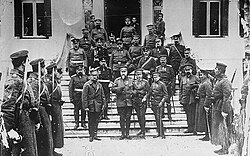 |
|
| Events leading to World War II |
|---|
The Problem of Asia (Alfred Thayer Mahan, 1900)

Alfred Thayer Mahan was an American Navy officer and president of the U.S. Naval War College. He is best known for his Influence of Sea Power upon History series of books, which argued that naval supremacy was the deciding factor in great power warfare. In 1900, Mahan's book The Problem of Asia was published. In this volume he laid out the first geostrategy of the modern era.
The Problem of Asia divides the continent of Asia into 3 zones:
- A northern zone, located above the 40th parallel north, characterized by its cold climate, and dominated by land power;
- The "Debatable and Debated" zone, located between the 40th and 30th parallels, characterized by a temperate climate; and,
- A southern zone, located below the 30th parallel north, characterized by its hot climate, and dominated by sea power.[1]
The Debated and Debatable zone, Mahan observed, contained two peninsulas on either end (Anatolia and the Korean Peninsula), the Suez Canal, Palestine, Syria, Mesopotamia, two countries marked by their mountain ranges (Iran and Afghanistan), the Pamir Mountains, the Himalayas, the Yangtze, and Japan.[1] Within this zone, Mahan asserted that there were no strong states capable of withstanding outside influence or capable even of maintaining stability within their own borders. So whereas the political situations to the north and south were relatively stable and determined, the middle remained "debatable and debated ground."[1]
North of the 40th parallel, the vast expanse of Asia was dominated by the Russian Empire. Russia possessed a central position on the continent, and a wedge-shaped projection into Central Asia, bounded by the Caucasus Mountains and Caspian Sea on one side and the mountains of Afghanistan and Western China on the other side. To prevent Russian expansionism and achievement of predominance on the Asian continent, Mahan believed pressure on Asia's flanks could be the only viable strategy pursued by sea powers.[1]
South of the 30th parallel lay areas dominated by the sea powers – the United Kingdom, the United States, Germany and Japan. To Mahan, the possession of India by the United Kingdom was of key strategic importance, as India was best suited for exerting balancing pressure against Russia in Central Asia. The United Kingdom's predominance in Egypt, China, Malaysia, Australia, Canada and South Africa was also considered important.[1]
The strategy of sea powers, according to Mahan, ought to be to deny Russia the benefits of commerce that come from sea commerce. He noted that both the Turkish Straits and Danish Straits could be closed by a hostile power, thereby denying Russia access to the sea. Further, this disadvantageous position would reinforce Russia's proclivity toward expansionism in order to obtain wealth or warm water ports.[1] Natural geographic targets for Russian expansionism in search of access to the sea would therefore be the Chinese seaboard, the Persian Gulf, and Asia Minor.[1]
In this contest between land power and sea power, Russia would find itself allied with France (a natural sea power, but in this case necessarily acting as a land power), arrayed against Germany, Britain, Japan, and the United States as sea powers.[1] Further, Mahan conceived of a unified, modern state composed of Turkey, Syria, and Mesopotamia, possessing an efficiently organized army and navy to stand as a counterweight to Russian expansion.[1]
Further dividing the map by geographic features, Mahan stated that the two most influential lines of division would be the Suez Canal and Panama Canal. As most developed nations and resources lay above the North–South divide, politics and commerce north of the two canals would be of much greater importance than those occurring south of the canals. As such, the great progress of historical development would not flow from north to south, but from east to west, in this case leading toward Asia as the locus of advance.[1]
Russian irredentism (21st century)

The Soviet Union in 1945
(Soviet territories that were never part of the Russian Empire: Tuvan ASSR, Kaliningrad Oblast and Zakarpattia, Lviv, Stanislav and Ternopil regions in west Ukraine, and southern Kurils)
Additional annexed/occupied territory from the Russian Empire (Grand Duchy of Finland and Congress Poland)
Maximum extent of the Soviet near abroad, 1955 (Warsaw Pact, Mongolian People's Republic and North Korea)
Maximum extent of the Russian Empire's sphere of influence after the sale of Alaska, in 1867, despite later Soviet attempts to restore them (Northern Iran, Xinjiang, Manchuria)
After the Dissolution of the Soviet Union in 1991, it was thought that the Russian Federation gave up on plans of territorial expansion or kin-state nationalism, despite some 25 million ethnic Russians living in neighboring countries outside Russia.[2] Stephen M. Saideman and R. William Ayres assert that Russia followed a non-irredentist policy in the 1990s despite some justifications for irredentist policies—one factor disfavoring irredentism was a focus by the ruling interest in consolidating power and the economy within the territory of Russia.[3] Furthermore, a stable policy of irredentism popular with the electorate was not found, and politicians proposing such ideas did not fare well electorally.[4] Russian nationalist politicians tended to focus on internal threats (i.e. "outsiders") rather than on the interests of Russians outside the federation.[5]
It has been proposed that the annexation of Crimea in 2014 proves Russia's adherence to irredentism today.[6][7][8][9] After the event in Crimea, the Transnistrian authorities requested Russia to annex Transnistria.[10][11][12]
The annexation of Crimea led to a new wave of Russian nationalism, with large parts of the Russian far right movement aspiring to annex even more land from Ukraine, including the unrecognized Novorossiya.[13] Vladimir Socor proposed that Vladimir Putin's speech after the annexation of Crimea was a de facto "manifesto of Greater-Russia Irredentism".[14] However, after international sanctions were imposed against Russia in early 2014, within a year the "Novorossiya" project was suspended: on 1 January 2015, the founding leadership announced the project has been put on hold, and on 20 May the constituent members announced the freezing of the political project.[15][16]
Some Russian nationalists seek to annex parts of the "near abroad", such as the Baltic states,[17] while some fear potential escalation due to Russian irredentist aspirations in northern Kazakhstan also.[18]
Warm-water port
A warm-water port (also known as an ice-free port) is one where the water does not freeze in winter. This is mainly used in the context of countries with mostly cold winters where parts of the coastline freezes over every winter. Because they are available year-round, warm-water ports can be of great geopolitical or economic interest. Such settlements as Dalian in China, Murmansk, Novorossiysk, Petropavlovsk-Kamchatsky and Vostochny Port[19] in Russia, Odessa in Ukraine, Kushiro in Japan and Valdez at the terminus of the Alaska Pipeline owe their very existence to being ice-free ports. The Baltic Sea and similar areas have ports available year-round beginning in the 20th century thanks to icebreakers, but earlier access problems prompted Russia to expand its territory to the Black Sea.
State Sponsors of Terrorism (U.S. list)
| Timeline of the "State Sponsors of Terrorism" list | ||||||||||||||||||||||||||||||||||||||||||
|---|---|---|---|---|---|---|---|---|---|---|---|---|---|---|---|---|---|---|---|---|---|---|---|---|---|---|---|---|---|---|---|---|---|---|---|---|---|---|---|---|---|---|
| 1970s | 1980s | 1990s | 2000s | 2010s | 2020s | |||||||||||||||||||||||||||||||||||||
| 9 | 0 | 1 | 2 | 3 | 4 | 5 | 6 | 7 | 8 | 9 | 0 | 1 | 2 | 3 | 4 | 5 | 6 | 7 | 8 | 9 | 0 | 1 | 2 | 3 | 4 | 5 | 6 | 7 | 8 | 9 | 0 | 1 | 2 | 3 | 4 | 5 | 6 | 7 | 8 | 9 | 0 | 1 |
Great powers by date
Timelines of the great powers since the end of the Napoleonic Wars in the early 19th century:
Superpower
The Soviet Union and the United States fulfilled the superpower criteria in the following ways:
| Demography | Had a population of 286.7 million in 1989, the third largest on Earth behind China and India.[48] | Had a population of 248.7 million in 1990, at that time the fourth largest on Earth behind China, India and the Soviet Union.[49] |
|---|---|---|
| Geography | Largest state in the world (actually a federal superstate), with a surface area of 22,270,000 km2 (8,600,000 sq mi).[48] | Third or Fourth largest country in the world, with an area of 9,630,000 km2 (3,720,000 sq mi).[50] |
| Economy | GNP of $2.7 trillion in 1990 (equivalent to $6.3 trillion in 2023). Second largest economy in the world.[51] Enormous mineral energy resources and fuel supply. Generally self-sufficient using a minimal amount of imports, although it suffered resource inadequacies such as in agriculture. Large-scale industrial production directed by centralised state organs leading to a high degree of inefficiency. Five-year plans frequently used to accomplish economic goals. Economic benefits such as guaranteed employment, free healthcare and free education provided to all levels of society. Soviet life expectancy and certain indicators of healthcare performance exceeded those of the United States, but often fell below the standards of the most developed Western European states. Economy tied to Central and Eastern-European satellite states. | GNP of $5.2 trillion in 1990 (equivalent to $12.1 trillion in 2023). Largest economy in the world.[51] Capitalist market economic theory based on supply and demand in which production was determined by customers' demands, although it also included rising income inequality since 1979.[52] Enormous industrial base and a large and modernized farming industry. Large volume of imports and exports. Large resources of minerals, energy resources, metals and timber. High standard of living with accessibility to many manufactured goods. Home to a multitude of the largest global corporations. United States dollar served as the dominant world reserve currency under Bretton Woods Conference. Allied with G7 major economies. Supported allied countries' economies via such programmes as the Marshall Plan. |
| Politics | Strong Marxist–Leninist state with extensive secret police apparatus, organized under a quasi-parliamentary system with strong fusion of powers, with checks and balances for both the executive and the judiciary primarily based on commanding the legislature's confidence. The Supreme Soviet enjoyed de facto parliamentary sovereignty despite a written constitution and nominal federalism as no court was vested with judicial review. As no formal office of President has existed, the standing legislature also served as a collective head of state. The only national-level popular elections were the quinquennial elections to the Supreme Soviet which were yes-or-no votes on candidates handpicked beforehand. However, radical government reforms in 1989 introduced competitive elections, a directly elected executive President and a Constitutional Court, both having rudimentary separation of powers from the existing components of the system. One-party system with the Communist Party having an institutionalized monopoly of power. Permanent seat on the United Nations Security Council. | Strong liberal constitutional republic, organized under a presidential system with strong separation of powers, with a complicated system of checks and balances exercised between the legislature, the executive and the judiciary. The legislative powers of the United States Congress were limited both by the written constitution and by the federal nature of the national government. Despite the lack of a dedicated Constitutional Court, judicial review of laws has been vested in the Supreme Court by judicial precedent. The President was both head of state and head of government and his cabinet was not required to command congressional confidence. The only national popular elections were the biennial congressional elections. However. the quadrennial presidential election has de facto changed from an indirect election by an Electoral College into a direct, although weighted, popular election. Two-party system between Democrats and Republicans. Permanent seat on the United Nations Security Council along with two allies (France and the United Kingdom). |
| Foreign relations | Strong ties with Central and Eastern Europe, countries in Latin America, Southeast Asia, Africa, Syria, Iraq (until 1991) and Cuba. Also had an Sino-Soviet alliance with China up until 1961. Supported Marxist–Leninist countries around the world. | Strong ties with Western Europe, some countries in Latin America, the Commonwealth of Nations, several East Asian countries and Israel. Supported liberal democracies and anti-communist dictatorships around the world. |
| Military | Possessed largest armed forces and air force in the world and the second largest navy. Possessed bases around the world. Held the world's largest stockpile of nuclear weapons for the second half of the Cold War. Founder of Warsaw Pact with satellite states in Central and Eastern Europe. Global intelligence network with the GRU and the First Chief Directorate of the KGB. Ties with paramilitary and guerrilla groups in the developing world. Large arms industry production with global distribution. | Highest military expenditure in the world,[53] with the world's largest navy surpassing the next 13 largest navies combined[54][55] and an army and air force rivaled only by that of the Soviet Union. Possessed bases around the world, particularly in an incomplete ring bordering the Warsaw Pact to the West, South and East. Largest nuclear arsenal in the world during the first half of the Cold War. Powerful military allies in Western Europe with their own nuclear capabilities. Global intelligence networks with the Intelligence Community. Ties with paramilitary and guerrilla groups in the developing world. Large armament production through defense contractors along with its developed allies for the global market. |
| Media | Constitutional guarantees for freedom of speech and freedom of the press were made conditional both for fulfilling one's citizen's duties and for conformity with the interests of the government, thereby turning them into effective dead letters. Press explicitly controlled and censored. Promoted through the use of propaganda its socialist ideal that workers of all countries should unite to overthrow capitalist society and what they called the dictatorship of the bourgeoisie and replace it with a socialist society where all means of production are publicly owned. | Maintained constitutional guarantees for freedom of speech and freedom of the press, although the ongoing Cold War did lead to a degree of censorship, particularly during the Vietnam War and the Second Red Scare when censorship was the heaviest. |
| Culture | Rich tradition in literature, film, classical music and ballet. | Rich tradition and worldwide cultural influence in music, literature, film, television, cuisine, art and fashion. |
Soviet Union and United States comparison
Service Awards



Cite error: There are <ref group=nb> tags on this page, but the references will not show without a {{reflist|group=nb}} template (see the help page).














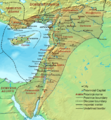
































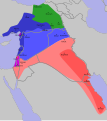




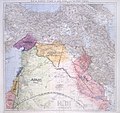







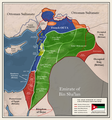










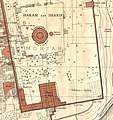




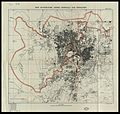
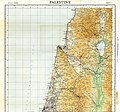








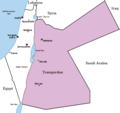








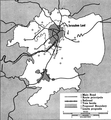
























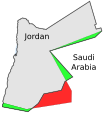








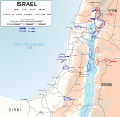









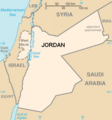









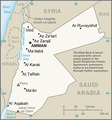
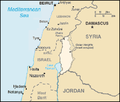


















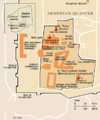















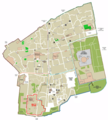










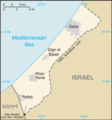









































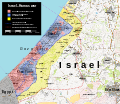











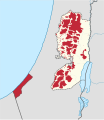


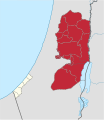






















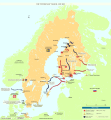


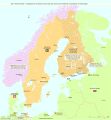






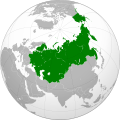















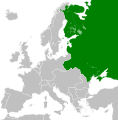











































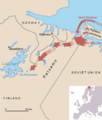




















































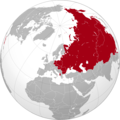

















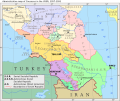
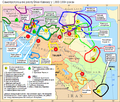























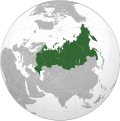

































































































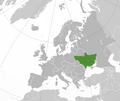



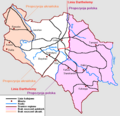






















































































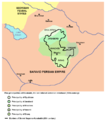


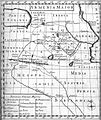
















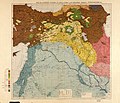






















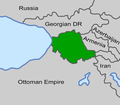
























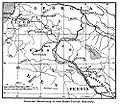














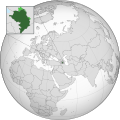

















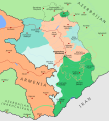


































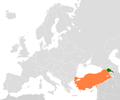


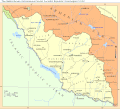



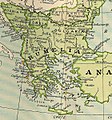


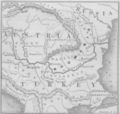




















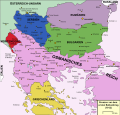
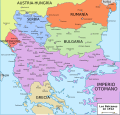




































































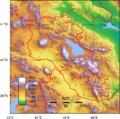














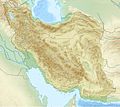




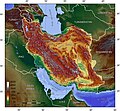



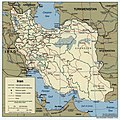



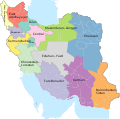
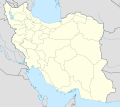


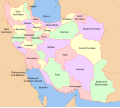




























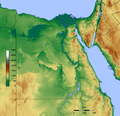




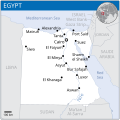








































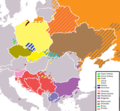
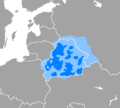




























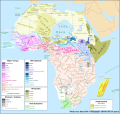































































































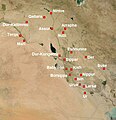















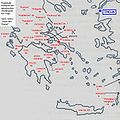

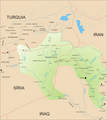






















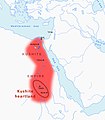












































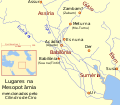
































































































































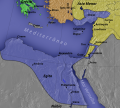






















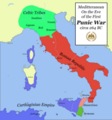





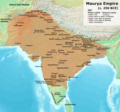
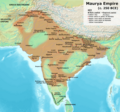
























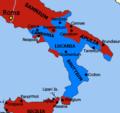


















































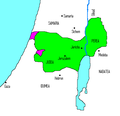







































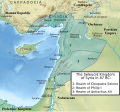























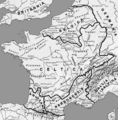



















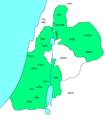





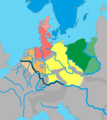






















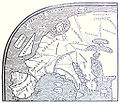



















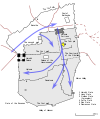




























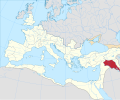
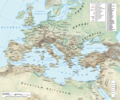







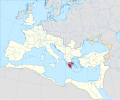
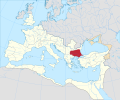





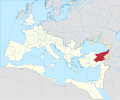


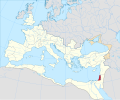
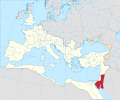















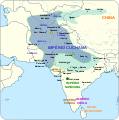










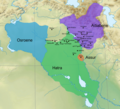



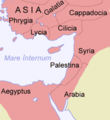






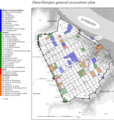








































































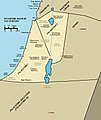



















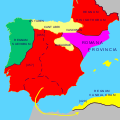

































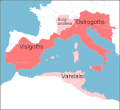























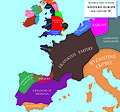















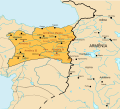
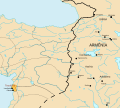





















![Kingdom of the Suebi (409-585 AD), Visigothic Kingdom (418-721 AD), Francia (481-843 AD), Ostrogothic Kingdom (469/493-553 AD), Vandal Kingdom (435-534 AD), Kingdom of the Lombards]] (568-774 AD), Avar Khaganate (567-822 AD), Byzantine Empire (286/395–1453 AD) and Sasanian Empire (224–651 AD) in 526-600 AD.](http://upload.wikimedia.org/wikipedia/commons/thumb/5/53/Shepherd_526-600.jpg/73px-Shepherd_526-600.jpg)
![Kingdom of the Suebi (409-585 AD), Visigothic Kingdom (418-721 AD), Francia (481-843 AD), Ostrogothic Kingdom (469/493-553 AD), Vandal Kingdom (435-534 AD), Kingdom of the Lombards]] (568-774 AD), Avar Khaganate (567-822 AD), Byzantine Empire (286/395–1453 AD) and Sasanian Empire (224–651 AD) in 526-600 AD.](http://upload.wikimedia.org/wikipedia/commons/thumb/b/b1/Europe_526-600.jpg/76px-Europe_526-600.jpg)



















